Childcare Health Assessment Tasks and Requirements
VerifiedAdded on 2023/06/18
|61
|10814
|105
AI Summary
This article discusses the requirements and tasks of Childcare Health Assessment, including written questions, case studies, and simulations. It covers strategies to prevent infections, medical management plans, and safety issues in early childhood environments. The article also includes specific information on dealing with children with medical conditions and creating a safe environment for them.
Contribute Materials
Your contribution can guide someone’s learning journey. Share your
documents today.

Secure Best Marks with AI Grader
Need help grading? Try our AI Grader for instant feedback on your assignments.

Assessment Tasks
You are required to complete three parts in this assessment.
Please note that in addition to completion of the above tasks, to achieve competency,
you will need to complete the required work placement terms and associated Logbooks.
Assessment Plan
The due dates for each task are listed below:
Assessment Task
PART A: Written Questions
PART B: Case Studies
PART C: Simulations
Assessment Task Requirements of Task
PART A: Written
questions
You must correctly answer all questions to
show that you understand the knowledge
required for these units.
PART B: Case studies You are required to read case studies and
complete a series of short answer questions for
each.
PART C: Simulations You are required to be assessed on the
simulations within each assessment
You are required to complete three parts in this assessment.
Please note that in addition to completion of the above tasks, to achieve competency,
you will need to complete the required work placement terms and associated Logbooks.
Assessment Plan
The due dates for each task are listed below:
Assessment Task
PART A: Written Questions
PART B: Case Studies
PART C: Simulations
Assessment Task Requirements of Task
PART A: Written
questions
You must correctly answer all questions to
show that you understand the knowledge
required for these units.
PART B: Case studies You are required to read case studies and
complete a series of short answer questions for
each.
PART C: Simulations You are required to be assessed on the
simulations within each assessment
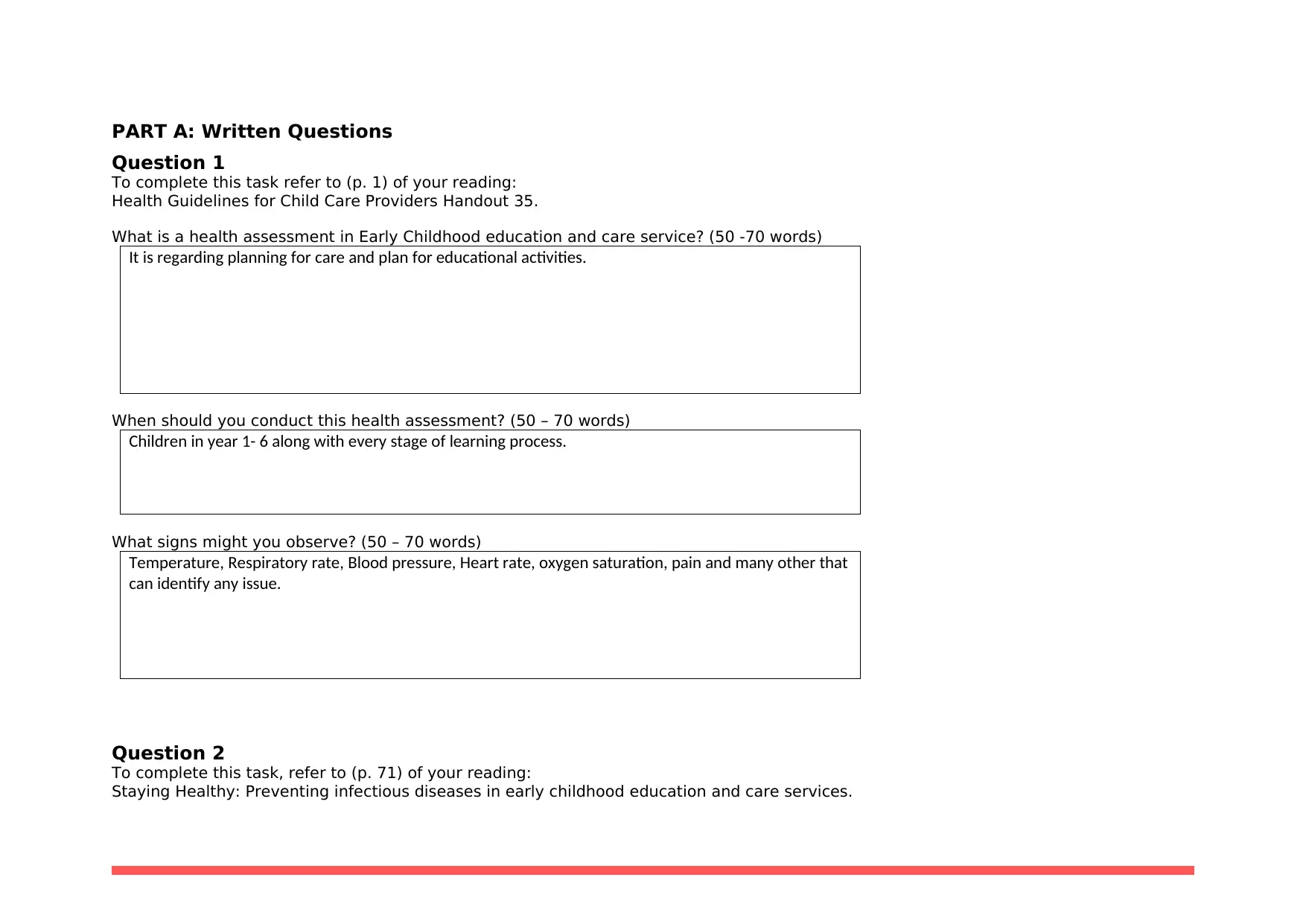
PART A: Written Questions
Question 1
To complete this task refer to (p. 1) of your reading:
Health Guidelines for Child Care Providers Handout 35.
What is a health assessment in Early Childhood education and care service? (50 -70 words)
It is regarding planning for care and plan for educational activities.
When should you conduct this health assessment? (50 – 70 words)
Children in year 1- 6 along with every stage of learning process.
What signs might you observe? (50 – 70 words)
Temperature, Respiratory rate, Blood pressure, Heart rate, oxygen saturation, pain and many other that
can identify any issue.
Question 2
To complete this task, refer to (p. 71) of your reading:
Staying Healthy: Preventing infectious diseases in early childhood education and care services.
Question 1
To complete this task refer to (p. 1) of your reading:
Health Guidelines for Child Care Providers Handout 35.
What is a health assessment in Early Childhood education and care service? (50 -70 words)
It is regarding planning for care and plan for educational activities.
When should you conduct this health assessment? (50 – 70 words)
Children in year 1- 6 along with every stage of learning process.
What signs might you observe? (50 – 70 words)
Temperature, Respiratory rate, Blood pressure, Heart rate, oxygen saturation, pain and many other that
can identify any issue.
Question 2
To complete this task, refer to (p. 71) of your reading:
Staying Healthy: Preventing infectious diseases in early childhood education and care services.
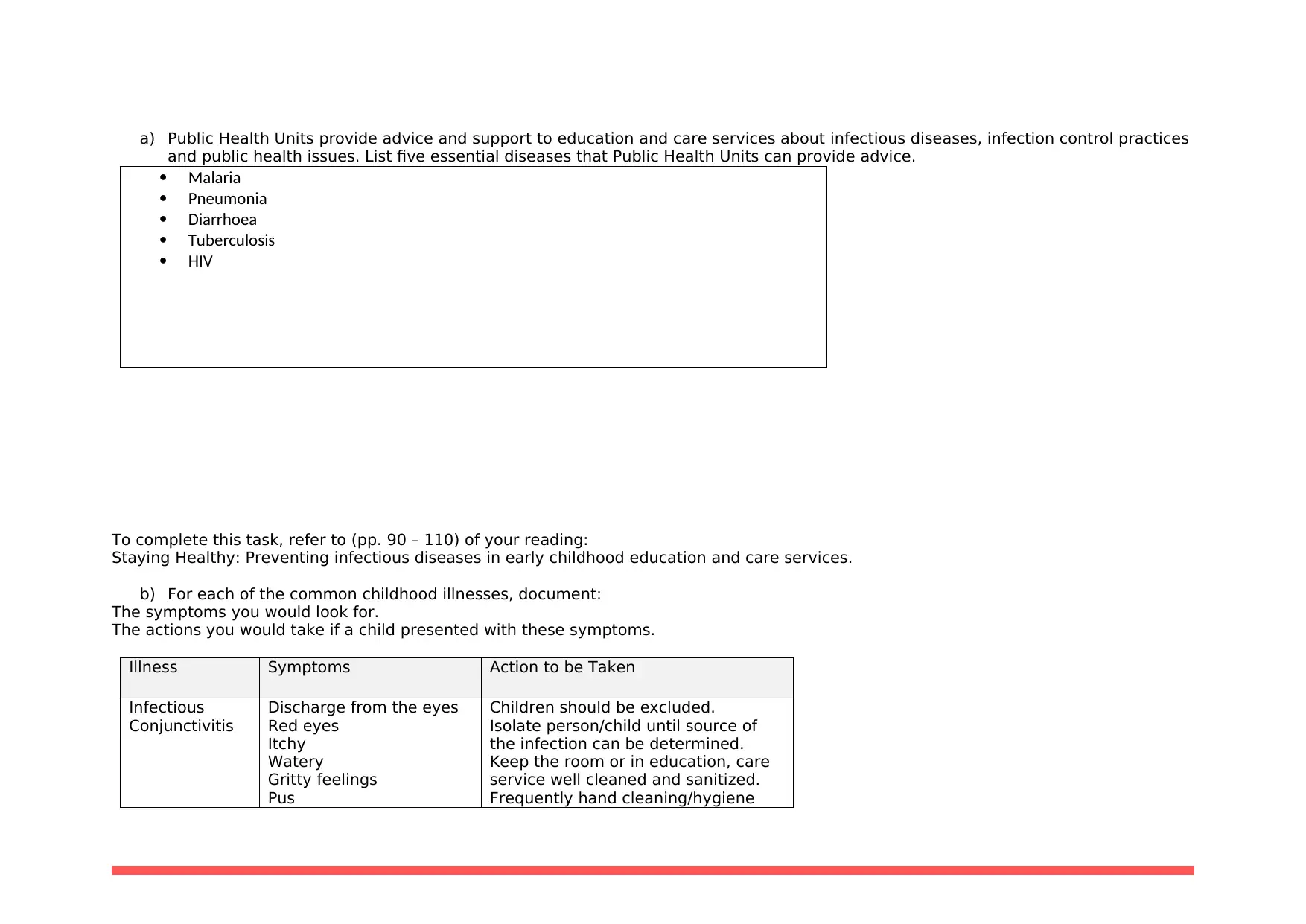
a) Public Health Units provide advice and support to education and care services about infectious diseases, infection control practices
and public health issues. List five essential diseases that Public Health Units can provide advice.
Malaria
Pneumonia
Diarrhoea
Tuberculosis
HIV
To complete this task, refer to (pp. 90 – 110) of your reading:
Staying Healthy: Preventing infectious diseases in early childhood education and care services.
b) For each of the common childhood illnesses, document:
The symptoms you would look for.
The actions you would take if a child presented with these symptoms.
Illness Symptoms Action to be Taken
Infectious
Conjunctivitis
Discharge from the eyes
Red eyes
Itchy
Watery
Gritty feelings
Pus
Children should be excluded.
Isolate person/child until source of
the infection can be determined.
Keep the room or in education, care
service well cleaned and sanitized.
Frequently hand cleaning/hygiene
and public health issues. List five essential diseases that Public Health Units can provide advice.
Malaria
Pneumonia
Diarrhoea
Tuberculosis
HIV
To complete this task, refer to (pp. 90 – 110) of your reading:
Staying Healthy: Preventing infectious diseases in early childhood education and care services.
b) For each of the common childhood illnesses, document:
The symptoms you would look for.
The actions you would take if a child presented with these symptoms.
Illness Symptoms Action to be Taken
Infectious
Conjunctivitis
Discharge from the eyes
Red eyes
Itchy
Watery
Gritty feelings
Pus
Children should be excluded.
Isolate person/child until source of
the infection can be determined.
Keep the room or in education, care
service well cleaned and sanitized.
Frequently hand cleaning/hygiene
Secure Best Marks with AI Grader
Need help grading? Try our AI Grader for instant feedback on your assignments.
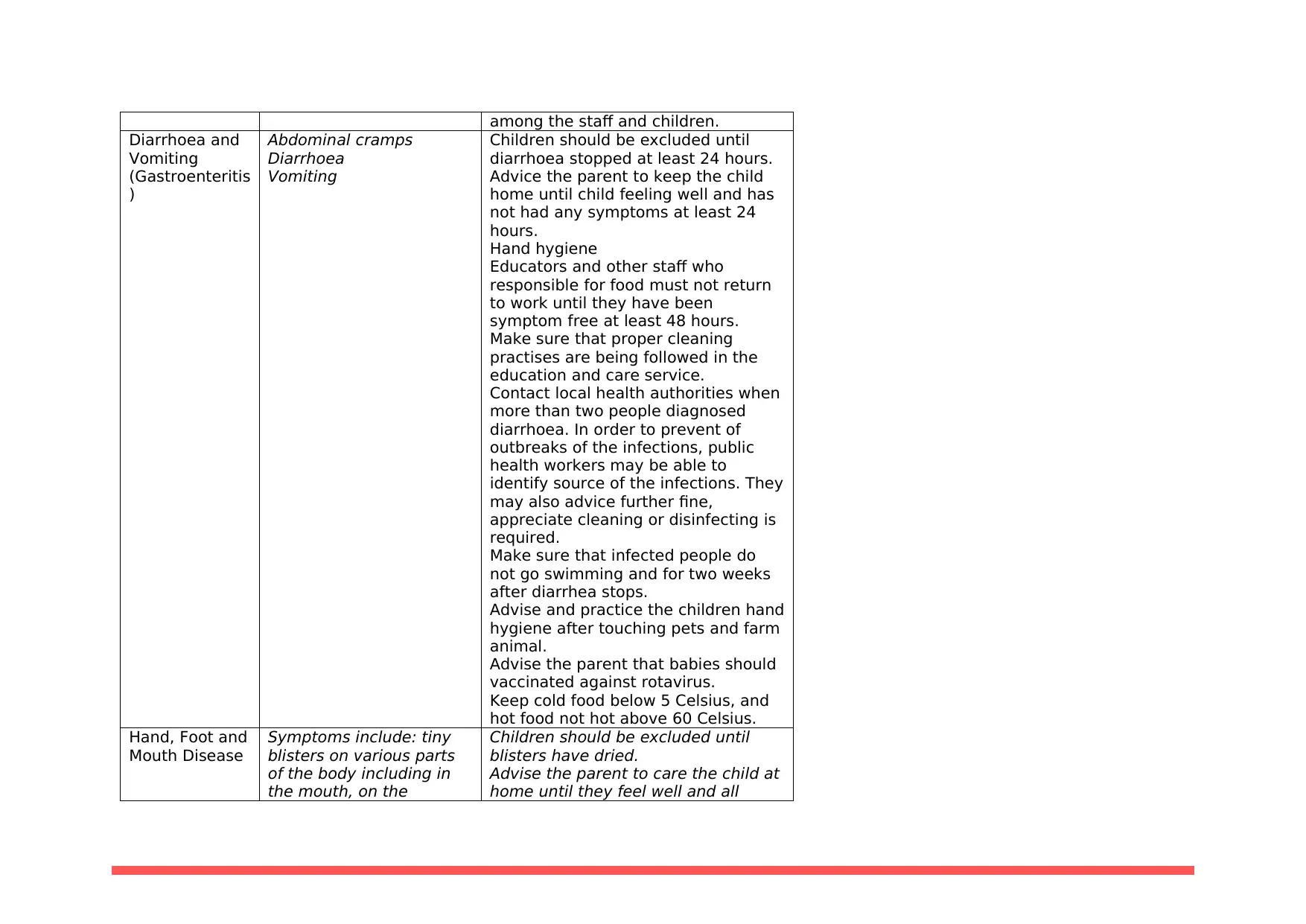
among the staff and children.
Diarrhoea and
Vomiting
(Gastroenteritis
)
Abdominal cramps
Diarrhoea
Vomiting
Children should be excluded until
diarrhoea stopped at least 24 hours.
Advice the parent to keep the child
home until child feeling well and has
not had any symptoms at least 24
hours.
Hand hygiene
Educators and other staff who
responsible for food must not return
to work until they have been
symptom free at least 48 hours.
Make sure that proper cleaning
practises are being followed in the
education and care service.
Contact local health authorities when
more than two people diagnosed
diarrhoea. In order to prevent of
outbreaks of the infections, public
health workers may be able to
identify source of the infections. They
may also advice further fine,
appreciate cleaning or disinfecting is
required.
Make sure that infected people do
not go swimming and for two weeks
after diarrhea stops.
Advise and practice the children hand
hygiene after touching pets and farm
animal.
Advise the parent that babies should
vaccinated against rotavirus.
Keep cold food below 5 Celsius, and
hot food not hot above 60 Celsius.
Hand, Foot and
Mouth Disease
Symptoms include: tiny
blisters on various parts
of the body including in
the mouth, on the
Children should be excluded until
blisters have dried.
Advise the parent to care the child at
home until they feel well and all
Diarrhoea and
Vomiting
(Gastroenteritis
)
Abdominal cramps
Diarrhoea
Vomiting
Children should be excluded until
diarrhoea stopped at least 24 hours.
Advice the parent to keep the child
home until child feeling well and has
not had any symptoms at least 24
hours.
Hand hygiene
Educators and other staff who
responsible for food must not return
to work until they have been
symptom free at least 48 hours.
Make sure that proper cleaning
practises are being followed in the
education and care service.
Contact local health authorities when
more than two people diagnosed
diarrhoea. In order to prevent of
outbreaks of the infections, public
health workers may be able to
identify source of the infections. They
may also advice further fine,
appreciate cleaning or disinfecting is
required.
Make sure that infected people do
not go swimming and for two weeks
after diarrhea stops.
Advise and practice the children hand
hygiene after touching pets and farm
animal.
Advise the parent that babies should
vaccinated against rotavirus.
Keep cold food below 5 Celsius, and
hot food not hot above 60 Celsius.
Hand, Foot and
Mouth Disease
Symptoms include: tiny
blisters on various parts
of the body including in
the mouth, on the
Children should be excluded until
blisters have dried.
Advise the parent to care the child at
home until they feel well and all
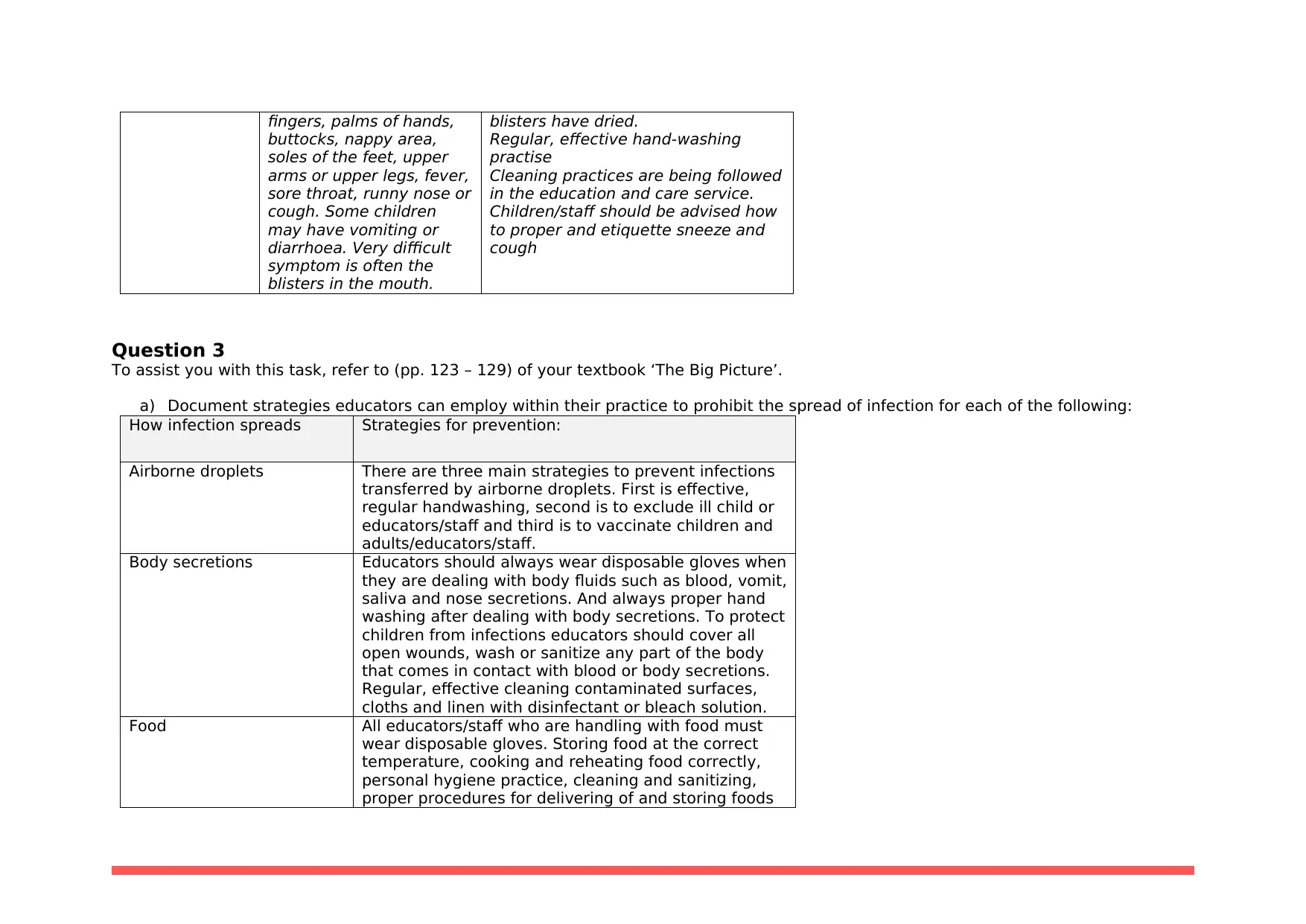
fingers, palms of hands,
buttocks, nappy area,
soles of the feet, upper
arms or upper legs, fever,
sore throat, runny nose or
cough. Some children
may have vomiting or
diarrhoea. Very difficult
symptom is often the
blisters in the mouth.
blisters have dried.
Regular, effective hand-washing
practise
Cleaning practices are being followed
in the education and care service.
Children/staff should be advised how
to proper and etiquette sneeze and
cough
Question 3
To assist you with this task, refer to (pp. 123 – 129) of your textbook ‘The Big Picture’.
a) Document strategies educators can employ within their practice to prohibit the spread of infection for each of the following:
How infection spreads Strategies for prevention:
Airborne droplets There are three main strategies to prevent infections
transferred by airborne droplets. First is effective,
regular handwashing, second is to exclude ill child or
educators/staff and third is to vaccinate children and
adults/educators/staff.
Body secretions Educators should always wear disposable gloves when
they are dealing with body fluids such as blood, vomit,
saliva and nose secretions. And always proper hand
washing after dealing with body secretions. To protect
children from infections educators should cover all
open wounds, wash or sanitize any part of the body
that comes in contact with blood or body secretions.
Regular, effective cleaning contaminated surfaces,
cloths and linen with disinfectant or bleach solution.
Food All educators/staff who are handling with food must
wear disposable gloves. Storing food at the correct
temperature, cooking and reheating food correctly,
personal hygiene practice, cleaning and sanitizing,
proper procedures for delivering of and storing foods
buttocks, nappy area,
soles of the feet, upper
arms or upper legs, fever,
sore throat, runny nose or
cough. Some children
may have vomiting or
diarrhoea. Very difficult
symptom is often the
blisters in the mouth.
blisters have dried.
Regular, effective hand-washing
practise
Cleaning practices are being followed
in the education and care service.
Children/staff should be advised how
to proper and etiquette sneeze and
cough
Question 3
To assist you with this task, refer to (pp. 123 – 129) of your textbook ‘The Big Picture’.
a) Document strategies educators can employ within their practice to prohibit the spread of infection for each of the following:
How infection spreads Strategies for prevention:
Airborne droplets There are three main strategies to prevent infections
transferred by airborne droplets. First is effective,
regular handwashing, second is to exclude ill child or
educators/staff and third is to vaccinate children and
adults/educators/staff.
Body secretions Educators should always wear disposable gloves when
they are dealing with body fluids such as blood, vomit,
saliva and nose secretions. And always proper hand
washing after dealing with body secretions. To protect
children from infections educators should cover all
open wounds, wash or sanitize any part of the body
that comes in contact with blood or body secretions.
Regular, effective cleaning contaminated surfaces,
cloths and linen with disinfectant or bleach solution.
Food All educators/staff who are handling with food must
wear disposable gloves. Storing food at the correct
temperature, cooking and reheating food correctly,
personal hygiene practice, cleaning and sanitizing,
proper procedures for delivering of and storing foods
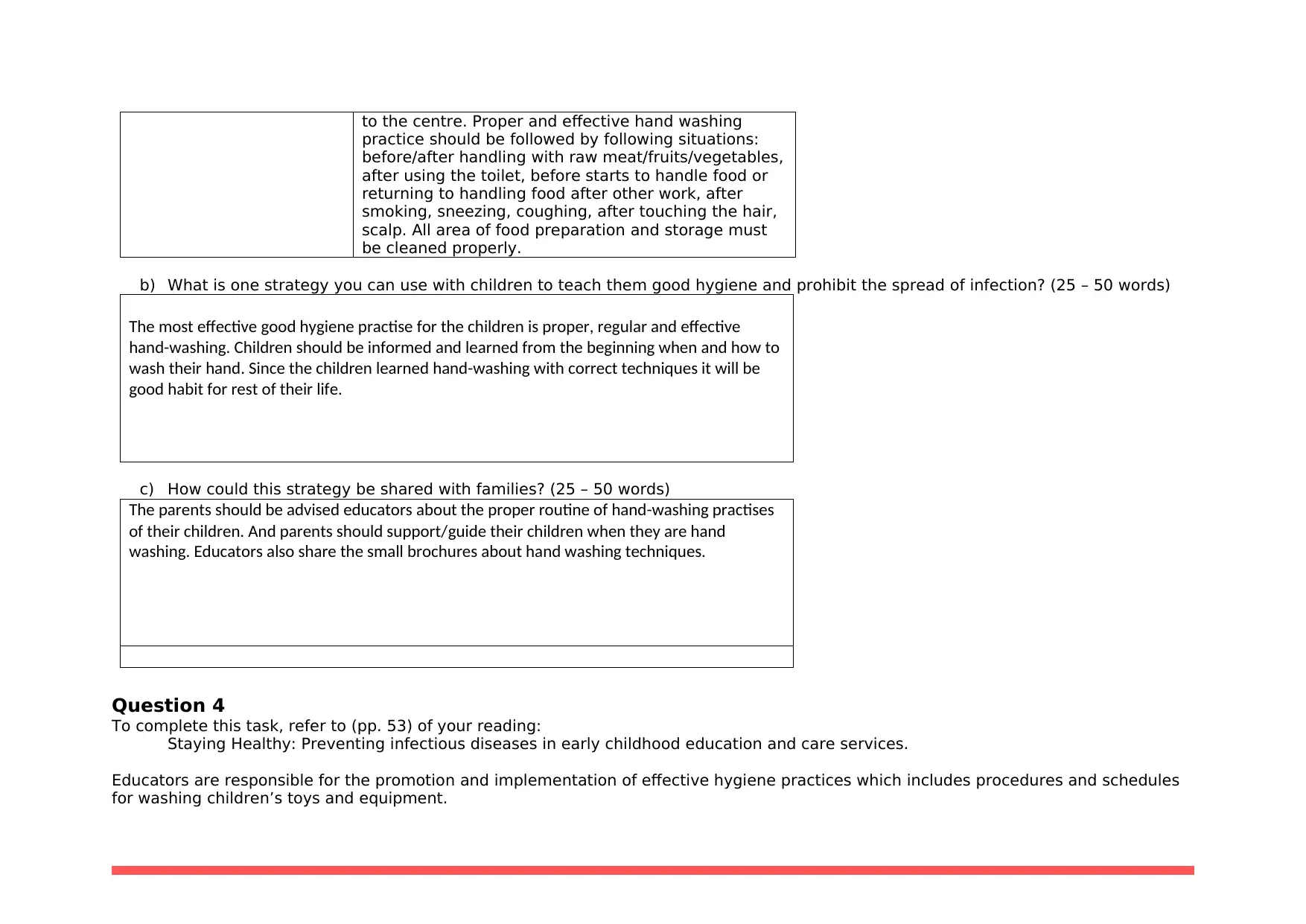
to the centre. Proper and effective hand washing
practice should be followed by following situations:
before/after handling with raw meat/fruits/vegetables,
after using the toilet, before starts to handle food or
returning to handling food after other work, after
smoking, sneezing, coughing, after touching the hair,
scalp. All area of food preparation and storage must
be cleaned properly.
b) What is one strategy you can use with children to teach them good hygiene and prohibit the spread of infection? (25 – 50 words)
The most effective good hygiene practise for the children is proper, regular and effective
hand-washing. Children should be informed and learned from the beginning when and how to
wash their hand. Since the children learned hand-washing with correct techniques it will be
good habit for rest of their life.
c) How could this strategy be shared with families? (25 – 50 words)
The parents should be advised educators about the proper routine of hand-washing practises
of their children. And parents should support/guide their children when they are hand
washing. Educators also share the small brochures about hand washing techniques.
Question 4
To complete this task, refer to (pp. 53) of your reading:
Staying Healthy: Preventing infectious diseases in early childhood education and care services.
Educators are responsible for the promotion and implementation of effective hygiene practices which includes procedures and schedules
for washing children’s toys and equipment.
practice should be followed by following situations:
before/after handling with raw meat/fruits/vegetables,
after using the toilet, before starts to handle food or
returning to handling food after other work, after
smoking, sneezing, coughing, after touching the hair,
scalp. All area of food preparation and storage must
be cleaned properly.
b) What is one strategy you can use with children to teach them good hygiene and prohibit the spread of infection? (25 – 50 words)
The most effective good hygiene practise for the children is proper, regular and effective
hand-washing. Children should be informed and learned from the beginning when and how to
wash their hand. Since the children learned hand-washing with correct techniques it will be
good habit for rest of their life.
c) How could this strategy be shared with families? (25 – 50 words)
The parents should be advised educators about the proper routine of hand-washing practises
of their children. And parents should support/guide their children when they are hand
washing. Educators also share the small brochures about hand washing techniques.
Question 4
To complete this task, refer to (pp. 53) of your reading:
Staying Healthy: Preventing infectious diseases in early childhood education and care services.
Educators are responsible for the promotion and implementation of effective hygiene practices which includes procedures and schedules
for washing children’s toys and equipment.
Paraphrase This Document
Need a fresh take? Get an instant paraphrase of this document with our AI Paraphraser
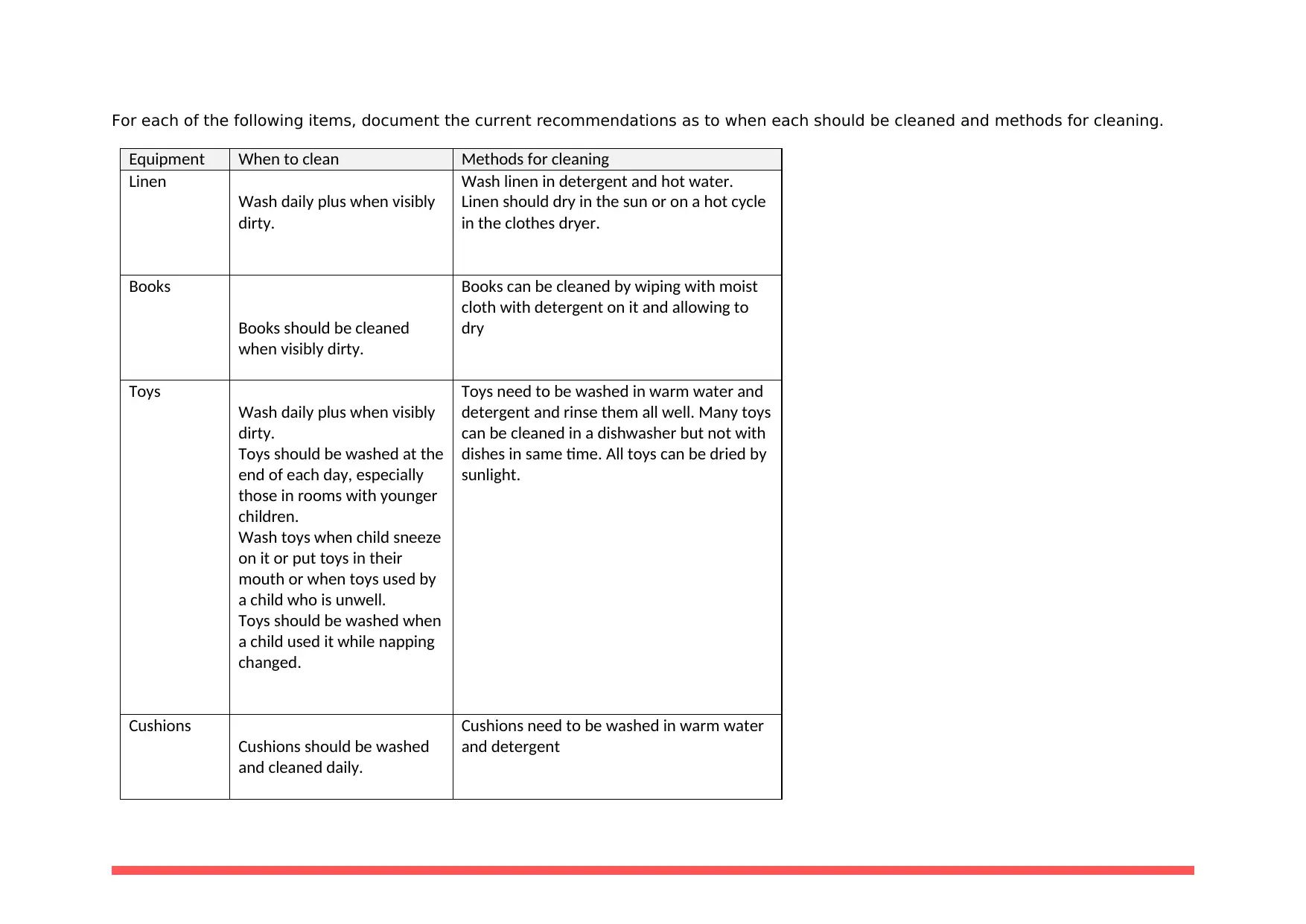
For each of the following items, document the current recommendations as to when each should be cleaned and methods for cleaning.
Equipment When to clean Methods for cleaning
Linen
Wash daily plus when visibly
dirty.
Wash linen in detergent and hot water.
Linen should dry in the sun or on a hot cycle
in the clothes dryer.
Books
Books should be cleaned
when visibly dirty.
Books can be cleaned by wiping with moist
cloth with detergent on it and allowing to
dry
Toys
Wash daily plus when visibly
dirty.
Toys should be washed at the
end of each day, especially
those in rooms with younger
children.
Wash toys when child sneeze
on it or put toys in their
mouth or when toys used by
a child who is unwell.
Toys should be washed when
a child used it while napping
changed.
Toys need to be washed in warm water and
detergent and rinse them all well. Many toys
can be cleaned in a dishwasher but not with
dishes in same time. All toys can be dried by
sunlight.
Cushions
Cushions should be washed
and cleaned daily.
Cushions need to be washed in warm water
and detergent
Equipment When to clean Methods for cleaning
Linen
Wash daily plus when visibly
dirty.
Wash linen in detergent and hot water.
Linen should dry in the sun or on a hot cycle
in the clothes dryer.
Books
Books should be cleaned
when visibly dirty.
Books can be cleaned by wiping with moist
cloth with detergent on it and allowing to
dry
Toys
Wash daily plus when visibly
dirty.
Toys should be washed at the
end of each day, especially
those in rooms with younger
children.
Wash toys when child sneeze
on it or put toys in their
mouth or when toys used by
a child who is unwell.
Toys should be washed when
a child used it while napping
changed.
Toys need to be washed in warm water and
detergent and rinse them all well. Many toys
can be cleaned in a dishwasher but not with
dishes in same time. All toys can be dried by
sunlight.
Cushions
Cushions should be washed
and cleaned daily.
Cushions need to be washed in warm water
and detergent
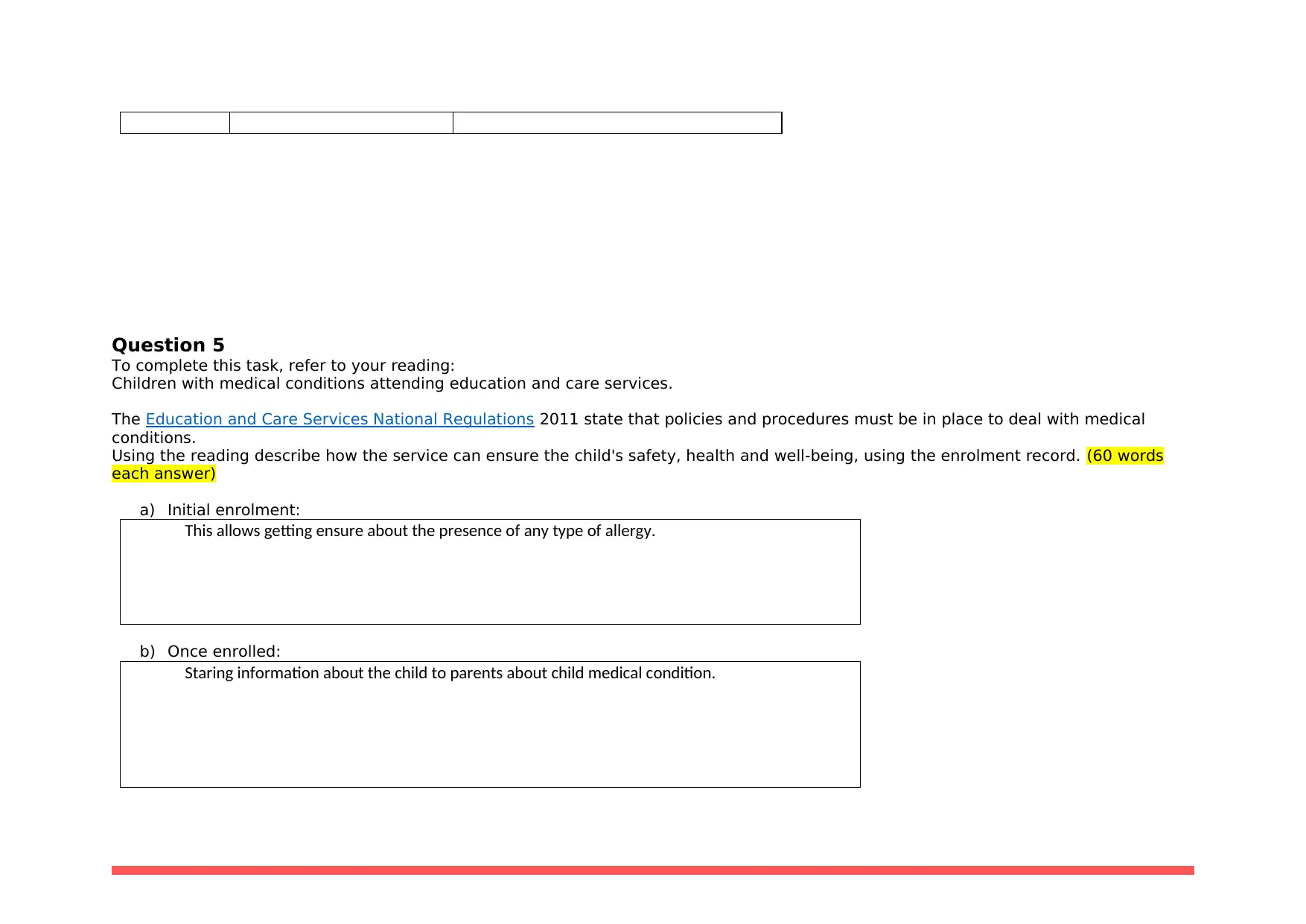
Question 5
To complete this task, refer to your reading:
Children with medical conditions attending education and care services.
The Education and Care Services National Regulations 2011 state that policies and procedures must be in place to deal with medical
conditions.
Using the reading describe how the service can ensure the child's safety, health and well-being, using the enrolment record. (60 words
each answer)
a) Initial enrolment:
This allows getting ensure about the presence of any type of allergy.
b) Once enrolled:
Staring information about the child to parents about child medical condition.
To complete this task, refer to your reading:
Children with medical conditions attending education and care services.
The Education and Care Services National Regulations 2011 state that policies and procedures must be in place to deal with medical
conditions.
Using the reading describe how the service can ensure the child's safety, health and well-being, using the enrolment record. (60 words
each answer)
a) Initial enrolment:
This allows getting ensure about the presence of any type of allergy.
b) Once enrolled:
Staring information about the child to parents about child medical condition.
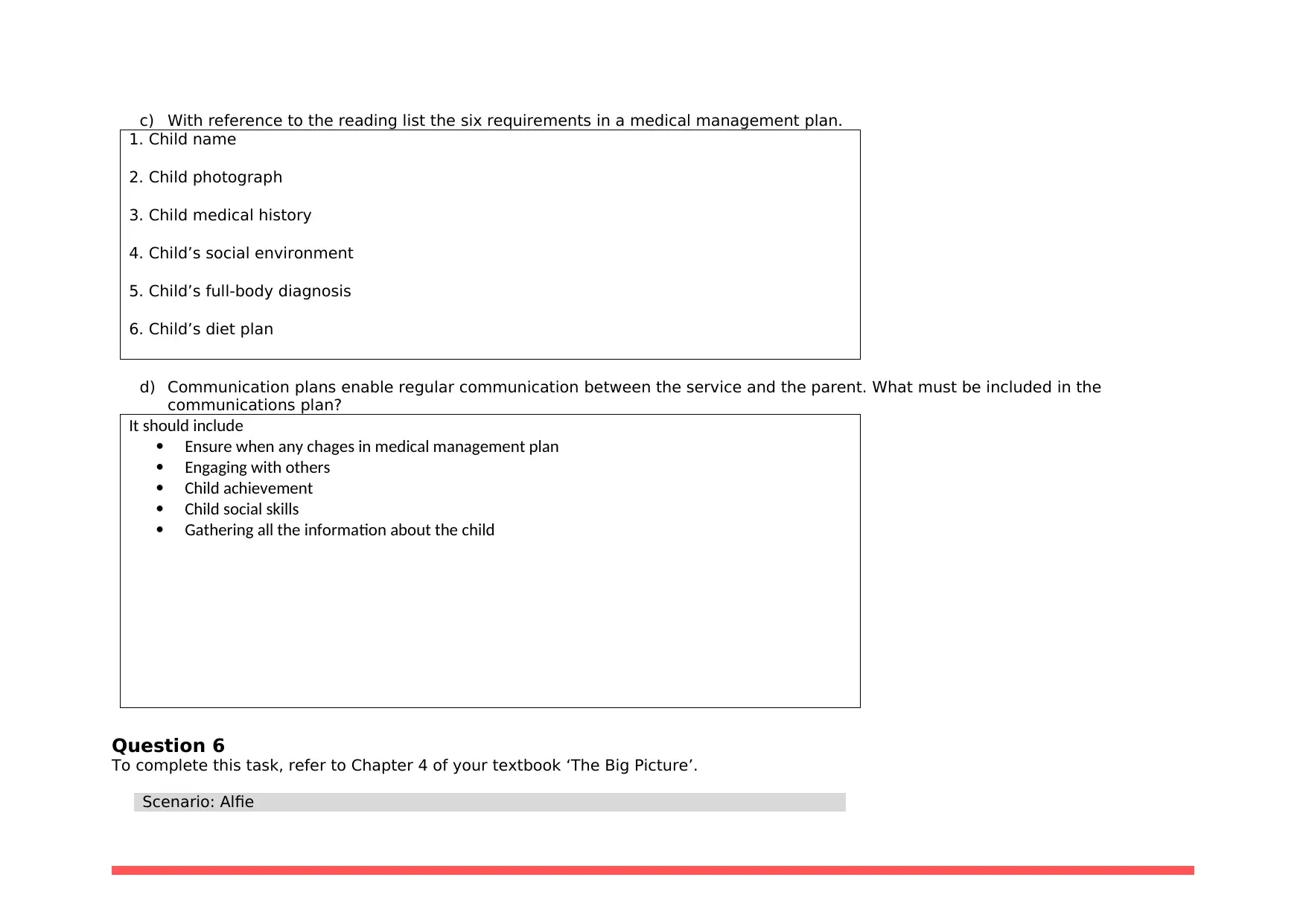
c) With reference to the reading list the six requirements in a medical management plan.
1. Child name
2. Child photograph
3. Child medical history
4. Child’s social environment
5. Child’s full-body diagnosis
6. Child’s diet plan
d) Communication plans enable regular communication between the service and the parent. What must be included in the
communications plan?
It should include
Ensure when any chages in medical management plan
Engaging with others
Child achievement
Child social skills
Gathering all the information about the child
Question 6
To complete this task, refer to Chapter 4 of your textbook ‘The Big Picture’.
Scenario: Alfie
1. Child name
2. Child photograph
3. Child medical history
4. Child’s social environment
5. Child’s full-body diagnosis
6. Child’s diet plan
d) Communication plans enable regular communication between the service and the parent. What must be included in the
communications plan?
It should include
Ensure when any chages in medical management plan
Engaging with others
Child achievement
Child social skills
Gathering all the information about the child
Question 6
To complete this task, refer to Chapter 4 of your textbook ‘The Big Picture’.
Scenario: Alfie
Secure Best Marks with AI Grader
Need help grading? Try our AI Grader for instant feedback on your assignments.
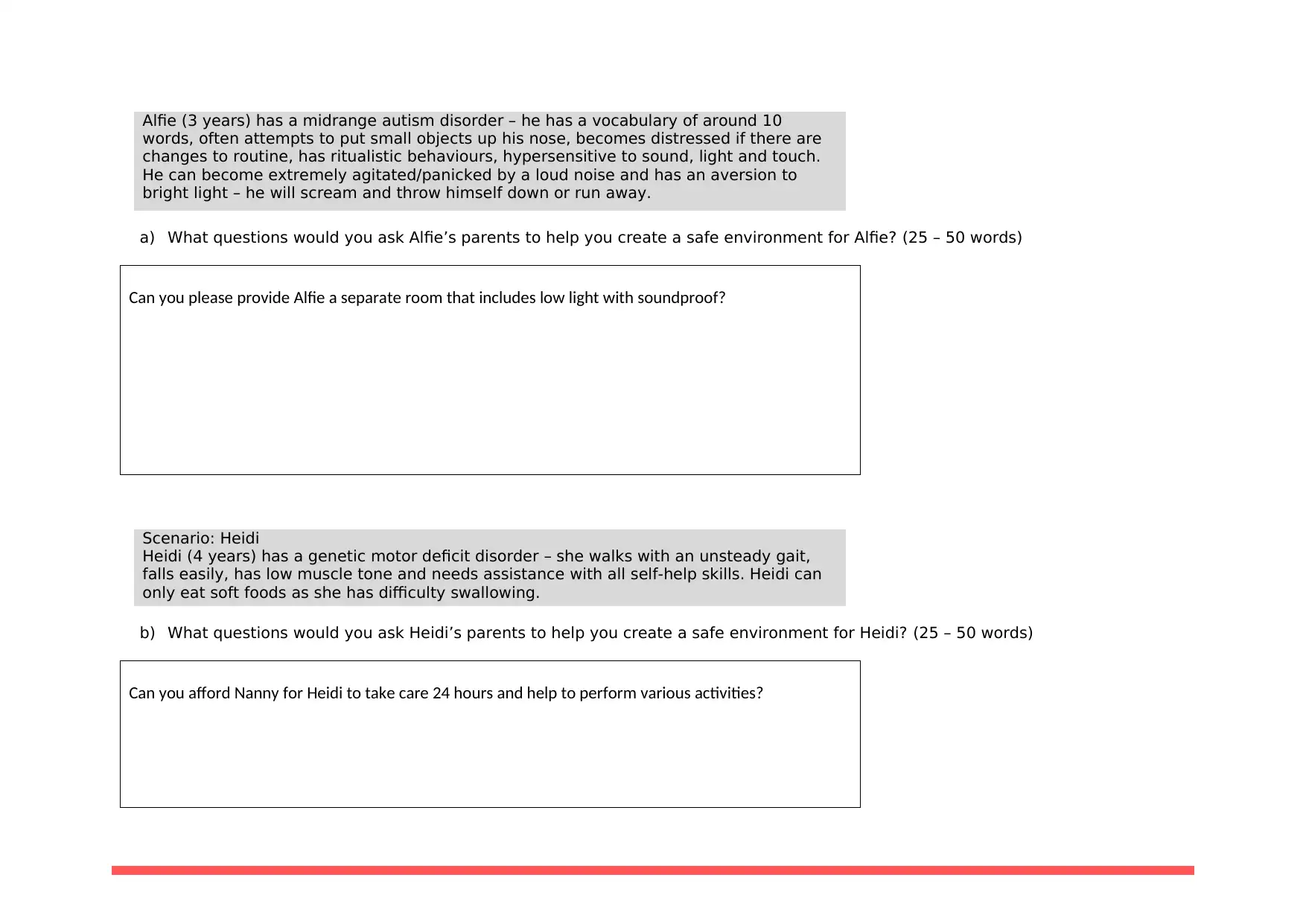
Alfie (3 years) has a midrange autism disorder – he has a vocabulary of around 10
words, often attempts to put small objects up his nose, becomes distressed if there are
changes to routine, has ritualistic behaviours, hypersensitive to sound, light and touch.
He can become extremely agitated/panicked by a loud noise and has an aversion to
bright light – he will scream and throw himself down or run away.
a) What questions would you ask Alfie’s parents to help you create a safe environment for Alfie? (25 – 50 words)
Can you please provide Alfie a separate room that includes low light with soundproof?
Scenario: Heidi
Heidi (4 years) has a genetic motor deficit disorder – she walks with an unsteady gait,
falls easily, has low muscle tone and needs assistance with all self-help skills. Heidi can
only eat soft foods as she has difficulty swallowing.
b) What questions would you ask Heidi’s parents to help you create a safe environment for Heidi? (25 – 50 words)
Can you afford Nanny for Heidi to take care 24 hours and help to perform various activities?
words, often attempts to put small objects up his nose, becomes distressed if there are
changes to routine, has ritualistic behaviours, hypersensitive to sound, light and touch.
He can become extremely agitated/panicked by a loud noise and has an aversion to
bright light – he will scream and throw himself down or run away.
a) What questions would you ask Alfie’s parents to help you create a safe environment for Alfie? (25 – 50 words)
Can you please provide Alfie a separate room that includes low light with soundproof?
Scenario: Heidi
Heidi (4 years) has a genetic motor deficit disorder – she walks with an unsteady gait,
falls easily, has low muscle tone and needs assistance with all self-help skills. Heidi can
only eat soft foods as she has difficulty swallowing.
b) What questions would you ask Heidi’s parents to help you create a safe environment for Heidi? (25 – 50 words)
Can you afford Nanny for Heidi to take care 24 hours and help to perform various activities?
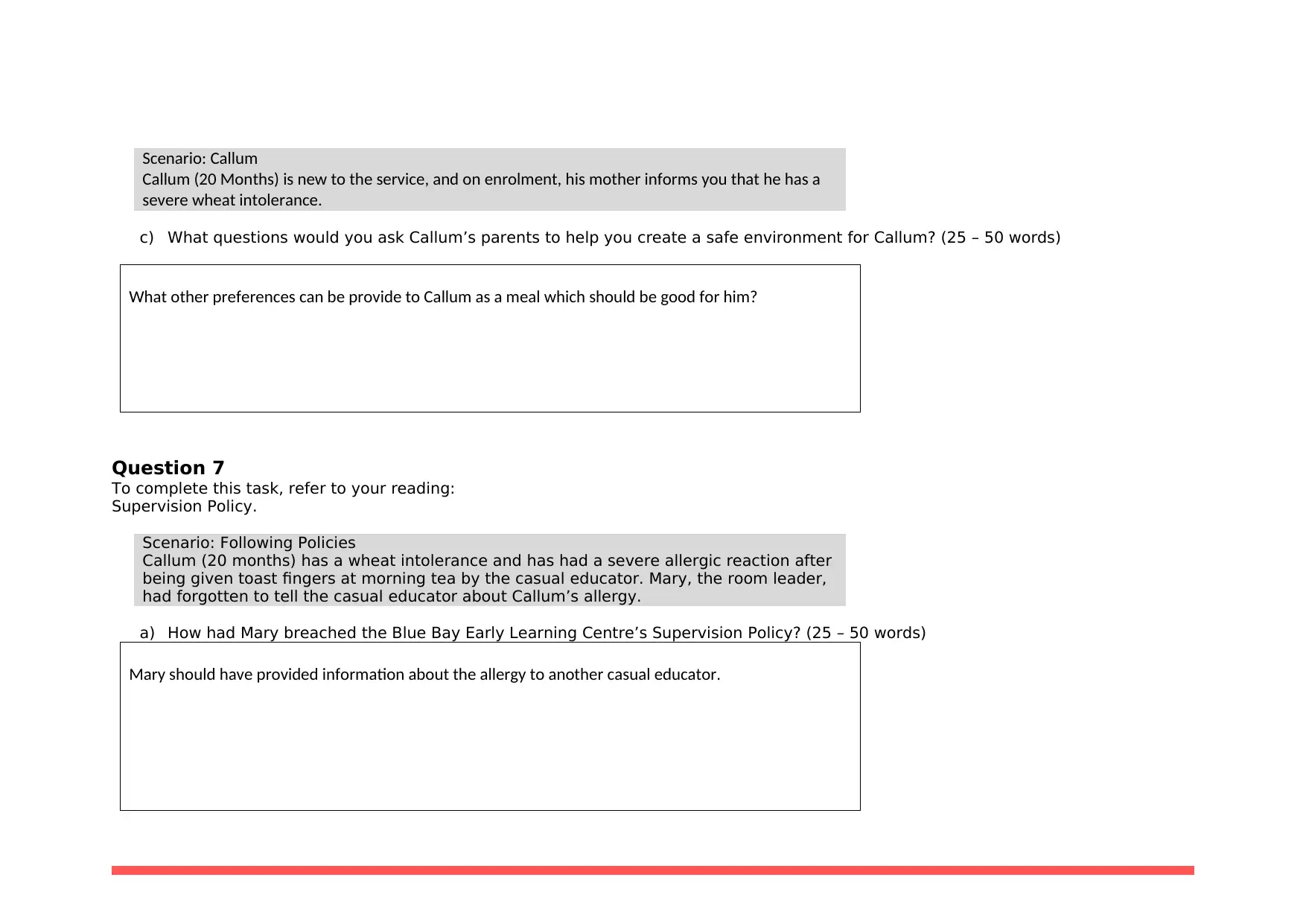
Scenario: Callum
Callum (20 Months) is new to the service, and on enrolment, his mother informs you that he has a
severe wheat intolerance.
c) What questions would you ask Callum’s parents to help you create a safe environment for Callum? (25 – 50 words)
What other preferences can be provide to Callum as a meal which should be good for him?
Question 7
To complete this task, refer to your reading:
Supervision Policy.
Scenario: Following Policies
Callum (20 months) has a wheat intolerance and has had a severe allergic reaction after
being given toast fingers at morning tea by the casual educator. Mary, the room leader,
had forgotten to tell the casual educator about Callum’s allergy.
a) How had Mary breached the Blue Bay Early Learning Centre’s Supervision Policy? (25 – 50 words)
Mary should have provided information about the allergy to another casual educator.
Callum (20 Months) is new to the service, and on enrolment, his mother informs you that he has a
severe wheat intolerance.
c) What questions would you ask Callum’s parents to help you create a safe environment for Callum? (25 – 50 words)
What other preferences can be provide to Callum as a meal which should be good for him?
Question 7
To complete this task, refer to your reading:
Supervision Policy.
Scenario: Following Policies
Callum (20 months) has a wheat intolerance and has had a severe allergic reaction after
being given toast fingers at morning tea by the casual educator. Mary, the room leader,
had forgotten to tell the casual educator about Callum’s allergy.
a) How had Mary breached the Blue Bay Early Learning Centre’s Supervision Policy? (25 – 50 words)
Mary should have provided information about the allergy to another casual educator.
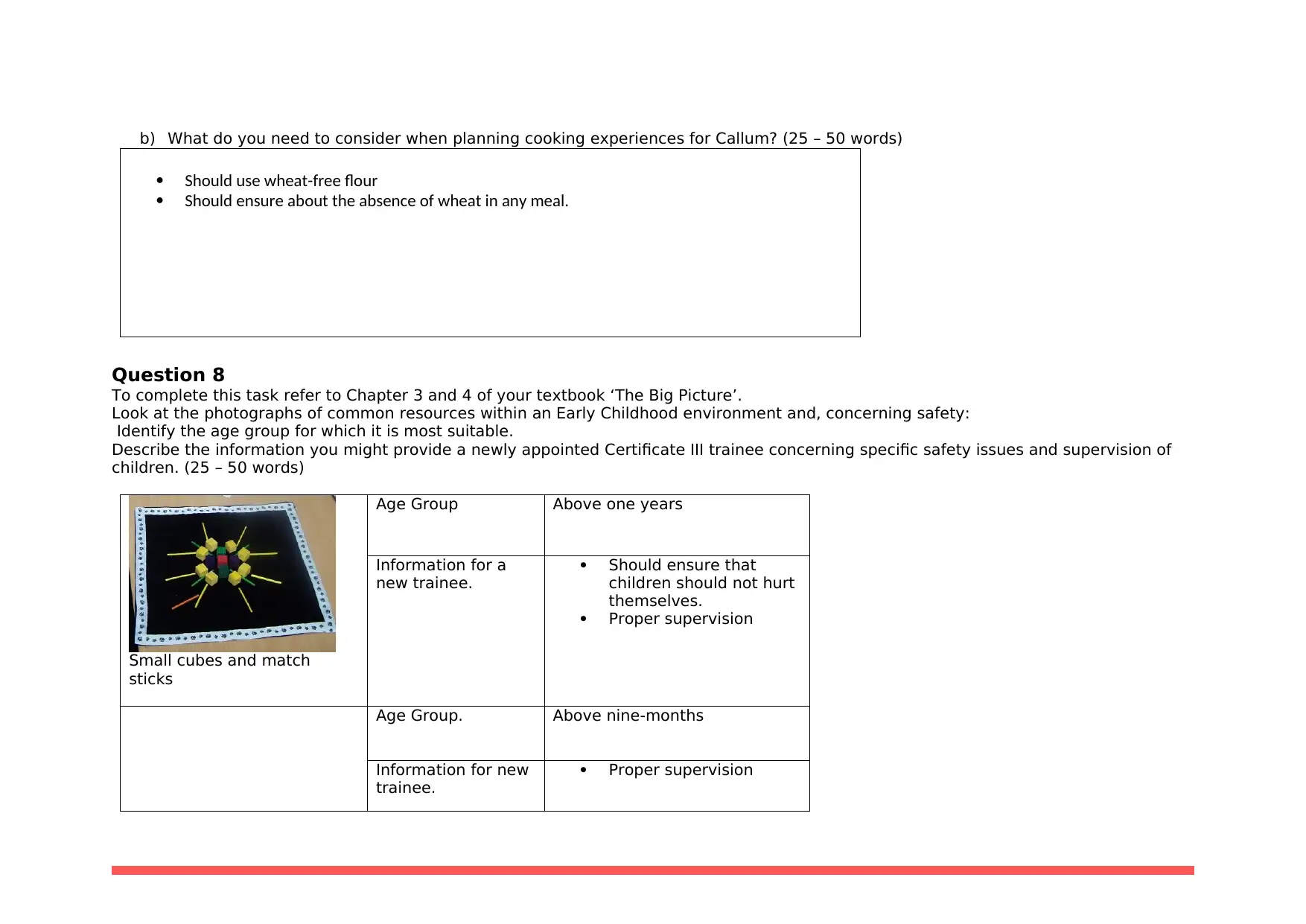
b) What do you need to consider when planning cooking experiences for Callum? (25 – 50 words)
Should use wheat-free flour
Should ensure about the absence of wheat in any meal.
Question 8
To complete this task refer to Chapter 3 and 4 of your textbook ‘The Big Picture’.
Look at the photographs of common resources within an Early Childhood environment and, concerning safety:
Identify the age group for which it is most suitable.
Describe the information you might provide a newly appointed Certificate III trainee concerning specific safety issues and supervision of
children. (25 – 50 words)
Small cubes and match
sticks
Age Group Above one years
Information for a
new trainee.
Should ensure that
children should not hurt
themselves.
Proper supervision
Age Group. Above nine-months
Information for new
trainee.
Proper supervision
Should use wheat-free flour
Should ensure about the absence of wheat in any meal.
Question 8
To complete this task refer to Chapter 3 and 4 of your textbook ‘The Big Picture’.
Look at the photographs of common resources within an Early Childhood environment and, concerning safety:
Identify the age group for which it is most suitable.
Describe the information you might provide a newly appointed Certificate III trainee concerning specific safety issues and supervision of
children. (25 – 50 words)
Small cubes and match
sticks
Age Group Above one years
Information for a
new trainee.
Should ensure that
children should not hurt
themselves.
Proper supervision
Age Group. Above nine-months
Information for new
trainee.
Proper supervision
Paraphrase This Document
Need a fresh take? Get an instant paraphrase of this document with our AI Paraphraser
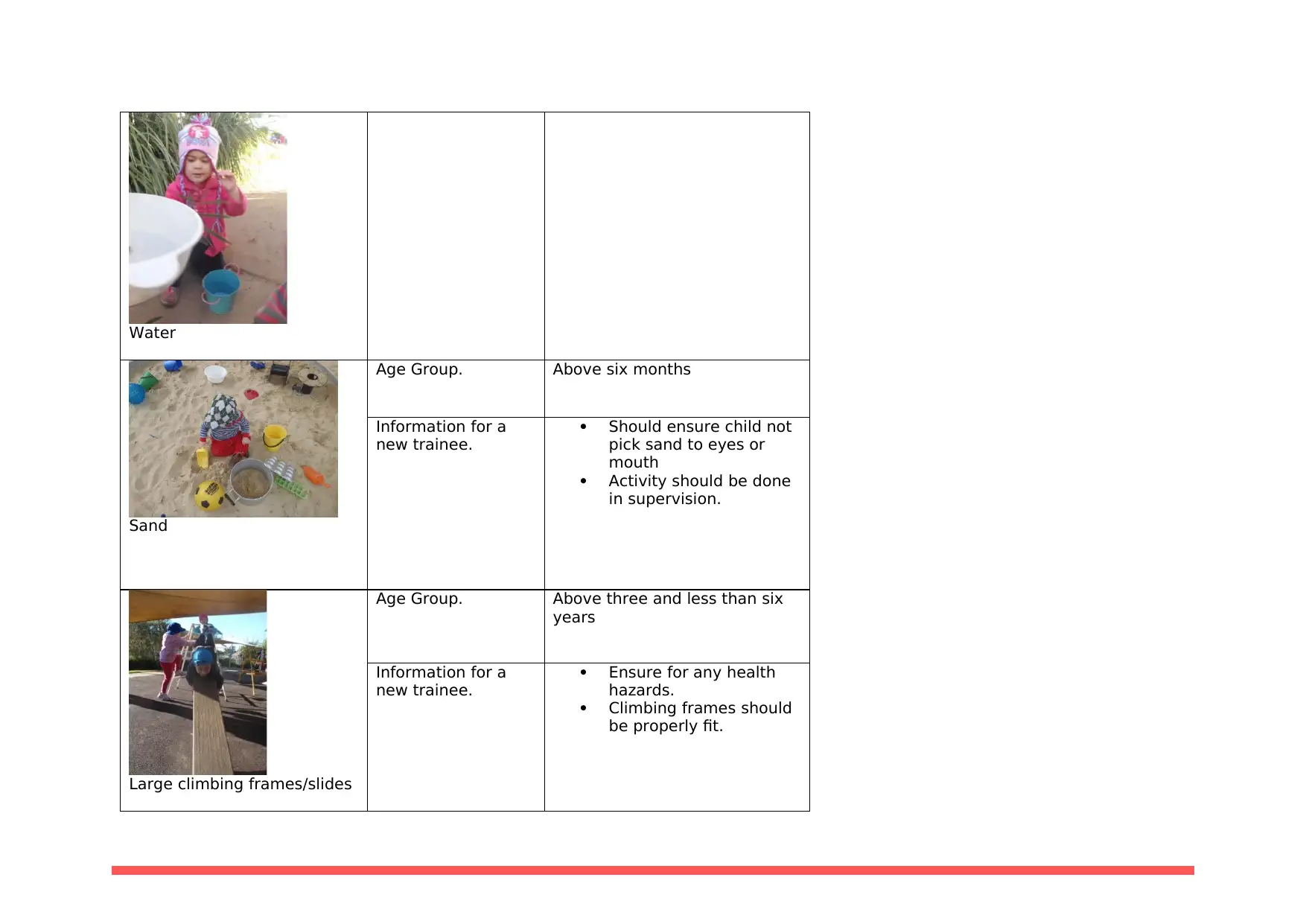
Water
Sand
Age Group. Above six months
Information for a
new trainee.
Should ensure child not
pick sand to eyes or
mouth
Activity should be done
in supervision.
Large climbing frames/slides
Age Group. Above three and less than six
years
Information for a
new trainee.
Ensure for any health
hazards.
Climbing frames should
be properly fit.
Sand
Age Group. Above six months
Information for a
new trainee.
Should ensure child not
pick sand to eyes or
mouth
Activity should be done
in supervision.
Large climbing frames/slides
Age Group. Above three and less than six
years
Information for a
new trainee.
Ensure for any health
hazards.
Climbing frames should
be properly fit.
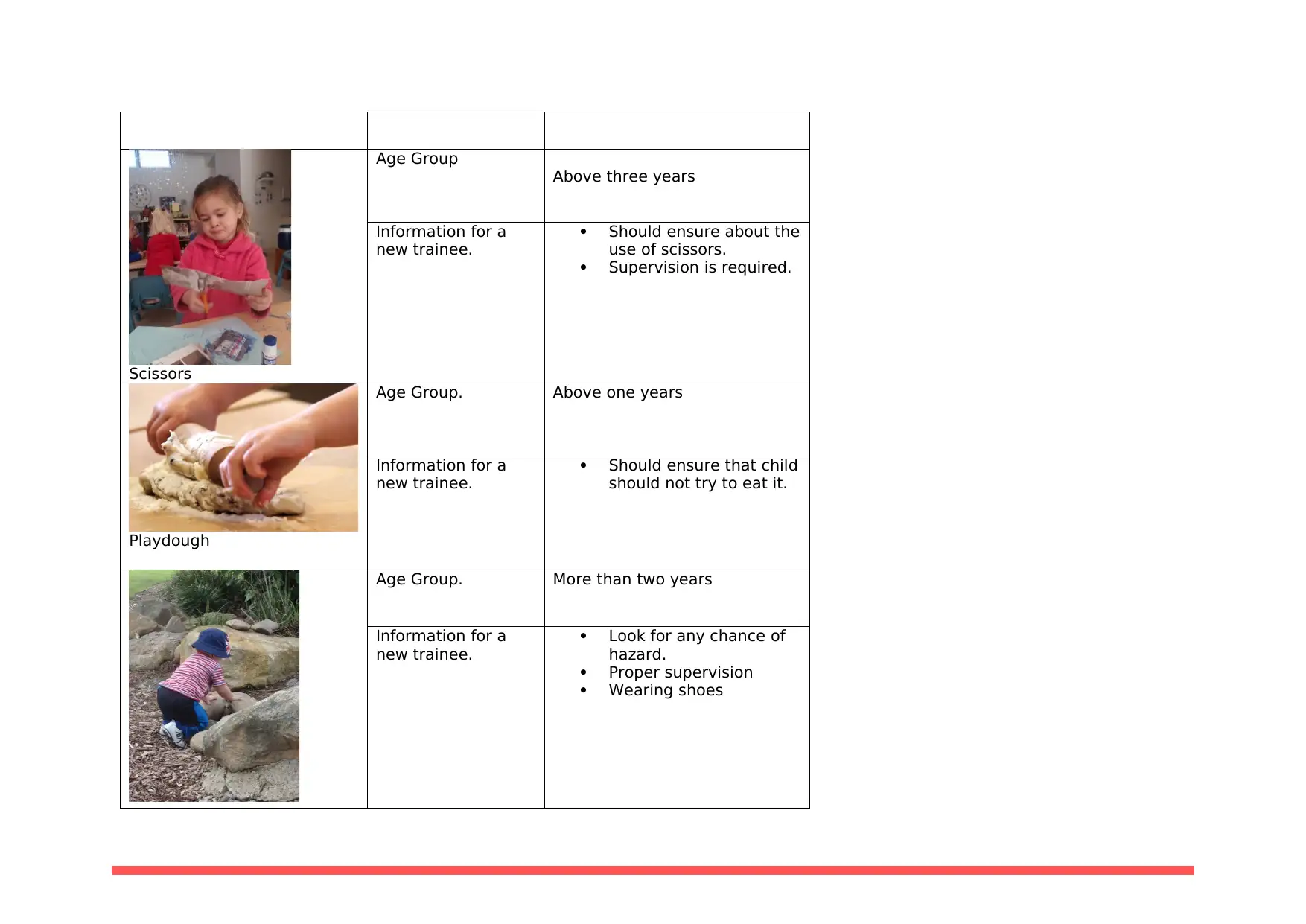
Scissors
Age Group
Above three years
Information for a
new trainee.
Should ensure about the
use of scissors.
Supervision is required.
Playdough
Age Group. Above one years
Information for a
new trainee.
Should ensure that child
should not try to eat it.
Age Group. More than two years
Information for a
new trainee.
Look for any chance of
hazard.
Proper supervision
Wearing shoes
Age Group
Above three years
Information for a
new trainee.
Should ensure about the
use of scissors.
Supervision is required.
Playdough
Age Group. Above one years
Information for a
new trainee.
Should ensure that child
should not try to eat it.
Age Group. More than two years
Information for a
new trainee.
Look for any chance of
hazard.
Proper supervision
Wearing shoes
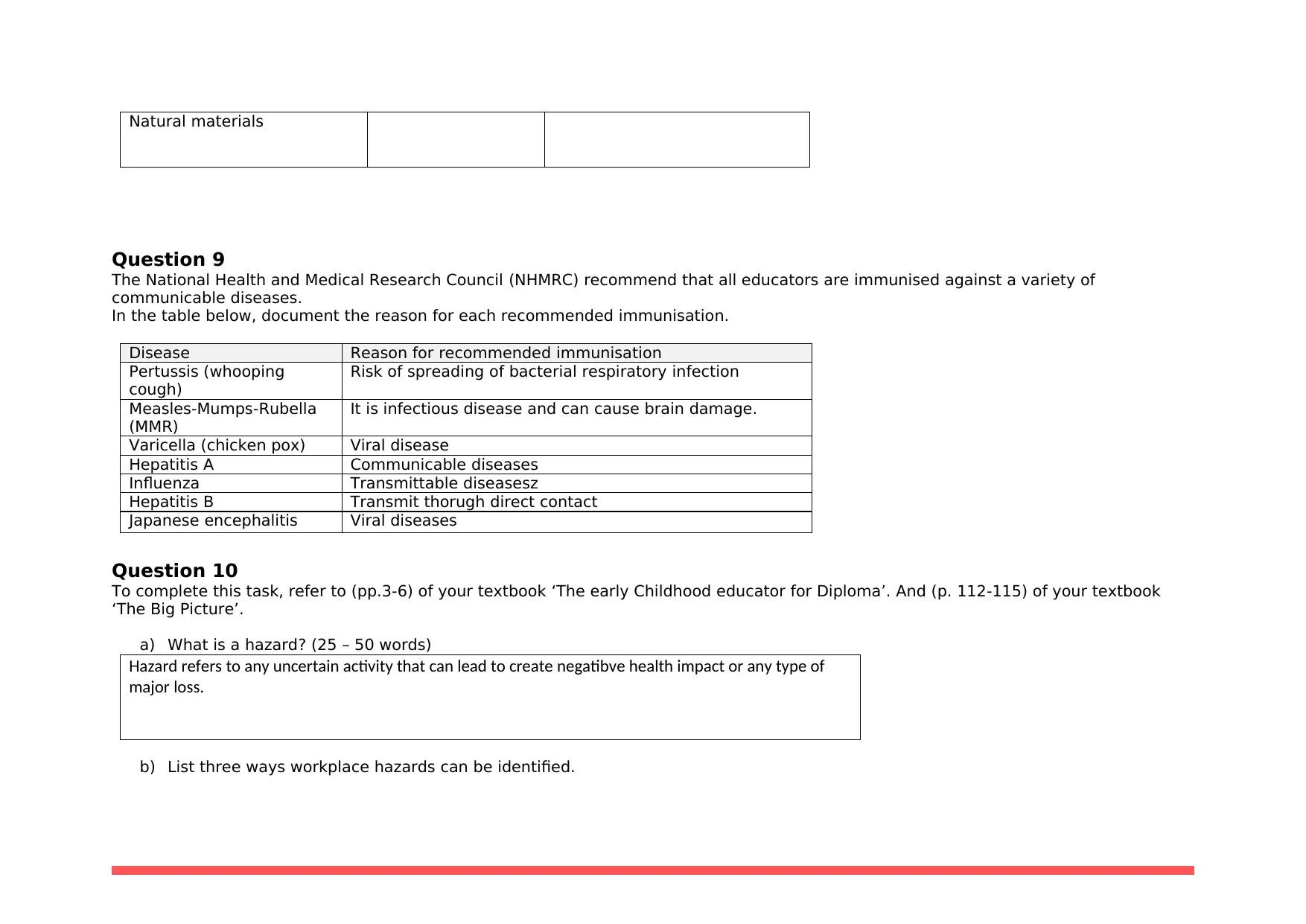
Natural materials
Question 9
The National Health and Medical Research Council (NHMRC) recommend that all educators are immunised against a variety of
communicable diseases.
In the table below, document the reason for each recommended immunisation.
Disease Reason for recommended immunisation
Pertussis (whooping
cough)
Risk of spreading of bacterial respiratory infection
Measles-Mumps-Rubella
(MMR)
It is infectious disease and can cause brain damage.
Varicella (chicken pox) Viral disease
Hepatitis A Communicable diseases
Influenza Transmittable diseasesz
Hepatitis B Transmit thorugh direct contact
Japanese encephalitis Viral diseases
Question 10
To complete this task, refer to (pp.3-6) of your textbook ‘The early Childhood educator for Diploma’. And (p. 112-115) of your textbook
‘The Big Picture’.
a) What is a hazard? (25 – 50 words)
Hazard refers to any uncertain activity that can lead to create negatibve health impact or any type of
major loss.
b) List three ways workplace hazards can be identified.
Question 9
The National Health and Medical Research Council (NHMRC) recommend that all educators are immunised against a variety of
communicable diseases.
In the table below, document the reason for each recommended immunisation.
Disease Reason for recommended immunisation
Pertussis (whooping
cough)
Risk of spreading of bacterial respiratory infection
Measles-Mumps-Rubella
(MMR)
It is infectious disease and can cause brain damage.
Varicella (chicken pox) Viral disease
Hepatitis A Communicable diseases
Influenza Transmittable diseasesz
Hepatitis B Transmit thorugh direct contact
Japanese encephalitis Viral diseases
Question 10
To complete this task, refer to (pp.3-6) of your textbook ‘The early Childhood educator for Diploma’. And (p. 112-115) of your textbook
‘The Big Picture’.
a) What is a hazard? (25 – 50 words)
Hazard refers to any uncertain activity that can lead to create negatibve health impact or any type of
major loss.
b) List three ways workplace hazards can be identified.
Secure Best Marks with AI Grader
Need help grading? Try our AI Grader for instant feedback on your assignments.
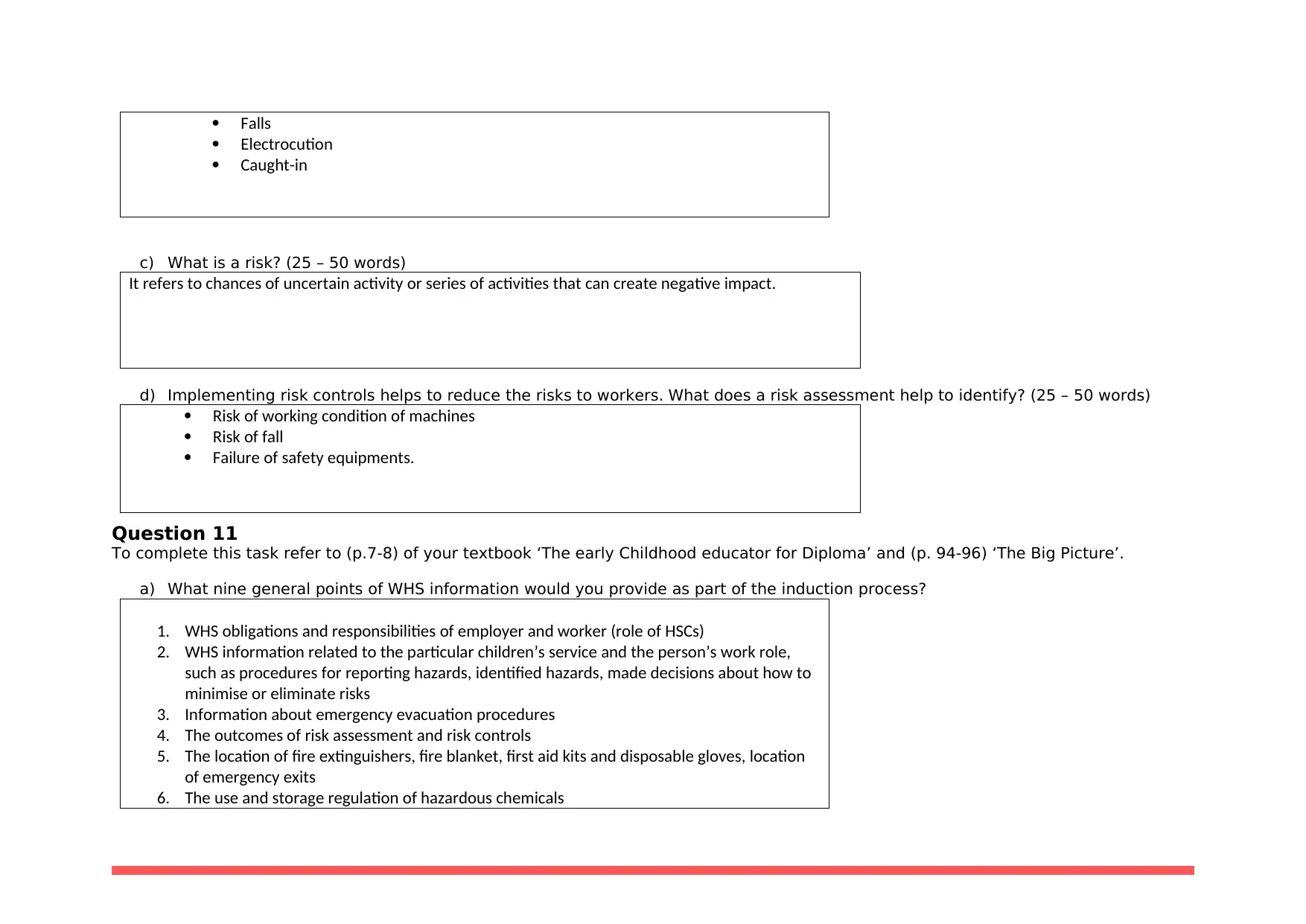
Falls
Electrocution
Caught-in
c) What is a risk? (25 – 50 words)
It refers to chances of uncertain activity or series of activities that can create negative impact.
d) Implementing risk controls helps to reduce the risks to workers. What does a risk assessment help to identify? (25 – 50 words)
Risk of working condition of machines
Risk of fall
Failure of safety equipments.
Question 11
To complete this task refer to (p.7-8) of your textbook ‘The early Childhood educator for Diploma’ and (p. 94-96) ‘The Big Picture’.
a) What nine general points of WHS information would you provide as part of the induction process?
1. WHS obligations and responsibilities of employer and worker (role of HSCs)
2. WHS information related to the particular children’s service and the person’s work role,
such as procedures for reporting hazards, identified hazards, made decisions about how to
minimise or eliminate risks
3. Information about emergency evacuation procedures
4. The outcomes of risk assessment and risk controls
5. The location of fire extinguishers, fire blanket, first aid kits and disposable gloves, location
of emergency exits
6. The use and storage regulation of hazardous chemicals
Electrocution
Caught-in
c) What is a risk? (25 – 50 words)
It refers to chances of uncertain activity or series of activities that can create negative impact.
d) Implementing risk controls helps to reduce the risks to workers. What does a risk assessment help to identify? (25 – 50 words)
Risk of working condition of machines
Risk of fall
Failure of safety equipments.
Question 11
To complete this task refer to (p.7-8) of your textbook ‘The early Childhood educator for Diploma’ and (p. 94-96) ‘The Big Picture’.
a) What nine general points of WHS information would you provide as part of the induction process?
1. WHS obligations and responsibilities of employer and worker (role of HSCs)
2. WHS information related to the particular children’s service and the person’s work role,
such as procedures for reporting hazards, identified hazards, made decisions about how to
minimise or eliminate risks
3. Information about emergency evacuation procedures
4. The outcomes of risk assessment and risk controls
5. The location of fire extinguishers, fire blanket, first aid kits and disposable gloves, location
of emergency exits
6. The use and storage regulation of hazardous chemicals
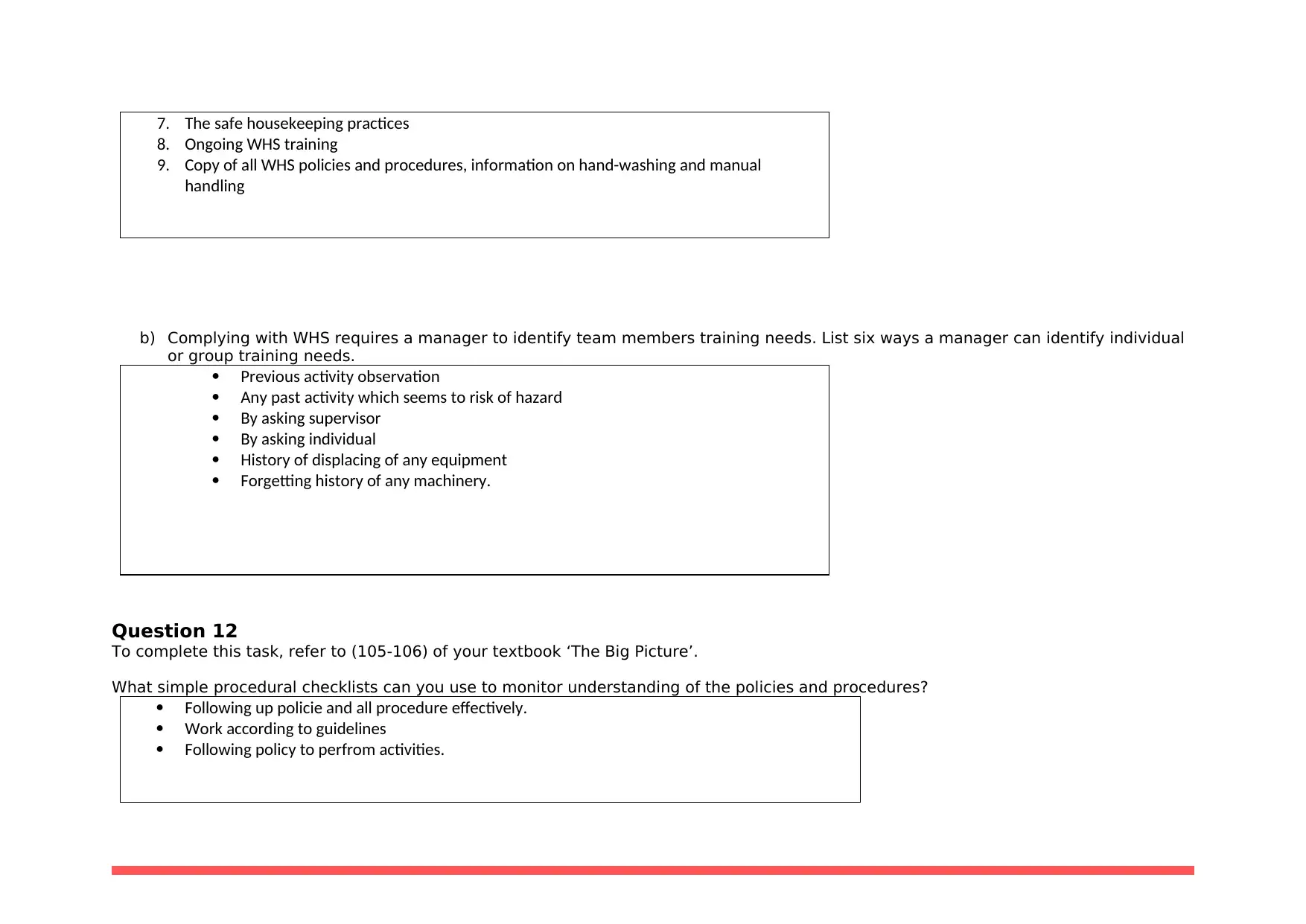
7. The safe housekeeping practices
8. Ongoing WHS training
9. Copy of all WHS policies and procedures, information on hand-washing and manual
handling
b) Complying with WHS requires a manager to identify team members training needs. List six ways a manager can identify individual
or group training needs.
Previous activity observation
Any past activity which seems to risk of hazard
By asking supervisor
By asking individual
History of displacing of any equipment
Forgetting history of any machinery.
Question 12
To complete this task, refer to (105-106) of your textbook ‘The Big Picture’.
What simple procedural checklists can you use to monitor understanding of the policies and procedures?
Following up policie and all procedure effectively.
Work according to guidelines
Following policy to perfrom activities.
8. Ongoing WHS training
9. Copy of all WHS policies and procedures, information on hand-washing and manual
handling
b) Complying with WHS requires a manager to identify team members training needs. List six ways a manager can identify individual
or group training needs.
Previous activity observation
Any past activity which seems to risk of hazard
By asking supervisor
By asking individual
History of displacing of any equipment
Forgetting history of any machinery.
Question 12
To complete this task, refer to (105-106) of your textbook ‘The Big Picture’.
What simple procedural checklists can you use to monitor understanding of the policies and procedures?
Following up policie and all procedure effectively.
Work according to guidelines
Following policy to perfrom activities.

Question 13
To complete this task, refer to (chapter 1) of your textbook ‘The Early Childhood Educator for Diploma.’
a) Assisting staff to follow WHS policies and procedures can be facilitated through in-house training. List three training strategies the
person conducting a business or an undertaking (PCBU) could provide and give an example for each strategy.
Training Strategy Example
Placing equipment at their right
place
Placing equipment at right place can help to avoid any hazard like
fall.
Time to time training Training on every 6 months can updata employee for safety.
Educating employees Providing safety concern to apply while working.
b) Using the training strategies identified in part (a) choose the best option for the following Early Childhood tasks and explain why it
is the preferred training strategy. (25 – 50 words each answer)
To complete this task, refer to (chapter 1) of your textbook ‘The Early Childhood Educator for Diploma.’
a) Assisting staff to follow WHS policies and procedures can be facilitated through in-house training. List three training strategies the
person conducting a business or an undertaking (PCBU) could provide and give an example for each strategy.
Training Strategy Example
Placing equipment at their right
place
Placing equipment at right place can help to avoid any hazard like
fall.
Time to time training Training on every 6 months can updata employee for safety.
Educating employees Providing safety concern to apply while working.
b) Using the training strategies identified in part (a) choose the best option for the following Early Childhood tasks and explain why it
is the preferred training strategy. (25 – 50 words each answer)
Paraphrase This Document
Need a fresh take? Get an instant paraphrase of this document with our AI Paraphraser
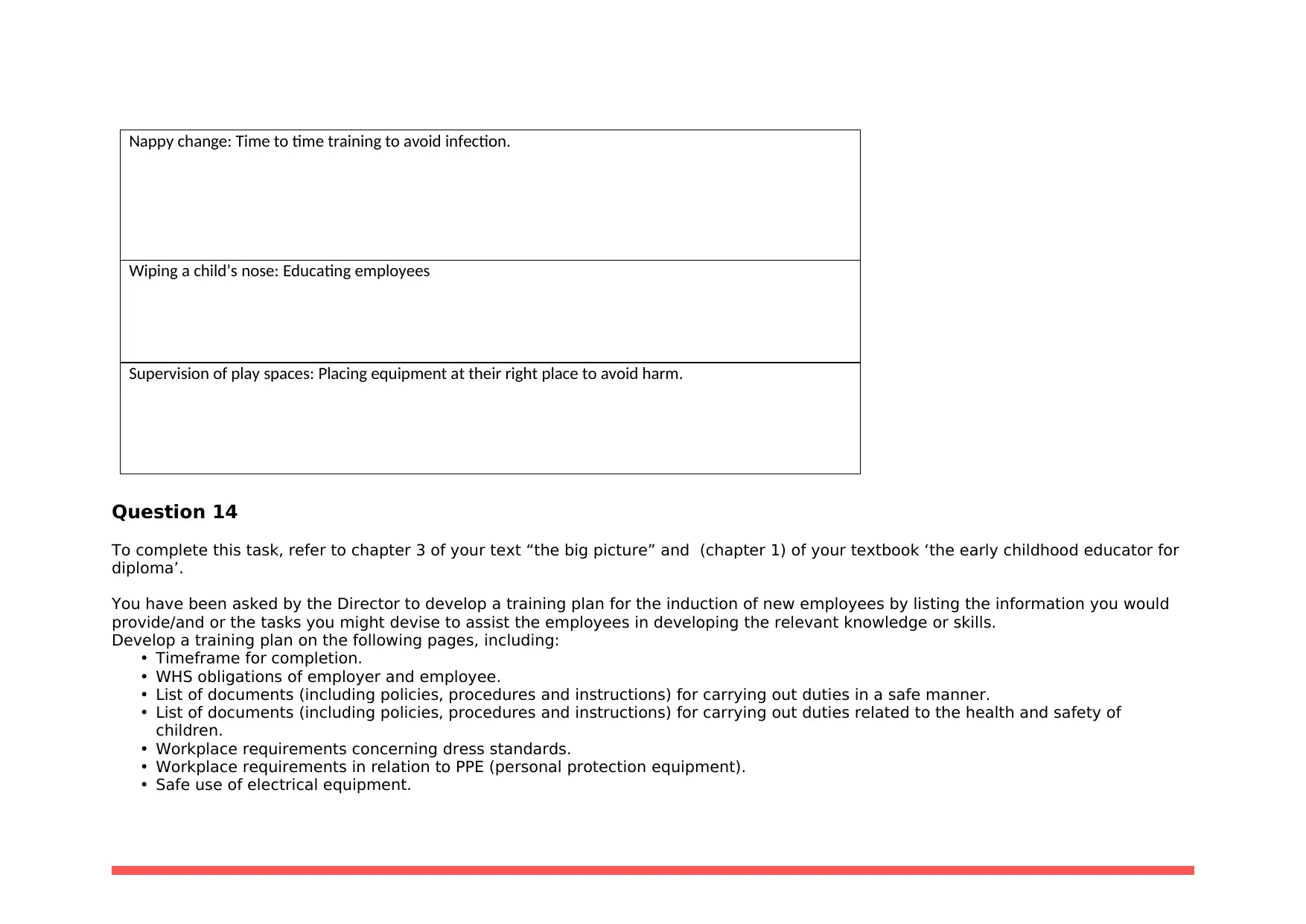
Nappy change: Time to time training to avoid infection.
Wiping a child’s nose: Educating employees
Supervision of play spaces: Placing equipment at their right place to avoid harm.
Question 14
To complete this task, refer to chapter 3 of your text “the big picture” and (chapter 1) of your textbook ‘the early childhood educator for
diploma’.
You have been asked by the Director to develop a training plan for the induction of new employees by listing the information you would
provide/and or the tasks you might devise to assist the employees in developing the relevant knowledge or skills.
Develop a training plan on the following pages, including:
• Timeframe for completion.
• WHS obligations of employer and employee.
• List of documents (including policies, procedures and instructions) for carrying out duties in a safe manner.
• List of documents (including policies, procedures and instructions) for carrying out duties related to the health and safety of
children.
• Workplace requirements concerning dress standards.
• Workplace requirements in relation to PPE (personal protection equipment).
• Safe use of electrical equipment.
Wiping a child’s nose: Educating employees
Supervision of play spaces: Placing equipment at their right place to avoid harm.
Question 14
To complete this task, refer to chapter 3 of your text “the big picture” and (chapter 1) of your textbook ‘the early childhood educator for
diploma’.
You have been asked by the Director to develop a training plan for the induction of new employees by listing the information you would
provide/and or the tasks you might devise to assist the employees in developing the relevant knowledge or skills.
Develop a training plan on the following pages, including:
• Timeframe for completion.
• WHS obligations of employer and employee.
• List of documents (including policies, procedures and instructions) for carrying out duties in a safe manner.
• List of documents (including policies, procedures and instructions) for carrying out duties related to the health and safety of
children.
• Workplace requirements concerning dress standards.
• Workplace requirements in relation to PPE (personal protection equipment).
• Safe use of electrical equipment.
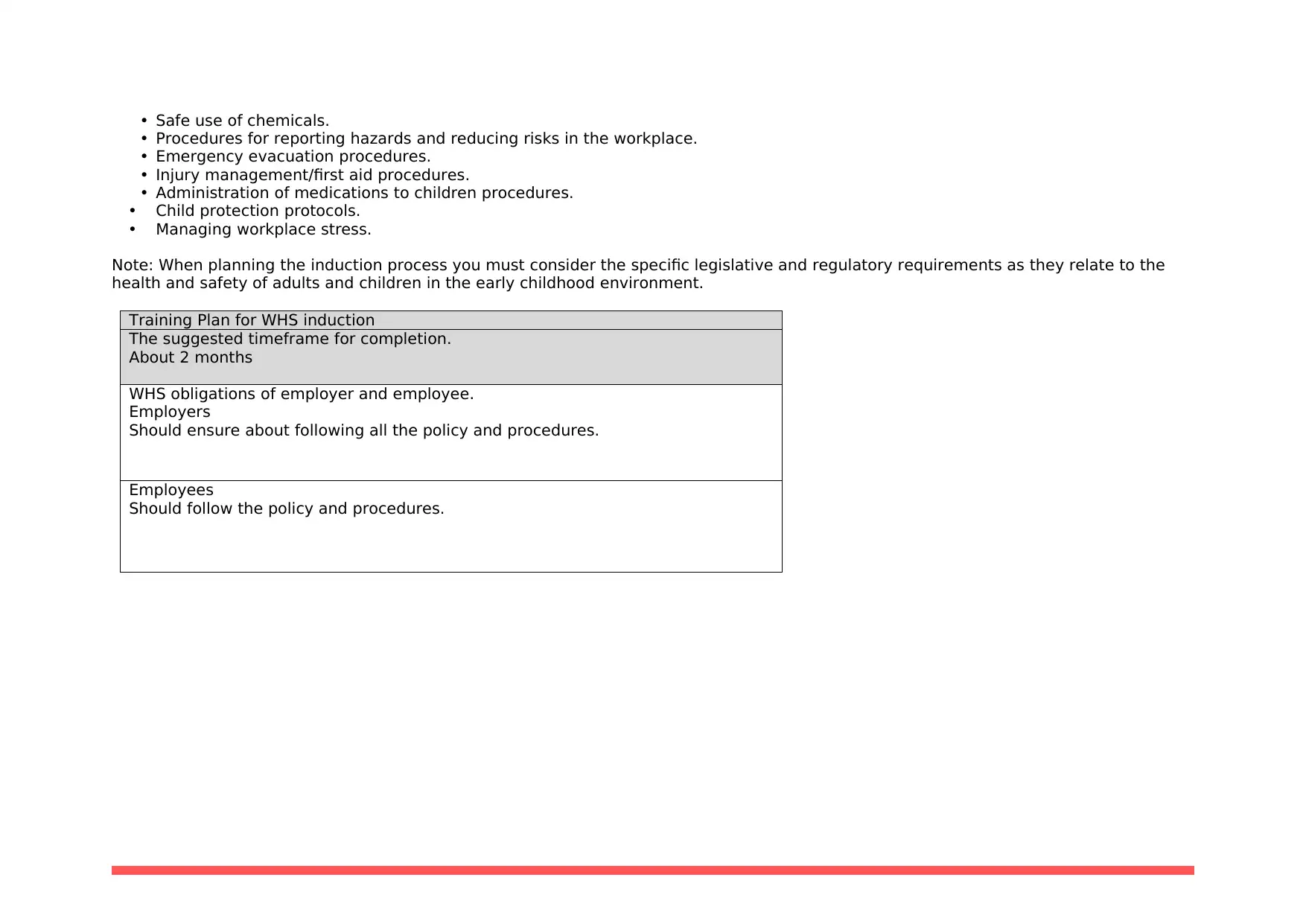
• Safe use of chemicals.
• Procedures for reporting hazards and reducing risks in the workplace.
• Emergency evacuation procedures.
• Injury management/first aid procedures.
• Administration of medications to children procedures.
• Child protection protocols.
• Managing workplace stress.
Note: When planning the induction process you must consider the specific legislative and regulatory requirements as they relate to the
health and safety of adults and children in the early childhood environment.
Training Plan for WHS induction
The suggested timeframe for completion.
About 2 months
WHS obligations of employer and employee.
Employers
Should ensure about following all the policy and procedures.
Employees
Should follow the policy and procedures.
• Procedures for reporting hazards and reducing risks in the workplace.
• Emergency evacuation procedures.
• Injury management/first aid procedures.
• Administration of medications to children procedures.
• Child protection protocols.
• Managing workplace stress.
Note: When planning the induction process you must consider the specific legislative and regulatory requirements as they relate to the
health and safety of adults and children in the early childhood environment.
Training Plan for WHS induction
The suggested timeframe for completion.
About 2 months
WHS obligations of employer and employee.
Employers
Should ensure about following all the policy and procedures.
Employees
Should follow the policy and procedures.
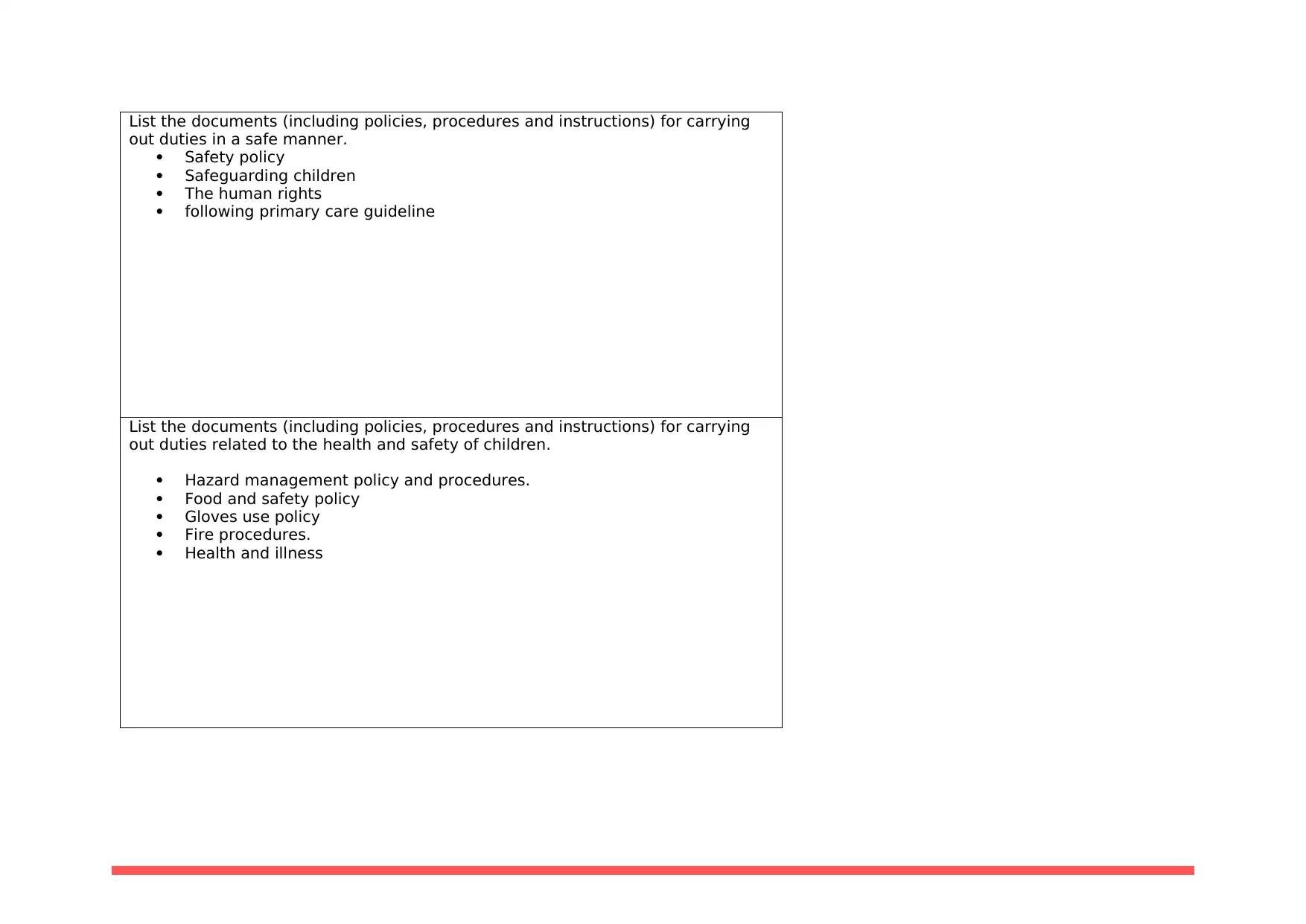
List the documents (including policies, procedures and instructions) for carrying
out duties in a safe manner.
Safety policy
Safeguarding children
The human rights
following primary care guideline
List the documents (including policies, procedures and instructions) for carrying
out duties related to the health and safety of children.
Hazard management policy and procedures.
Food and safety policy
Gloves use policy
Fire procedures.
Health and illness
out duties in a safe manner.
Safety policy
Safeguarding children
The human rights
following primary care guideline
List the documents (including policies, procedures and instructions) for carrying
out duties related to the health and safety of children.
Hazard management policy and procedures.
Food and safety policy
Gloves use policy
Fire procedures.
Health and illness
Secure Best Marks with AI Grader
Need help grading? Try our AI Grader for instant feedback on your assignments.
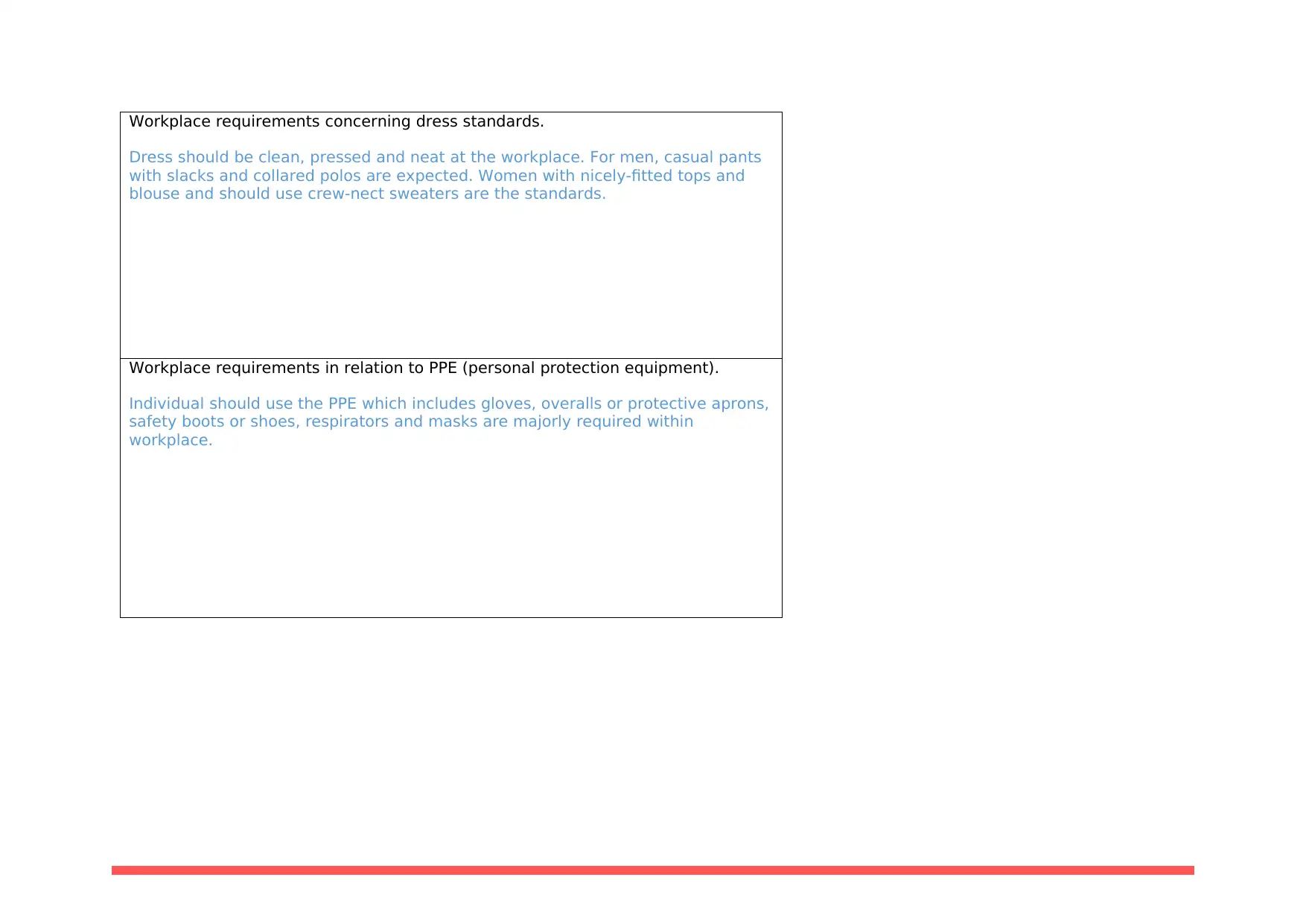
Workplace requirements concerning dress standards.
Dress should be clean, pressed and neat at the workplace. For men, casual pants
with slacks and collared polos are expected. Women with nicely-fitted tops and
blouse and should use crew-nect sweaters are the standards.
Workplace requirements in relation to PPE (personal protection equipment).
Individual should use the PPE which includes gloves, overalls or protective aprons,
safety boots or shoes, respirators and masks are majorly required within
workplace.
Dress should be clean, pressed and neat at the workplace. For men, casual pants
with slacks and collared polos are expected. Women with nicely-fitted tops and
blouse and should use crew-nect sweaters are the standards.
Workplace requirements in relation to PPE (personal protection equipment).
Individual should use the PPE which includes gloves, overalls or protective aprons,
safety boots or shoes, respirators and masks are majorly required within
workplace.
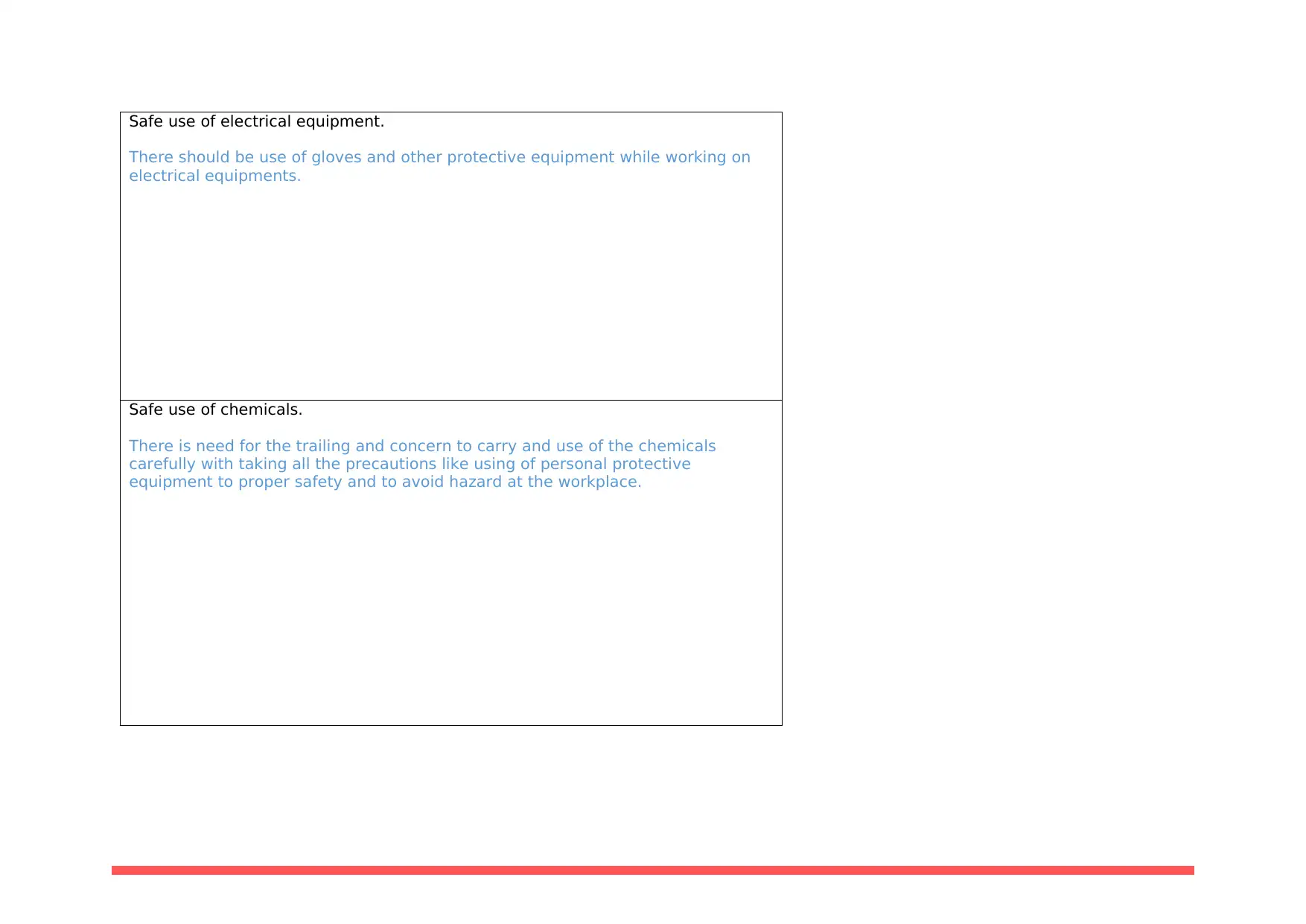
Safe use of electrical equipment.
There should be use of gloves and other protective equipment while working on
electrical equipments.
Safe use of chemicals.
There is need for the trailing and concern to carry and use of the chemicals
carefully with taking all the precautions like using of personal protective
equipment to proper safety and to avoid hazard at the workplace.
There should be use of gloves and other protective equipment while working on
electrical equipments.
Safe use of chemicals.
There is need for the trailing and concern to carry and use of the chemicals
carefully with taking all the precautions like using of personal protective
equipment to proper safety and to avoid hazard at the workplace.
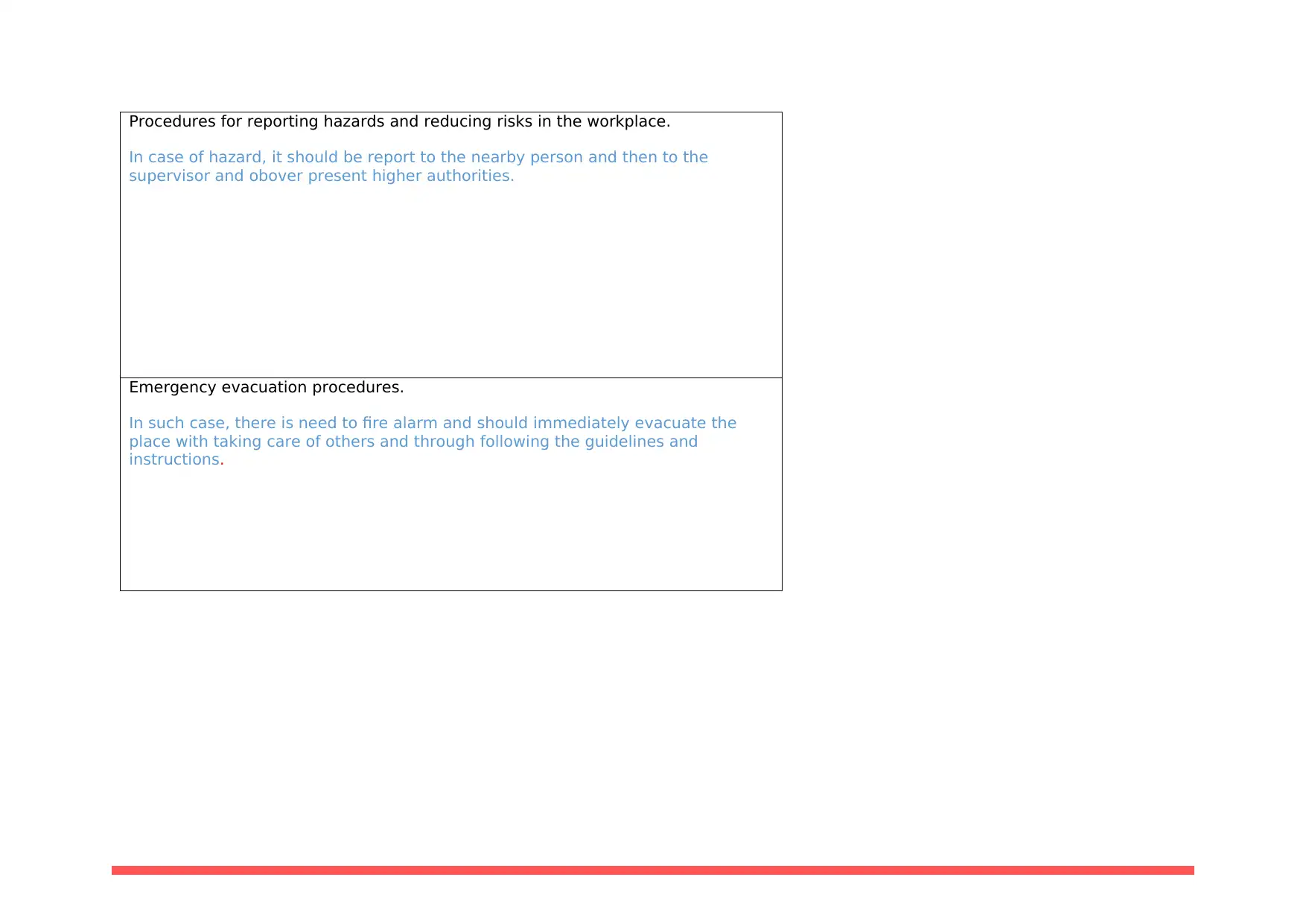
Procedures for reporting hazards and reducing risks in the workplace.
In case of hazard, it should be report to the nearby person and then to the
supervisor and obover present higher authorities.
Emergency evacuation procedures.
In such case, there is need to fire alarm and should immediately evacuate the
place with taking care of others and through following the guidelines and
instructions.
In case of hazard, it should be report to the nearby person and then to the
supervisor and obover present higher authorities.
Emergency evacuation procedures.
In such case, there is need to fire alarm and should immediately evacuate the
place with taking care of others and through following the guidelines and
instructions.
Paraphrase This Document
Need a fresh take? Get an instant paraphrase of this document with our AI Paraphraser
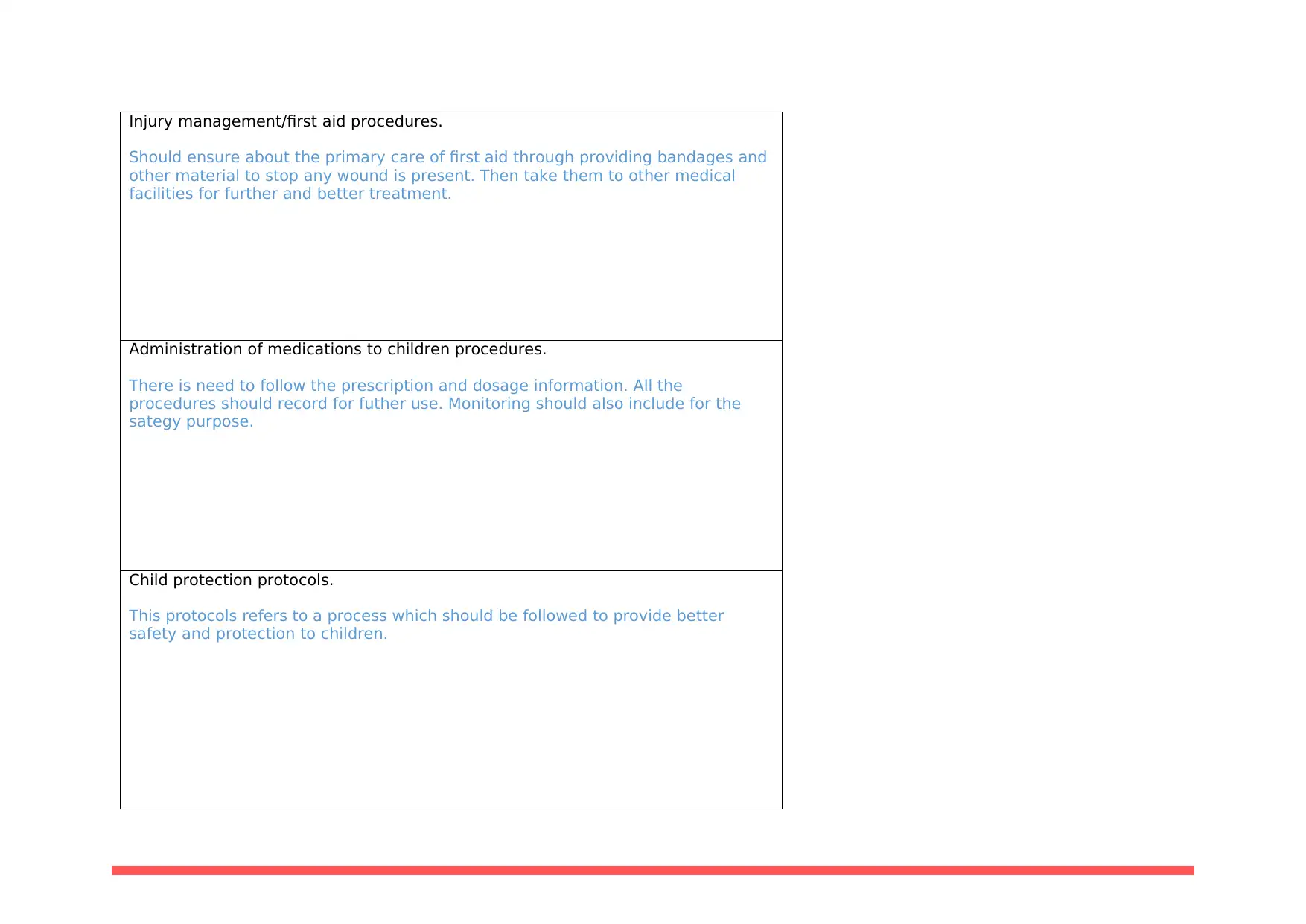
Injury management/first aid procedures.
Should ensure about the primary care of first aid through providing bandages and
other material to stop any wound is present. Then take them to other medical
facilities for further and better treatment.
Administration of medications to children procedures.
There is need to follow the prescription and dosage information. All the
procedures should record for futher use. Monitoring should also include for the
sategy purpose.
Child protection protocols.
This protocols refers to a process which should be followed to provide better
safety and protection to children.
Should ensure about the primary care of first aid through providing bandages and
other material to stop any wound is present. Then take them to other medical
facilities for further and better treatment.
Administration of medications to children procedures.
There is need to follow the prescription and dosage information. All the
procedures should record for futher use. Monitoring should also include for the
sategy purpose.
Child protection protocols.
This protocols refers to a process which should be followed to provide better
safety and protection to children.
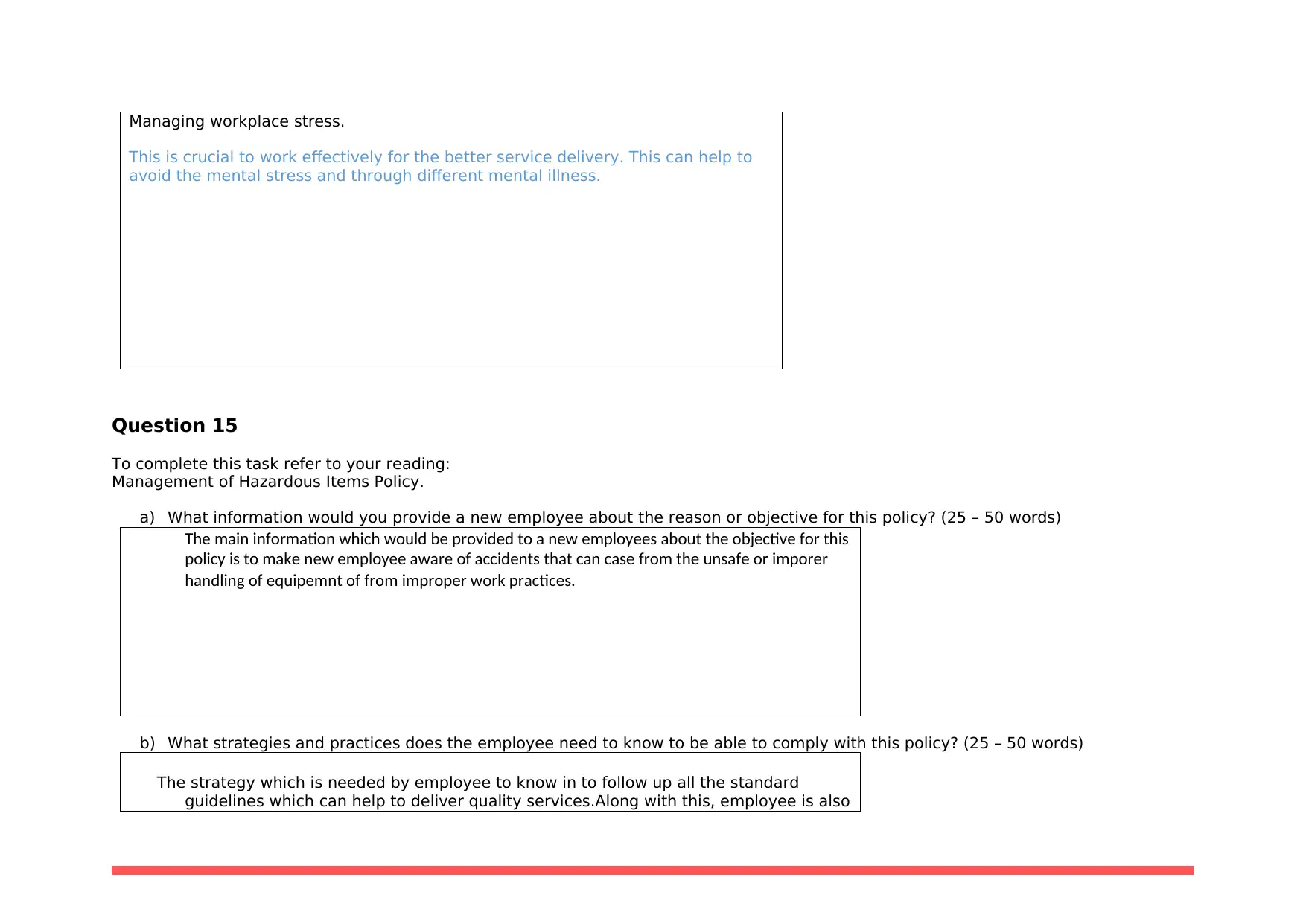
Managing workplace stress.
This is crucial to work effectively for the better service delivery. This can help to
avoid the mental stress and through different mental illness.
Question 15
To complete this task refer to your reading:
Management of Hazardous Items Policy.
a) What information would you provide a new employee about the reason or objective for this policy? (25 – 50 words)
The main information which would be provided to a new employees about the objective for this
policy is to make new employee aware of accidents that can case from the unsafe or imporer
handling of equipemnt of from improper work practices.
b) What strategies and practices does the employee need to know to be able to comply with this policy? (25 – 50 words)
The strategy which is needed by employee to know in to follow up all the standard
guidelines which can help to deliver quality services.Along with this, employee is also
This is crucial to work effectively for the better service delivery. This can help to
avoid the mental stress and through different mental illness.
Question 15
To complete this task refer to your reading:
Management of Hazardous Items Policy.
a) What information would you provide a new employee about the reason or objective for this policy? (25 – 50 words)
The main information which would be provided to a new employees about the objective for this
policy is to make new employee aware of accidents that can case from the unsafe or imporer
handling of equipemnt of from improper work practices.
b) What strategies and practices does the employee need to know to be able to comply with this policy? (25 – 50 words)
The strategy which is needed by employee to know in to follow up all the standard
guidelines which can help to deliver quality services.Along with this, employee is also
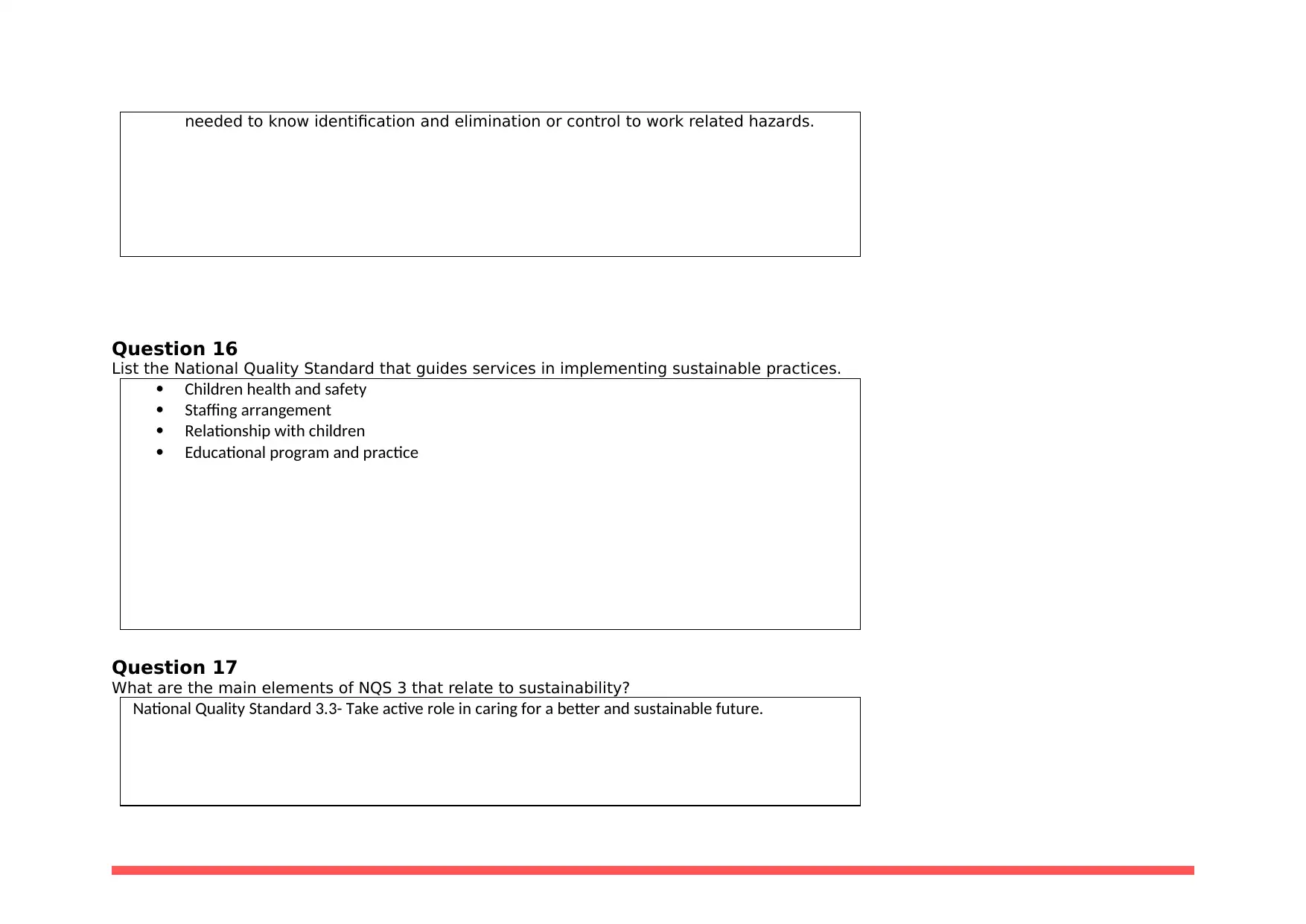
needed to know identification and elimination or control to work related hazards.
Question 16
List the National Quality Standard that guides services in implementing sustainable practices.
Children health and safety
Staffing arrangement
Relationship with children
Educational program and practice
Question 17
What are the main elements of NQS 3 that relate to sustainability?
National Quality Standard 3.3- Take active role in caring for a better and sustainable future.
Question 16
List the National Quality Standard that guides services in implementing sustainable practices.
Children health and safety
Staffing arrangement
Relationship with children
Educational program and practice
Question 17
What are the main elements of NQS 3 that relate to sustainability?
National Quality Standard 3.3- Take active role in caring for a better and sustainable future.
Secure Best Marks with AI Grader
Need help grading? Try our AI Grader for instant feedback on your assignments.
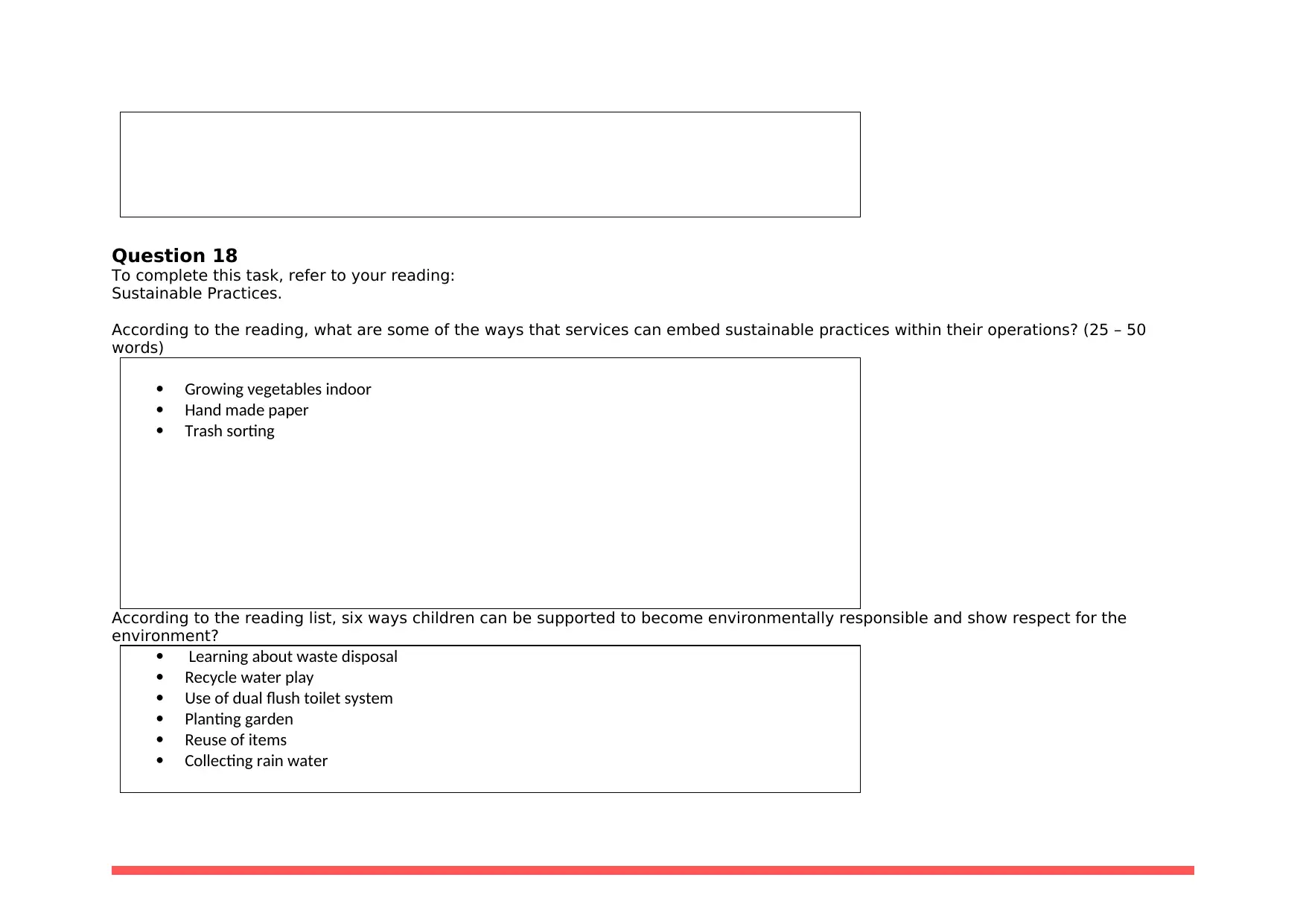
Question 18
To complete this task, refer to your reading:
Sustainable Practices.
According to the reading, what are some of the ways that services can embed sustainable practices within their operations? (25 – 50
words)
Growing vegetables indoor
Hand made paper
Trash sorting
According to the reading list, six ways children can be supported to become environmentally responsible and show respect for the
environment?
Learning about waste disposal
Recycle water play
Use of dual flush toilet system
Planting garden
Reuse of items
Collecting rain water
To complete this task, refer to your reading:
Sustainable Practices.
According to the reading, what are some of the ways that services can embed sustainable practices within their operations? (25 – 50
words)
Growing vegetables indoor
Hand made paper
Trash sorting
According to the reading list, six ways children can be supported to become environmentally responsible and show respect for the
environment?
Learning about waste disposal
Recycle water play
Use of dual flush toilet system
Planting garden
Reuse of items
Collecting rain water

Question 19
a) Provide an example of sustainable practices that may be implemented within each of the following areas within a children’s
service.
Service Practice Example
Regulatory practices. To provide care at the workplace.
Use of utilities. Using flush after use.
Purchasing. Natural product on priorities
Use of recycled materials. Like papers and other objects.
Gardens. Planting flowers.
To complete this task, refer to (p. 395) of your textbook ‘The Big Picture’.
b) How can the educator engage children to explore environmental sustainability through nature? (25 – 50 words)
Educating about planting
Playing outside
Playing with water and mud
Recycling products
a) Provide an example of sustainable practices that may be implemented within each of the following areas within a children’s
service.
Service Practice Example
Regulatory practices. To provide care at the workplace.
Use of utilities. Using flush after use.
Purchasing. Natural product on priorities
Use of recycled materials. Like papers and other objects.
Gardens. Planting flowers.
To complete this task, refer to (p. 395) of your textbook ‘The Big Picture’.
b) How can the educator engage children to explore environmental sustainability through nature? (25 – 50 words)
Educating about planting
Playing outside
Playing with water and mud
Recycling products
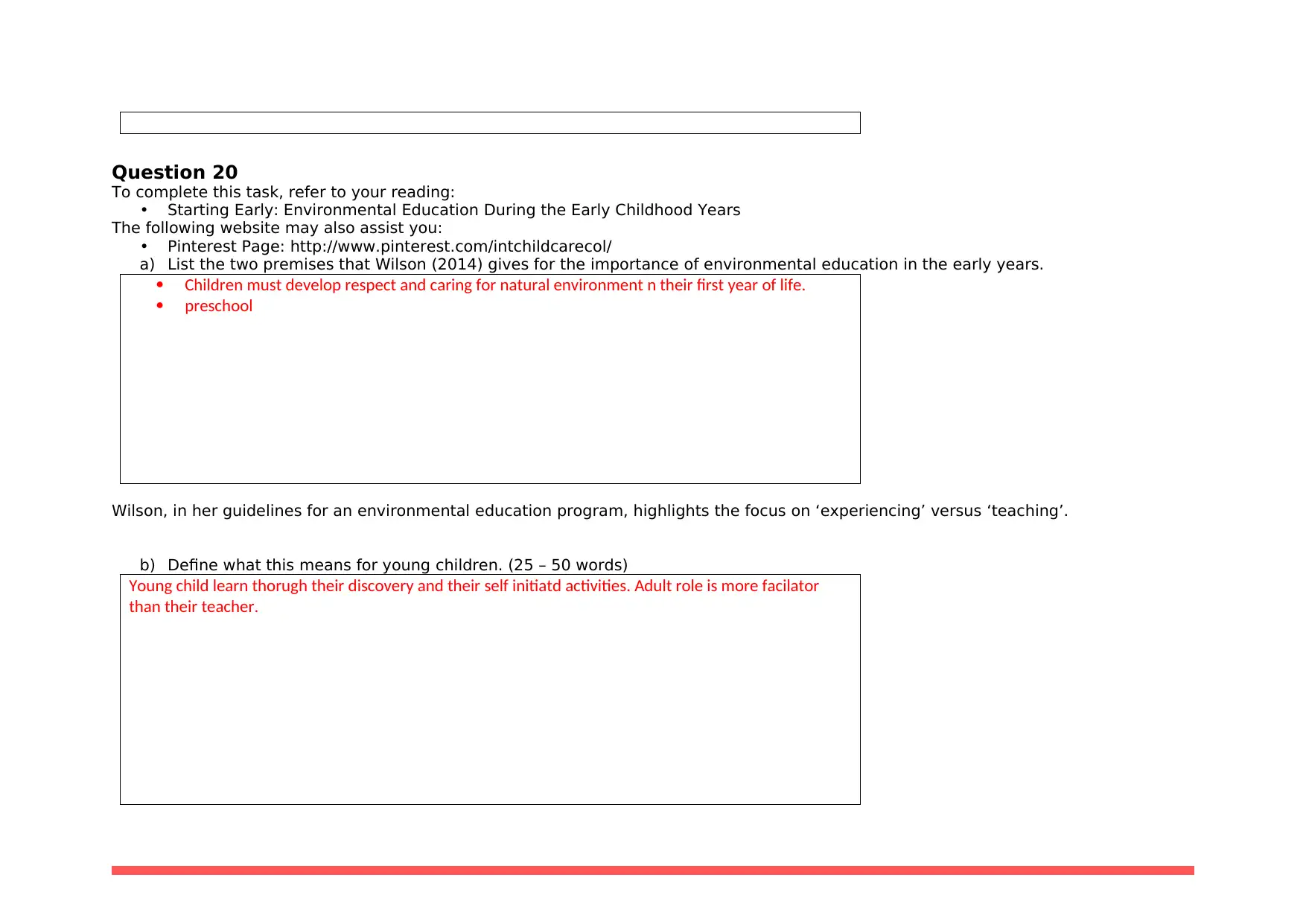
Question 20
To complete this task, refer to your reading:
• Starting Early: Environmental Education During the Early Childhood Years
The following website may also assist you:
• Pinterest Page: http://www.pinterest.com/intchildcarecol/
a) List the two premises that Wilson (2014) gives for the importance of environmental education in the early years.
Children must develop respect and caring for natural environment n their first year of life.
preschool
Wilson, in her guidelines for an environmental education program, highlights the focus on ‘experiencing’ versus ‘teaching’.
b) Define what this means for young children. (25 – 50 words)
Young child learn thorugh their discovery and their self initiatd activities. Adult role is more facilator
than their teacher.
To complete this task, refer to your reading:
• Starting Early: Environmental Education During the Early Childhood Years
The following website may also assist you:
• Pinterest Page: http://www.pinterest.com/intchildcarecol/
a) List the two premises that Wilson (2014) gives for the importance of environmental education in the early years.
Children must develop respect and caring for natural environment n their first year of life.
preschool
Wilson, in her guidelines for an environmental education program, highlights the focus on ‘experiencing’ versus ‘teaching’.
b) Define what this means for young children. (25 – 50 words)
Young child learn thorugh their discovery and their self initiatd activities. Adult role is more facilator
than their teacher.
Paraphrase This Document
Need a fresh take? Get an instant paraphrase of this document with our AI Paraphraser
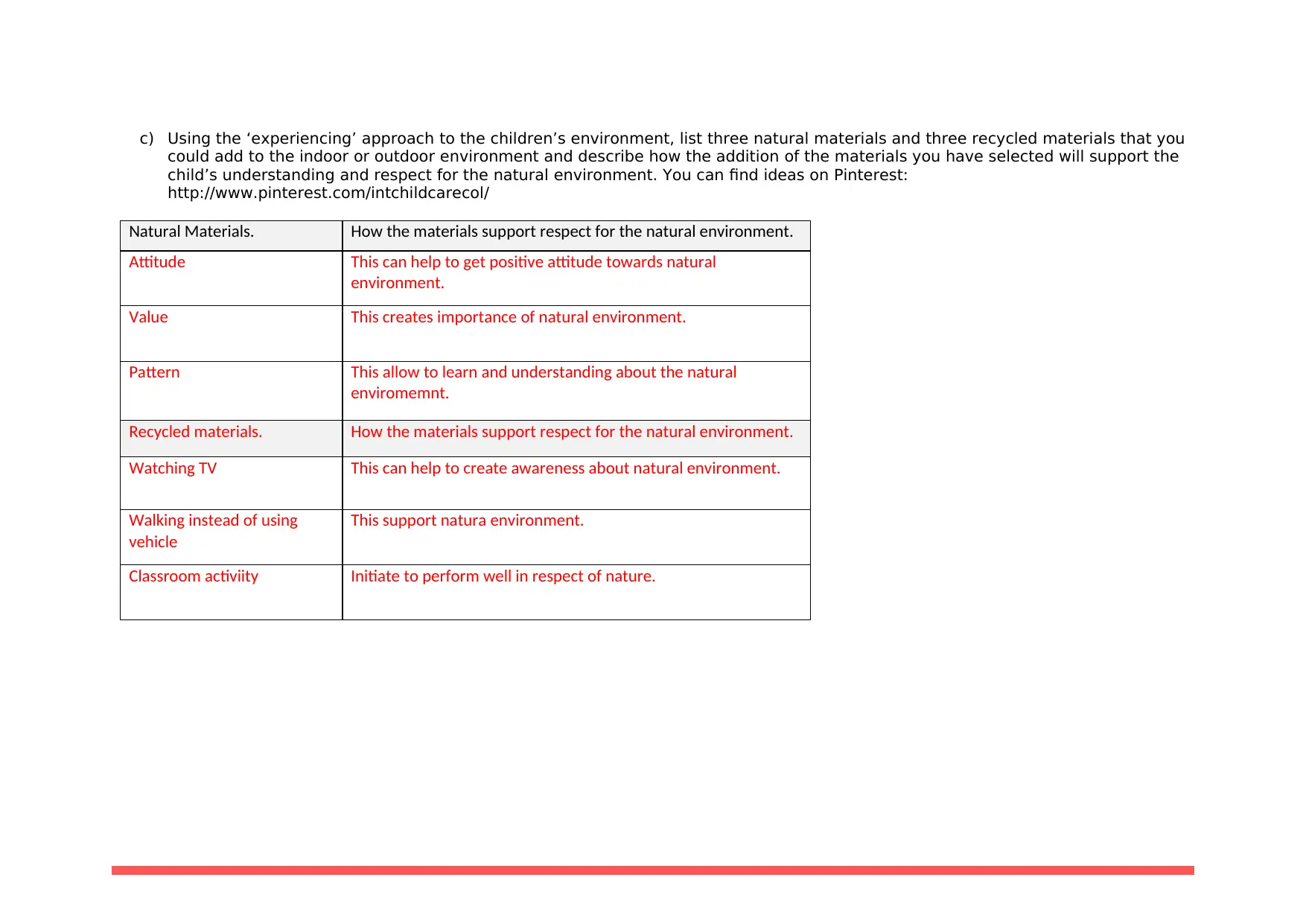
c) Using the ‘experiencing’ approach to the children’s environment, list three natural materials and three recycled materials that you
could add to the indoor or outdoor environment and describe how the addition of the materials you have selected will support the
child’s understanding and respect for the natural environment. You can find ideas on Pinterest:
http://www.pinterest.com/intchildcarecol/
Natural Materials. How the materials support respect for the natural environment.
Attitude This can help to get positive attitude towards natural
environment.
Value This creates importance of natural environment.
Pattern This allow to learn and understanding about the natural
enviromemnt.
Recycled materials. How the materials support respect for the natural environment.
Watching TV This can help to create awareness about natural environment.
Walking instead of using
vehicle
This support natura environment.
Classroom activiity Initiate to perform well in respect of nature.
could add to the indoor or outdoor environment and describe how the addition of the materials you have selected will support the
child’s understanding and respect for the natural environment. You can find ideas on Pinterest:
http://www.pinterest.com/intchildcarecol/
Natural Materials. How the materials support respect for the natural environment.
Attitude This can help to get positive attitude towards natural
environment.
Value This creates importance of natural environment.
Pattern This allow to learn and understanding about the natural
enviromemnt.
Recycled materials. How the materials support respect for the natural environment.
Watching TV This can help to create awareness about natural environment.
Walking instead of using
vehicle
This support natura environment.
Classroom activiity Initiate to perform well in respect of nature.
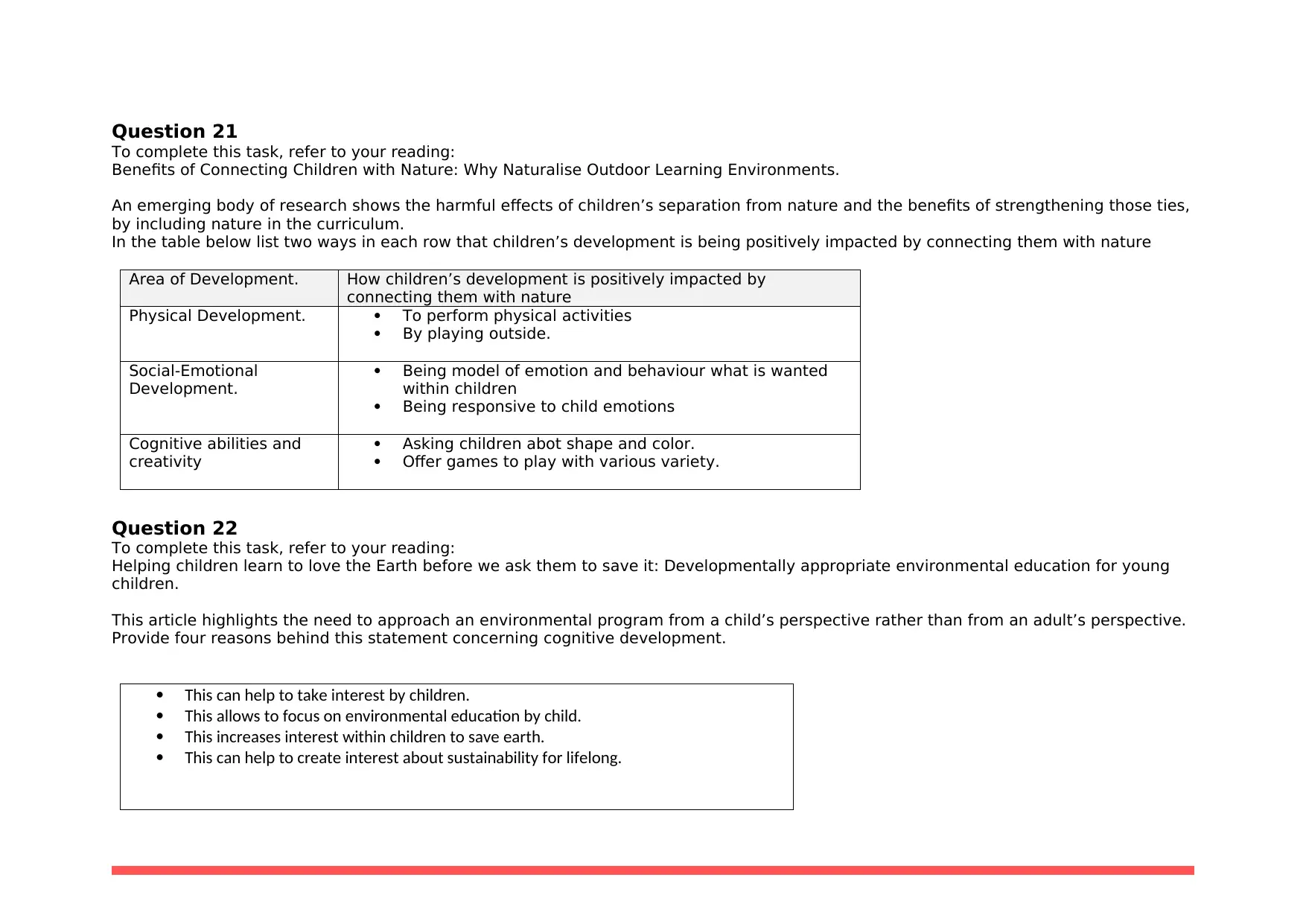
Question 21
To complete this task, refer to your reading:
Benefits of Connecting Children with Nature: Why Naturalise Outdoor Learning Environments.
An emerging body of research shows the harmful effects of children’s separation from nature and the benefits of strengthening those ties,
by including nature in the curriculum.
In the table below list two ways in each row that children’s development is being positively impacted by connecting them with nature
Area of Development. How children’s development is positively impacted by
connecting them with nature
Physical Development. To perform physical activities
By playing outside.
Social-Emotional
Development.
Being model of emotion and behaviour what is wanted
within children
Being responsive to child emotions
Cognitive abilities and
creativity
Asking children abot shape and color.
Offer games to play with various variety.
Question 22
To complete this task, refer to your reading:
Helping children learn to love the Earth before we ask them to save it: Developmentally appropriate environmental education for young
children.
This article highlights the need to approach an environmental program from a child’s perspective rather than from an adult’s perspective.
Provide four reasons behind this statement concerning cognitive development.
This can help to take interest by children.
This allows to focus on environmental education by child.
This increases interest within children to save earth.
This can help to create interest about sustainability for lifelong.
To complete this task, refer to your reading:
Benefits of Connecting Children with Nature: Why Naturalise Outdoor Learning Environments.
An emerging body of research shows the harmful effects of children’s separation from nature and the benefits of strengthening those ties,
by including nature in the curriculum.
In the table below list two ways in each row that children’s development is being positively impacted by connecting them with nature
Area of Development. How children’s development is positively impacted by
connecting them with nature
Physical Development. To perform physical activities
By playing outside.
Social-Emotional
Development.
Being model of emotion and behaviour what is wanted
within children
Being responsive to child emotions
Cognitive abilities and
creativity
Asking children abot shape and color.
Offer games to play with various variety.
Question 22
To complete this task, refer to your reading:
Helping children learn to love the Earth before we ask them to save it: Developmentally appropriate environmental education for young
children.
This article highlights the need to approach an environmental program from a child’s perspective rather than from an adult’s perspective.
Provide four reasons behind this statement concerning cognitive development.
This can help to take interest by children.
This allows to focus on environmental education by child.
This increases interest within children to save earth.
This can help to create interest about sustainability for lifelong.
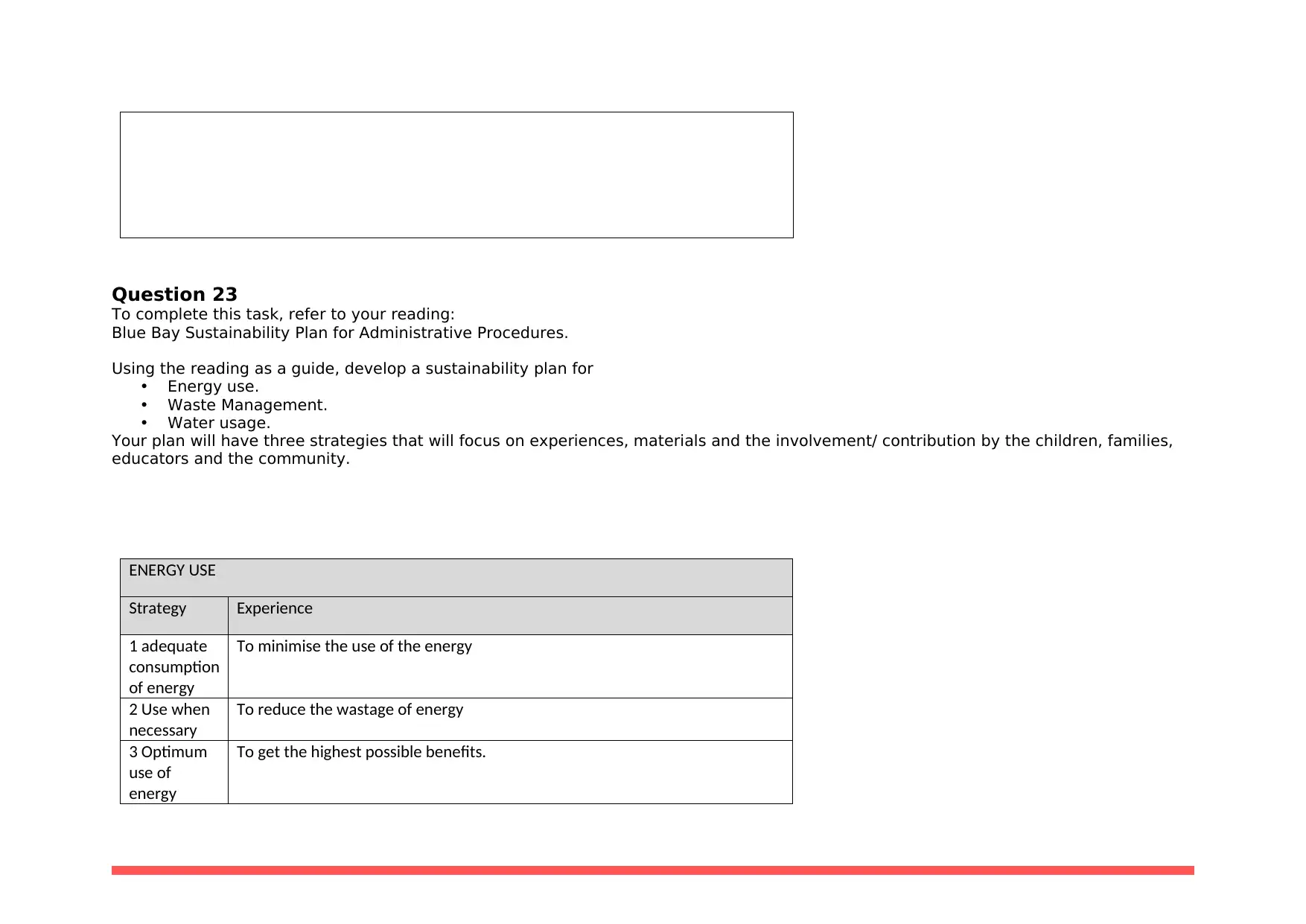
Question 23
To complete this task, refer to your reading:
Blue Bay Sustainability Plan for Administrative Procedures.
Using the reading as a guide, develop a sustainability plan for
• Energy use.
• Waste Management.
• Water usage.
Your plan will have three strategies that will focus on experiences, materials and the involvement/ contribution by the children, families,
educators and the community.
ENERGY USE
Strategy Experience
1 adequate
consumption
of energy
To minimise the use of the energy
2 Use when
necessary
To reduce the wastage of energy
3 Optimum
use of
energy
To get the highest possible benefits.
To complete this task, refer to your reading:
Blue Bay Sustainability Plan for Administrative Procedures.
Using the reading as a guide, develop a sustainability plan for
• Energy use.
• Waste Management.
• Water usage.
Your plan will have three strategies that will focus on experiences, materials and the involvement/ contribution by the children, families,
educators and the community.
ENERGY USE
Strategy Experience
1 adequate
consumption
of energy
To minimise the use of the energy
2 Use when
necessary
To reduce the wastage of energy
3 Optimum
use of
energy
To get the highest possible benefits.
Secure Best Marks with AI Grader
Need help grading? Try our AI Grader for instant feedback on your assignments.
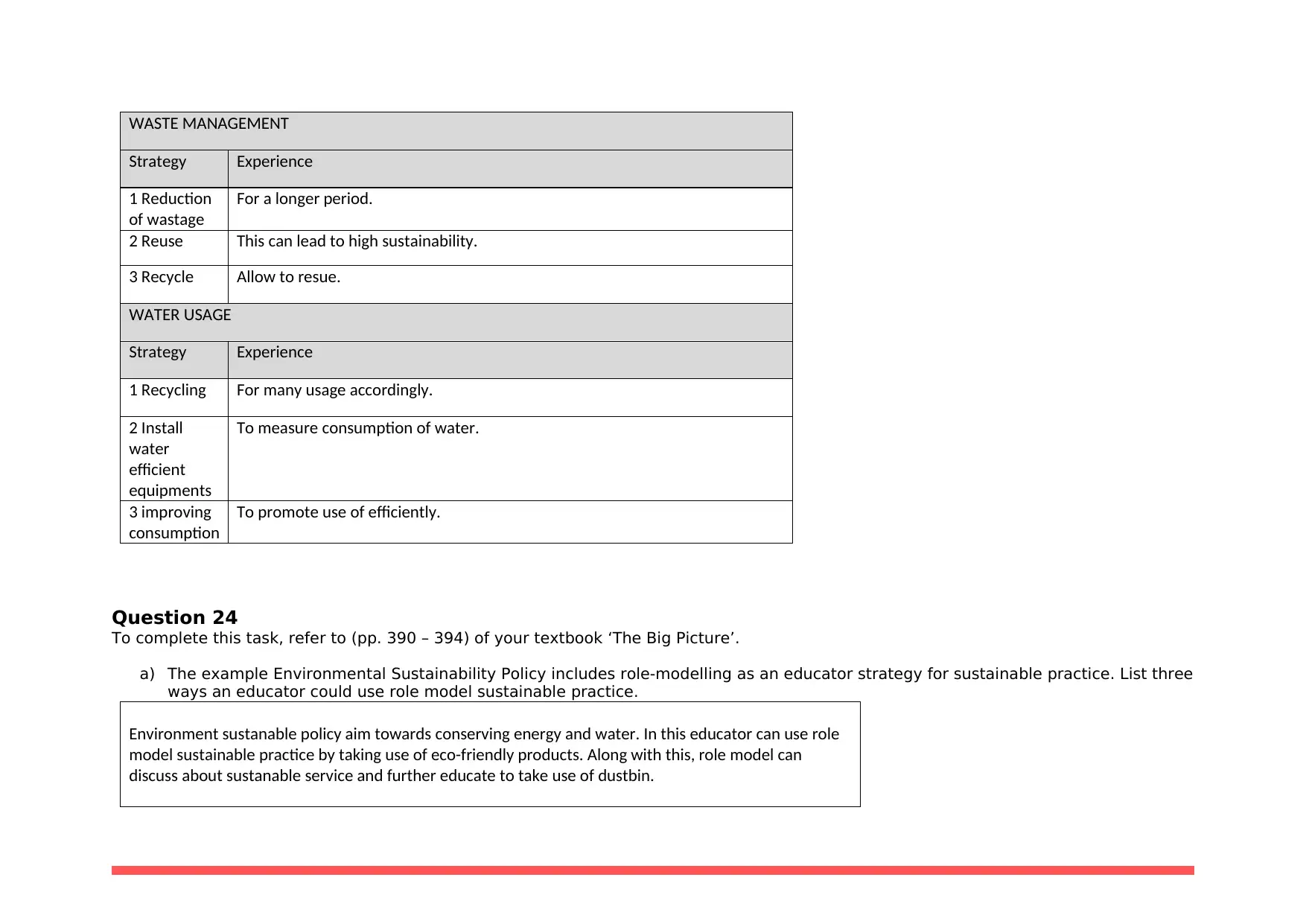
WASTE MANAGEMENT
Strategy Experience
1 Reduction
of wastage
For a longer period.
2 Reuse This can lead to high sustainability.
3 Recycle Allow to resue.
WATER USAGE
Strategy Experience
1 Recycling For many usage accordingly.
2 Install
water
efficient
equipments
To measure consumption of water.
3 improving
consumption
To promote use of efficiently.
Question 24
To complete this task, refer to (pp. 390 – 394) of your textbook ‘The Big Picture’.
a) The example Environmental Sustainability Policy includes role-modelling as an educator strategy for sustainable practice. List three
ways an educator could use role model sustainable practice.
Environment sustanable policy aim towards conserving energy and water. In this educator can use role
model sustainable practice by taking use of eco-friendly products. Along with this, role model can
discuss about sustanable service and further educate to take use of dustbin.
Strategy Experience
1 Reduction
of wastage
For a longer period.
2 Reuse This can lead to high sustainability.
3 Recycle Allow to resue.
WATER USAGE
Strategy Experience
1 Recycling For many usage accordingly.
2 Install
water
efficient
equipments
To measure consumption of water.
3 improving
consumption
To promote use of efficiently.
Question 24
To complete this task, refer to (pp. 390 – 394) of your textbook ‘The Big Picture’.
a) The example Environmental Sustainability Policy includes role-modelling as an educator strategy for sustainable practice. List three
ways an educator could use role model sustainable practice.
Environment sustanable policy aim towards conserving energy and water. In this educator can use role
model sustainable practice by taking use of eco-friendly products. Along with this, role model can
discuss about sustanable service and further educate to take use of dustbin.
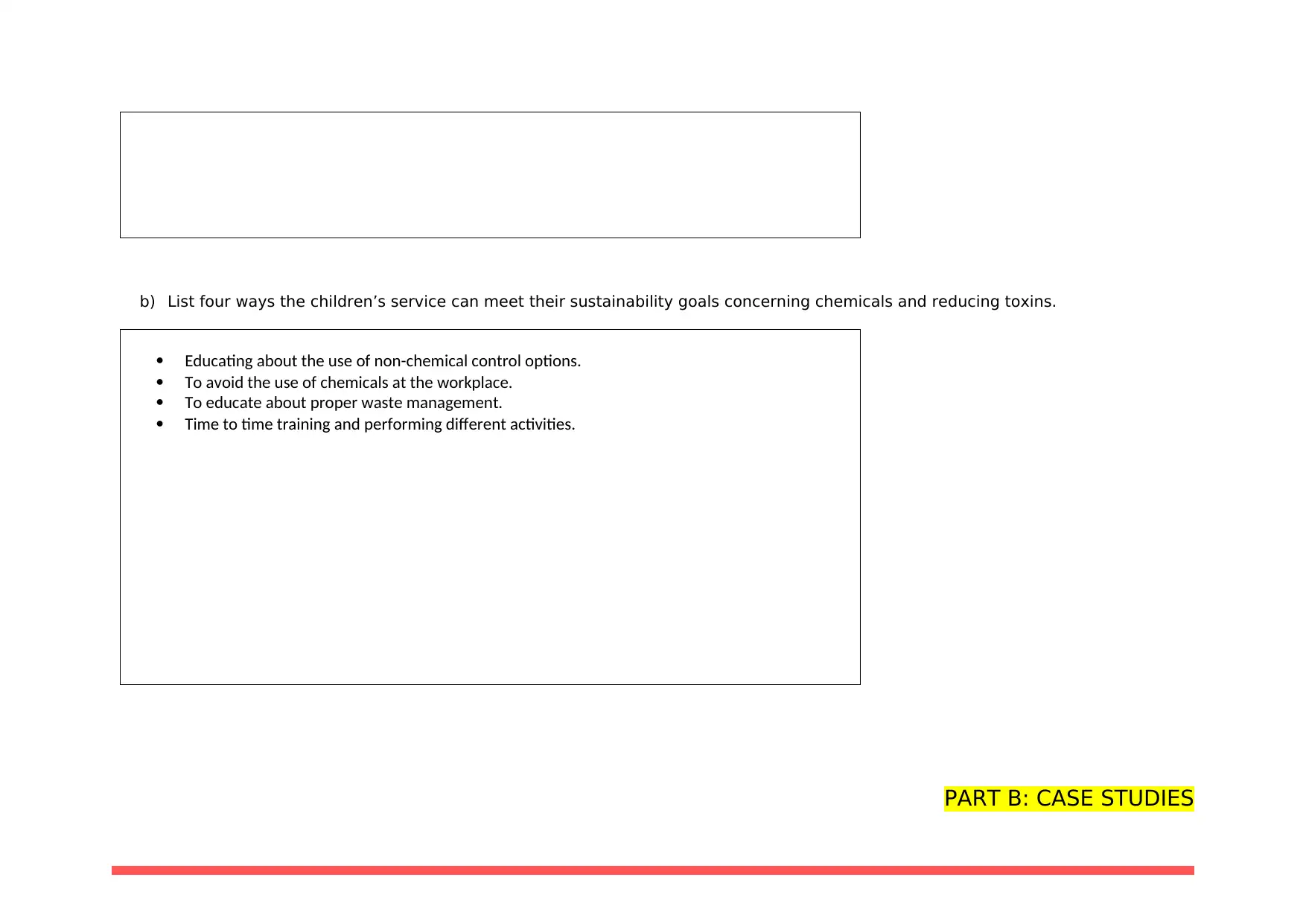
b) List four ways the children’s service can meet their sustainability goals concerning chemicals and reducing toxins.
Educating about the use of non-chemical control options.
To avoid the use of chemicals at the workplace.
To educate about proper waste management.
Time to time training and performing different activities.
PART B: CASE STUDIES
Educating about the use of non-chemical control options.
To avoid the use of chemicals at the workplace.
To educate about proper waste management.
Time to time training and performing different activities.
PART B: CASE STUDIES
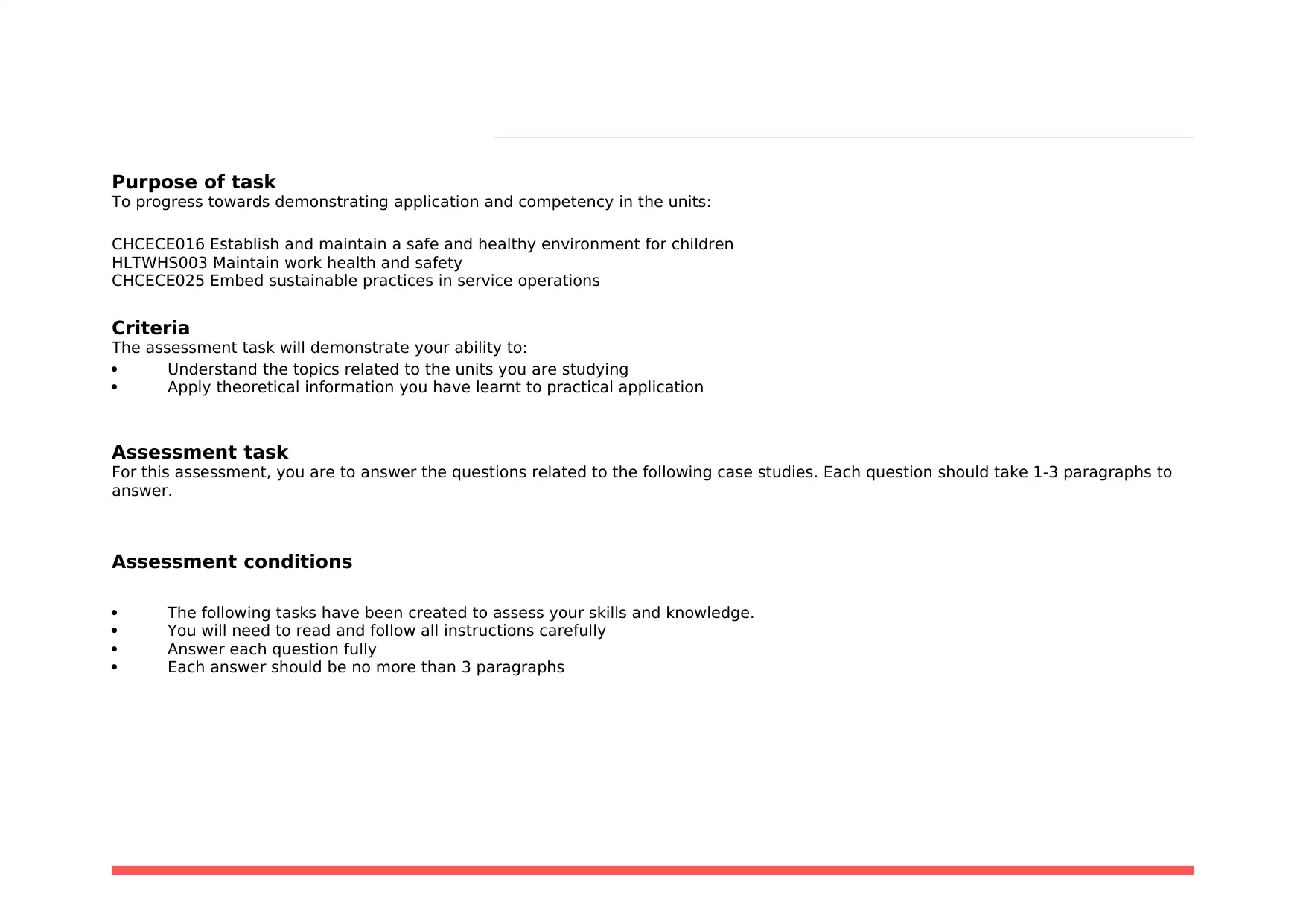
Purpose of task
To progress towards demonstrating application and competency in the units:
CHCECE016 Establish and maintain a safe and healthy environment for children
HLTWHS003 Maintain work health and safety
CHCECE025 Embed sustainable practices in service operations
Criteria
The assessment task will demonstrate your ability to:
Understand the topics related to the units you are studying
Apply theoretical information you have learnt to practical application
Assessment task
For this assessment, you are to answer the questions related to the following case studies. Each question should take 1-3 paragraphs to
answer.
Assessment conditions
The following tasks have been created to assess your skills and knowledge.
You will need to read and follow all instructions carefully
Answer each question fully
Each answer should be no more than 3 paragraphs
To progress towards demonstrating application and competency in the units:
CHCECE016 Establish and maintain a safe and healthy environment for children
HLTWHS003 Maintain work health and safety
CHCECE025 Embed sustainable practices in service operations
Criteria
The assessment task will demonstrate your ability to:
Understand the topics related to the units you are studying
Apply theoretical information you have learnt to practical application
Assessment task
For this assessment, you are to answer the questions related to the following case studies. Each question should take 1-3 paragraphs to
answer.
Assessment conditions
The following tasks have been created to assess your skills and knowledge.
You will need to read and follow all instructions carefully
Answer each question fully
Each answer should be no more than 3 paragraphs
Paraphrase This Document
Need a fresh take? Get an instant paraphrase of this document with our AI Paraphraser
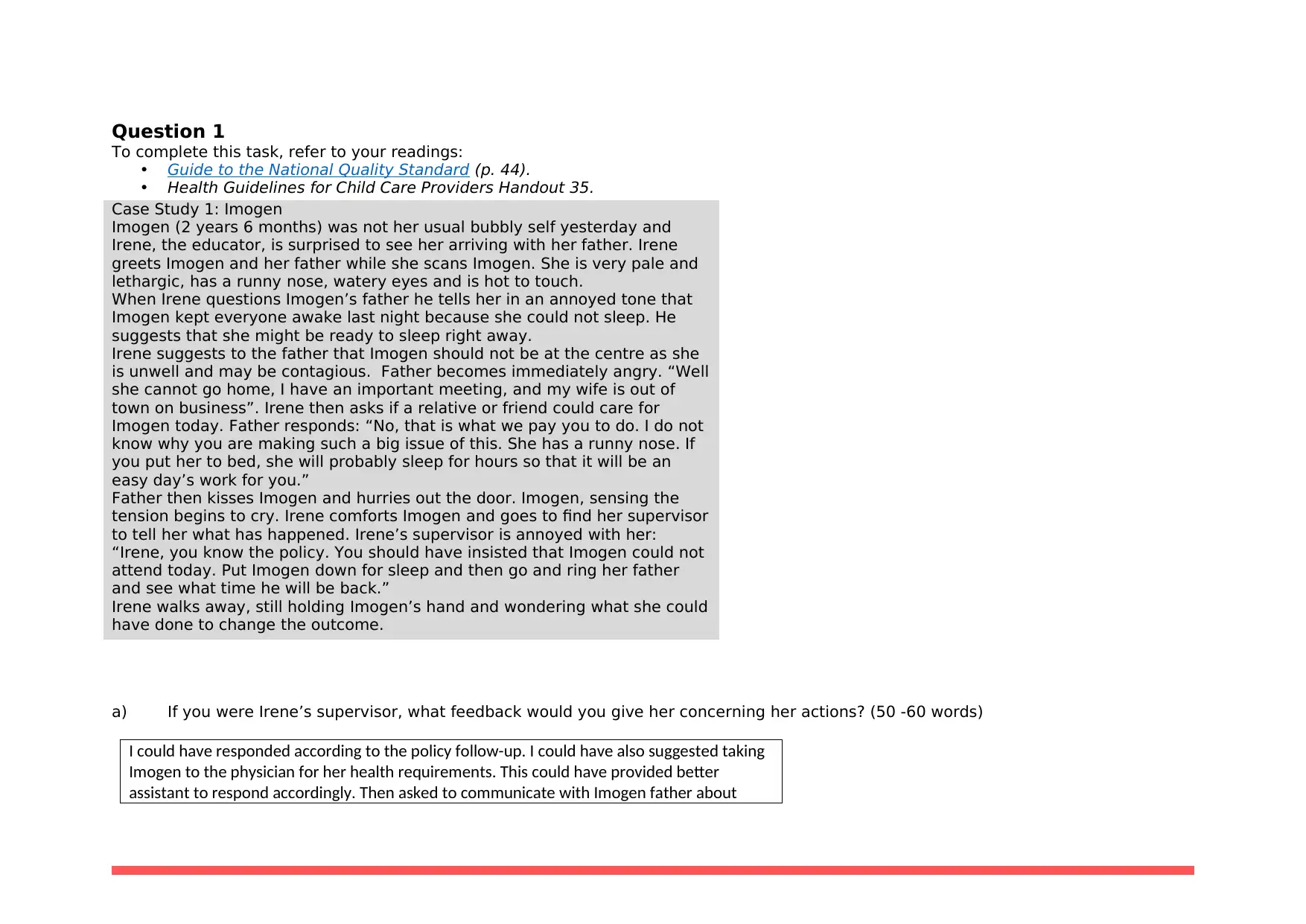
Question 1
To complete this task, refer to your readings:
• Guide to the National Quality Standard (p. 44).
• Health Guidelines for Child Care Providers Handout 35.
a) If you were Irene’s supervisor, what feedback would you give her concerning her actions? (50 -60 words)
I could have responded according to the policy follow-up. I could have also suggested taking
Imogen to the physician for her health requirements. This could have provided better
assistant to respond accordingly. Then asked to communicate with Imogen father about
Case Study 1: Imogen
Imogen (2 years 6 months) was not her usual bubbly self yesterday and
Irene, the educator, is surprised to see her arriving with her father. Irene
greets Imogen and her father while she scans Imogen. She is very pale and
lethargic, has a runny nose, watery eyes and is hot to touch.
When Irene questions Imogen’s father he tells her in an annoyed tone that
Imogen kept everyone awake last night because she could not sleep. He
suggests that she might be ready to sleep right away.
Irene suggests to the father that Imogen should not be at the centre as she
is unwell and may be contagious. Father becomes immediately angry. “Well
she cannot go home, I have an important meeting, and my wife is out of
town on business”. Irene then asks if a relative or friend could care for
Imogen today. Father responds: “No, that is what we pay you to do. I do not
know why you are making such a big issue of this. She has a runny nose. If
you put her to bed, she will probably sleep for hours so that it will be an
easy day’s work for you.”
Father then kisses Imogen and hurries out the door. Imogen, sensing the
tension begins to cry. Irene comforts Imogen and goes to find her supervisor
to tell her what has happened. Irene’s supervisor is annoyed with her:
“Irene, you know the policy. You should have insisted that Imogen could not
attend today. Put Imogen down for sleep and then go and ring her father
and see what time he will be back.”
Irene walks away, still holding Imogen’s hand and wondering what she could
have done to change the outcome.
To complete this task, refer to your readings:
• Guide to the National Quality Standard (p. 44).
• Health Guidelines for Child Care Providers Handout 35.
a) If you were Irene’s supervisor, what feedback would you give her concerning her actions? (50 -60 words)
I could have responded according to the policy follow-up. I could have also suggested taking
Imogen to the physician for her health requirements. This could have provided better
assistant to respond accordingly. Then asked to communicate with Imogen father about
Case Study 1: Imogen
Imogen (2 years 6 months) was not her usual bubbly self yesterday and
Irene, the educator, is surprised to see her arriving with her father. Irene
greets Imogen and her father while she scans Imogen. She is very pale and
lethargic, has a runny nose, watery eyes and is hot to touch.
When Irene questions Imogen’s father he tells her in an annoyed tone that
Imogen kept everyone awake last night because she could not sleep. He
suggests that she might be ready to sleep right away.
Irene suggests to the father that Imogen should not be at the centre as she
is unwell and may be contagious. Father becomes immediately angry. “Well
she cannot go home, I have an important meeting, and my wife is out of
town on business”. Irene then asks if a relative or friend could care for
Imogen today. Father responds: “No, that is what we pay you to do. I do not
know why you are making such a big issue of this. She has a runny nose. If
you put her to bed, she will probably sleep for hours so that it will be an
easy day’s work for you.”
Father then kisses Imogen and hurries out the door. Imogen, sensing the
tension begins to cry. Irene comforts Imogen and goes to find her supervisor
to tell her what has happened. Irene’s supervisor is annoyed with her:
“Irene, you know the policy. You should have insisted that Imogen could not
attend today. Put Imogen down for sleep and then go and ring her father
and see what time he will be back.”
Irene walks away, still holding Imogen’s hand and wondering what she could
have done to change the outcome.

returning time.

b) What element in Quality Area 2 was Irene implementing when she suggested that Imogen should not be at the service because she
was unwell and possibly contagious? (25 – 50 words)
Standard 2.2.3 child protection where management, educator or staff should be aware of
their roles and responsibility for identifying the risk of abuse or neglect. This can help to
provide better protection to child.
was unwell and possibly contagious? (25 – 50 words)
Standard 2.2.3 child protection where management, educator or staff should be aware of
their roles and responsibility for identifying the risk of abuse or neglect. This can help to
provide better protection to child.
Secure Best Marks with AI Grader
Need help grading? Try our AI Grader for instant feedback on your assignments.

Question 2
Reflect and draw on the knowledge you have acquired from the text and readings in this unit to answer the following questions.
Case Study 2: Alexander
Alexander Brown (4 years 2 months) has a heart defect (ventricular septal
defect). Although Alexander has had the hole in his heart repaired, he still must
be closely monitored. Because his heart has had to work harder, it is enlarged
and he sometimes experiences symptoms such as breathlessness and increased
heart rate. His parents always worry about him contracting childhood diseases
such as colds and chest infections.
Alexander’s mother was not keen to enrol him at the local preschool, but his
father insisted that Alexander be allowed to mix with other children and do
‘normal things’.
At the enrolment meeting with the educator Sarah, Mrs Brown explains that
Alexander needs to be monitored throughout the day so that he does not
overexert himself.
Mrs Brown: “I think it would be best if you kept Alexander inside so that he is not
tempted to run around.’
Mr Brown, sounding annoyed says: ‘You know the doctor said it would be fine for
him to play outside. We cannot wrap him up in cotton wool. It is not fair to
Alexander.”
Mrs Brown looks down, “I know, I just worry about him.”
Mr Brown: “We both worry about him, but I am sure the staff here can keep a
close eye on him and remind him not to overdo it.”
Sarah has been listening to the exchange between the Browns, “Can you tell me
what it is safe for Alexander to do? We could go for a walk around the outdoor
area and take a look at the equipment the children use then you can point out to
me anything that you feel might be too strenuous for him.” Mr Brown nods and
Mrs Brown smiles, “Yes, that sounds like a good idea.”
Sarah explains to the Browns that they will need to provide a medical
management plan from Alexander’s doctor. ”We can then work together to
develop a risk minimisation plan which will clearly outline Alexander’s abilities
and limitations. We make the plan available to all the educators so that they
understand Alexander’s specific care needs. The plan also documents how often
we will review our care plan and how we communicate any concerns or new
information that we both need to consider.”
Mrs Brown: “Wow, it sounds like you have given the care of sick children a great
deal of thought! It is very reassuring. It makes me feel like you will be able to
take good care of my boy.”
As Sarah walks around with the Browns and talks about the activities that take
place outdoors, she reflects on how hard it must be for the Brown’s to trust
others to care for Alexander.
Reflect and draw on the knowledge you have acquired from the text and readings in this unit to answer the following questions.
Case Study 2: Alexander
Alexander Brown (4 years 2 months) has a heart defect (ventricular septal
defect). Although Alexander has had the hole in his heart repaired, he still must
be closely monitored. Because his heart has had to work harder, it is enlarged
and he sometimes experiences symptoms such as breathlessness and increased
heart rate. His parents always worry about him contracting childhood diseases
such as colds and chest infections.
Alexander’s mother was not keen to enrol him at the local preschool, but his
father insisted that Alexander be allowed to mix with other children and do
‘normal things’.
At the enrolment meeting with the educator Sarah, Mrs Brown explains that
Alexander needs to be monitored throughout the day so that he does not
overexert himself.
Mrs Brown: “I think it would be best if you kept Alexander inside so that he is not
tempted to run around.’
Mr Brown, sounding annoyed says: ‘You know the doctor said it would be fine for
him to play outside. We cannot wrap him up in cotton wool. It is not fair to
Alexander.”
Mrs Brown looks down, “I know, I just worry about him.”
Mr Brown: “We both worry about him, but I am sure the staff here can keep a
close eye on him and remind him not to overdo it.”
Sarah has been listening to the exchange between the Browns, “Can you tell me
what it is safe for Alexander to do? We could go for a walk around the outdoor
area and take a look at the equipment the children use then you can point out to
me anything that you feel might be too strenuous for him.” Mr Brown nods and
Mrs Brown smiles, “Yes, that sounds like a good idea.”
Sarah explains to the Browns that they will need to provide a medical
management plan from Alexander’s doctor. ”We can then work together to
develop a risk minimisation plan which will clearly outline Alexander’s abilities
and limitations. We make the plan available to all the educators so that they
understand Alexander’s specific care needs. The plan also documents how often
we will review our care plan and how we communicate any concerns or new
information that we both need to consider.”
Mrs Brown: “Wow, it sounds like you have given the care of sick children a great
deal of thought! It is very reassuring. It makes me feel like you will be able to
take good care of my boy.”
As Sarah walks around with the Browns and talks about the activities that take
place outdoors, she reflects on how hard it must be for the Brown’s to trust
others to care for Alexander.
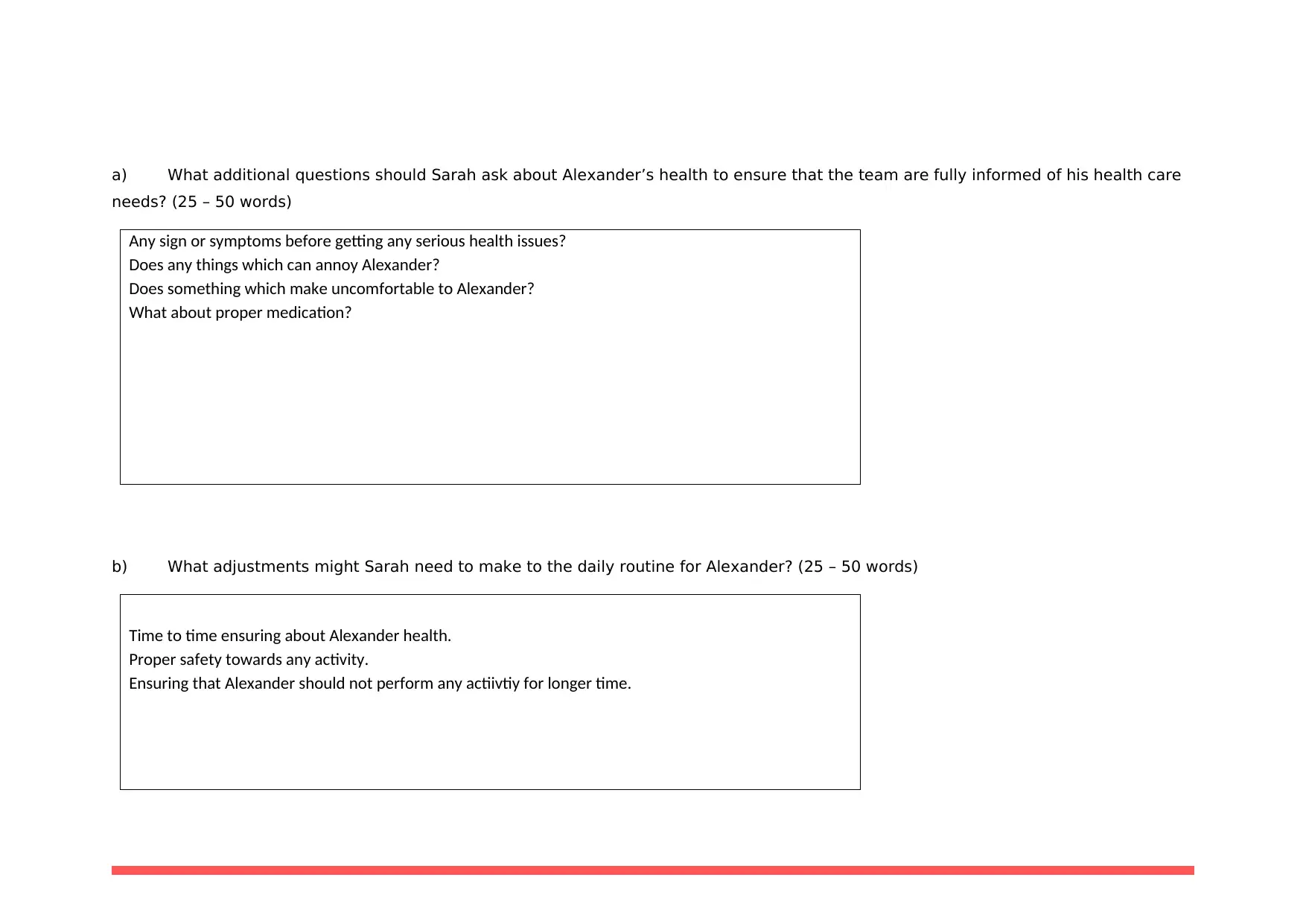
a) What additional questions should Sarah ask about Alexander’s health to ensure that the team are fully informed of his health care
needs? (25 – 50 words)
Any sign or symptoms before getting any serious health issues?
Does any things which can annoy Alexander?
Does something which make uncomfortable to Alexander?
What about proper medication?
b) What adjustments might Sarah need to make to the daily routine for Alexander? (25 – 50 words)
Time to time ensuring about Alexander health.
Proper safety towards any activity.
Ensuring that Alexander should not perform any actiivtiy for longer time.
needs? (25 – 50 words)
Any sign or symptoms before getting any serious health issues?
Does any things which can annoy Alexander?
Does something which make uncomfortable to Alexander?
What about proper medication?
b) What adjustments might Sarah need to make to the daily routine for Alexander? (25 – 50 words)
Time to time ensuring about Alexander health.
Proper safety towards any activity.
Ensuring that Alexander should not perform any actiivtiy for longer time.
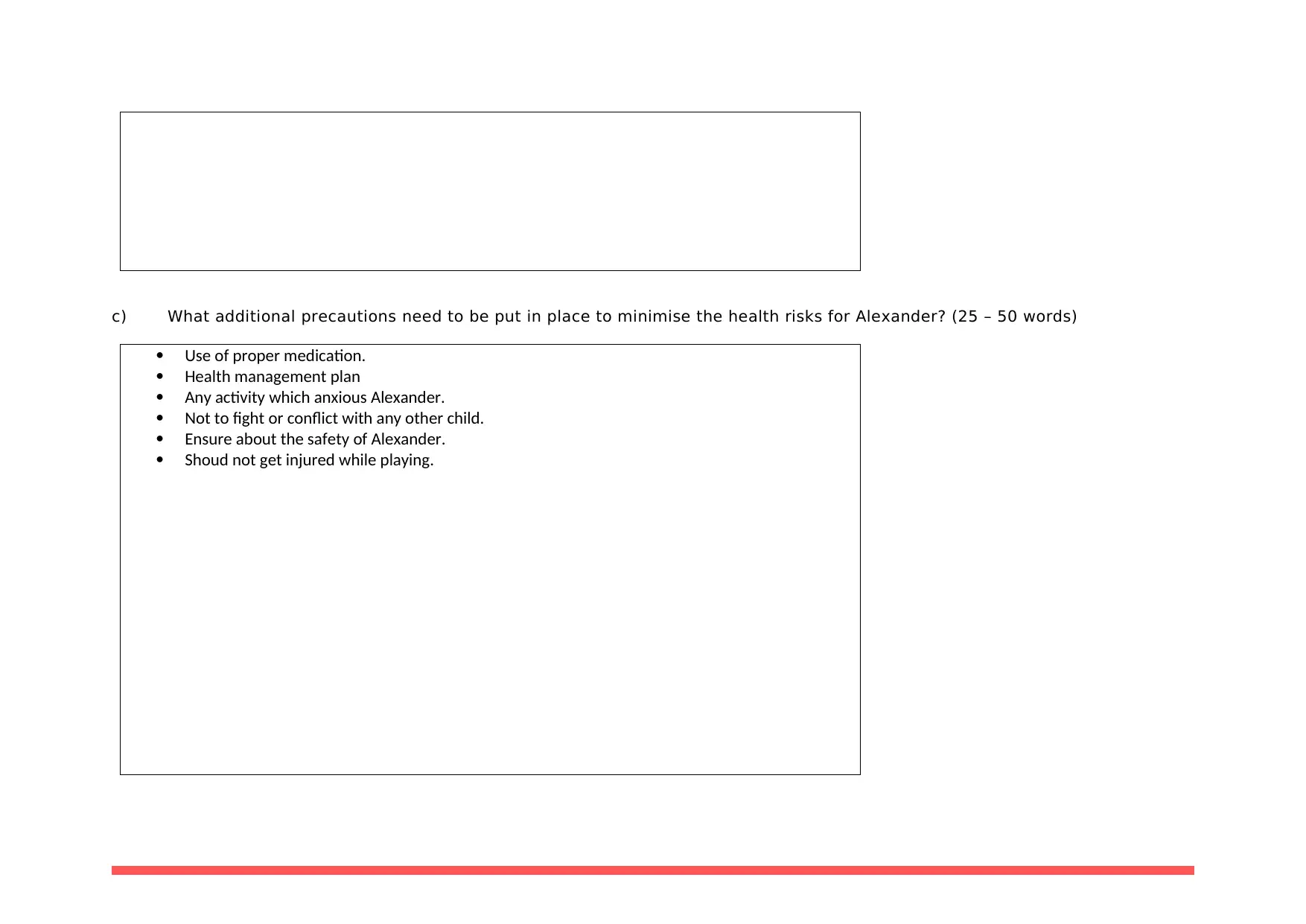
c) What additional precautions need to be put in place to minimise the health risks for Alexander? (25 – 50 words)
Use of proper medication.
Health management plan
Any activity which anxious Alexander.
Not to fight or conflict with any other child.
Ensure about the safety of Alexander.
Shoud not get injured while playing.
Use of proper medication.
Health management plan
Any activity which anxious Alexander.
Not to fight or conflict with any other child.
Ensure about the safety of Alexander.
Shoud not get injured while playing.
Paraphrase This Document
Need a fresh take? Get an instant paraphrase of this document with our AI Paraphraser

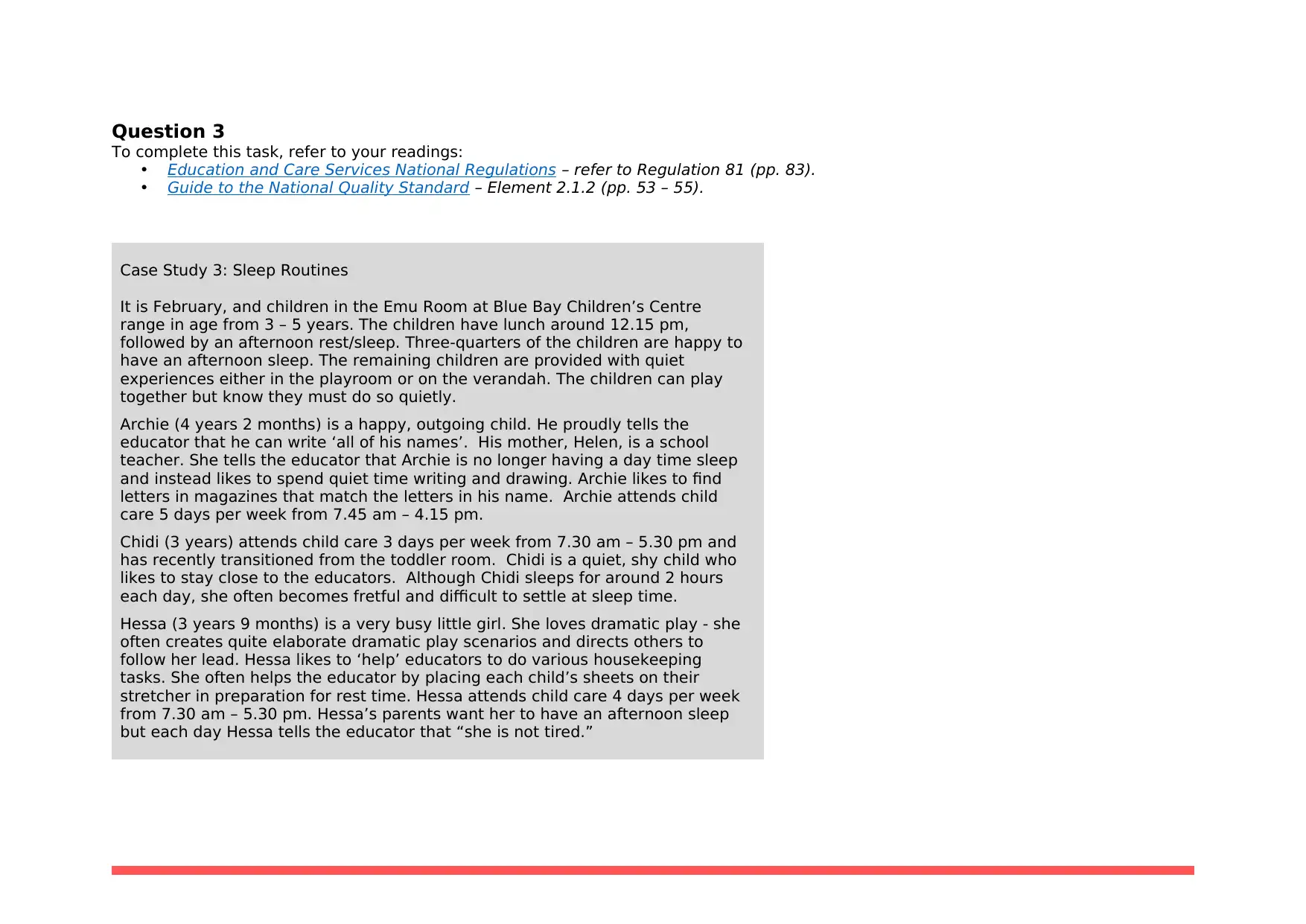
Question 3
To complete this task, refer to your readings:
• Education and Care Services National Regulations – refer to Regulation 81 (pp. 83).
• Guide to the National Quality Standard – Element 2.1.2 (pp. 53 – 55).
Case Study 3: Sleep Routines
It is February, and children in the Emu Room at Blue Bay Children’s Centre
range in age from 3 – 5 years. The children have lunch around 12.15 pm,
followed by an afternoon rest/sleep. Three-quarters of the children are happy to
have an afternoon sleep. The remaining children are provided with quiet
experiences either in the playroom or on the verandah. The children can play
together but know they must do so quietly.
Archie (4 years 2 months) is a happy, outgoing child. He proudly tells the
educator that he can write ‘all of his names’. His mother, Helen, is a school
teacher. She tells the educator that Archie is no longer having a day time sleep
and instead likes to spend quiet time writing and drawing. Archie likes to find
letters in magazines that match the letters in his name. Archie attends child
care 5 days per week from 7.45 am – 4.15 pm.
Chidi (3 years) attends child care 3 days per week from 7.30 am – 5.30 pm and
has recently transitioned from the toddler room. Chidi is a quiet, shy child who
likes to stay close to the educators. Although Chidi sleeps for around 2 hours
each day, she often becomes fretful and difficult to settle at sleep time.
Hessa (3 years 9 months) is a very busy little girl. She loves dramatic play - she
often creates quite elaborate dramatic play scenarios and directs others to
follow her lead. Hessa likes to ‘help’ educators to do various housekeeping
tasks. She often helps the educator by placing each child’s sheets on their
stretcher in preparation for rest time. Hessa attends child care 4 days per week
from 7.30 am – 5.30 pm. Hessa’s parents want her to have an afternoon sleep
but each day Hessa tells the educator that “she is not tired.”
To complete this task, refer to your readings:
• Education and Care Services National Regulations – refer to Regulation 81 (pp. 83).
• Guide to the National Quality Standard – Element 2.1.2 (pp. 53 – 55).
Case Study 3: Sleep Routines
It is February, and children in the Emu Room at Blue Bay Children’s Centre
range in age from 3 – 5 years. The children have lunch around 12.15 pm,
followed by an afternoon rest/sleep. Three-quarters of the children are happy to
have an afternoon sleep. The remaining children are provided with quiet
experiences either in the playroom or on the verandah. The children can play
together but know they must do so quietly.
Archie (4 years 2 months) is a happy, outgoing child. He proudly tells the
educator that he can write ‘all of his names’. His mother, Helen, is a school
teacher. She tells the educator that Archie is no longer having a day time sleep
and instead likes to spend quiet time writing and drawing. Archie likes to find
letters in magazines that match the letters in his name. Archie attends child
care 5 days per week from 7.45 am – 4.15 pm.
Chidi (3 years) attends child care 3 days per week from 7.30 am – 5.30 pm and
has recently transitioned from the toddler room. Chidi is a quiet, shy child who
likes to stay close to the educators. Although Chidi sleeps for around 2 hours
each day, she often becomes fretful and difficult to settle at sleep time.
Hessa (3 years 9 months) is a very busy little girl. She loves dramatic play - she
often creates quite elaborate dramatic play scenarios and directs others to
follow her lead. Hessa likes to ‘help’ educators to do various housekeeping
tasks. She often helps the educator by placing each child’s sheets on their
stretcher in preparation for rest time. Hessa attends child care 4 days per week
from 7.30 am – 5.30 pm. Hessa’s parents want her to have an afternoon sleep
but each day Hessa tells the educator that “she is not tired.”
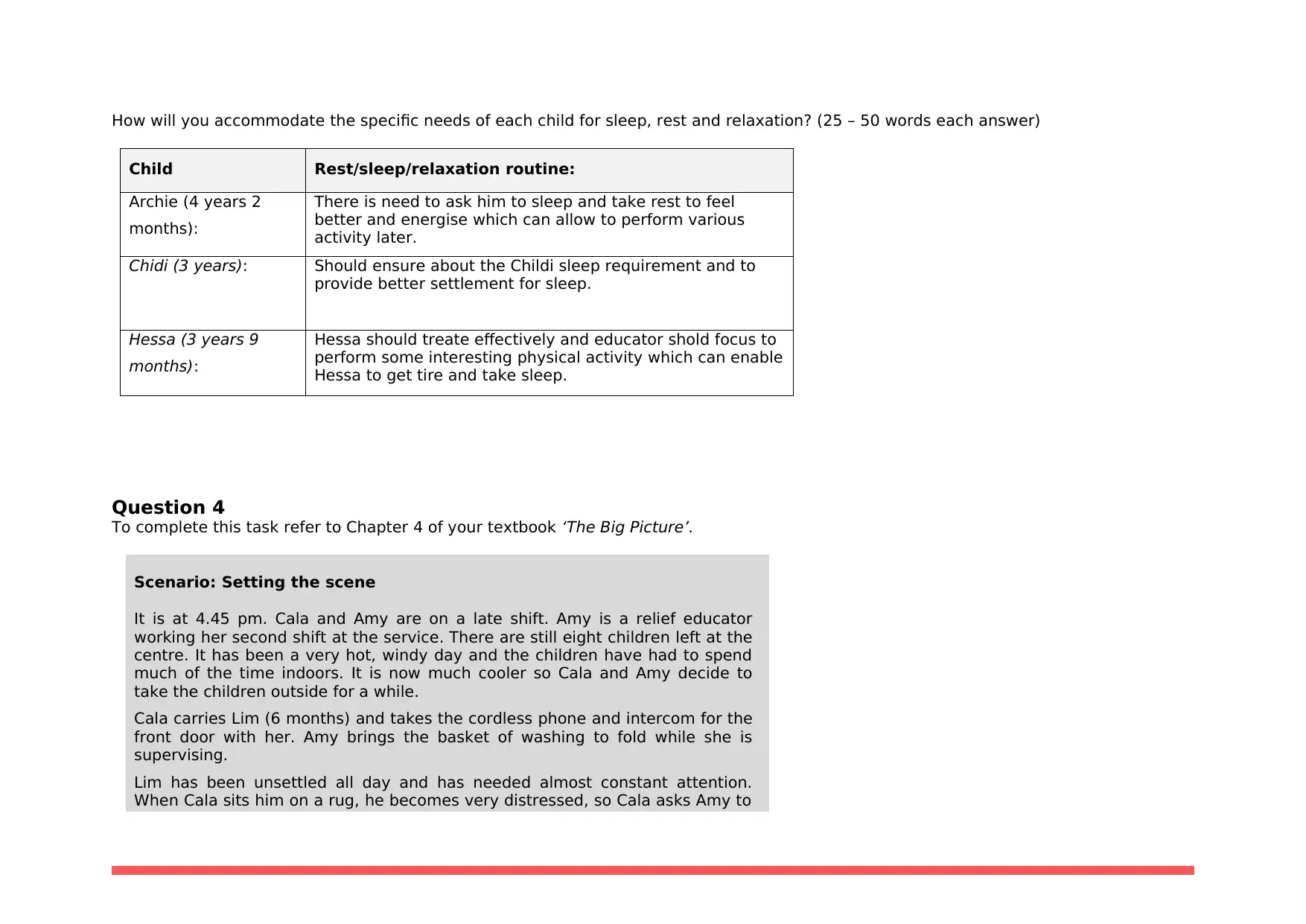
How will you accommodate the specific needs of each child for sleep, rest and relaxation? (25 – 50 words each answer)
Child Rest/sleep/relaxation routine:
Archie (4 years 2
months):
There is need to ask him to sleep and take rest to feel
better and energise which can allow to perform various
activity later.
Chidi (3 years): Should ensure about the Childi sleep requirement and to
provide better settlement for sleep.
Hessa (3 years 9
months):
Hessa should treate effectively and educator shold focus to
perform some interesting physical activity which can enable
Hessa to get tire and take sleep.
Question 4
To complete this task refer to Chapter 4 of your textbook ‘The Big Picture’.
Scenario: Setting the scene
It is at 4.45 pm. Cala and Amy are on a late shift. Amy is a relief educator
working her second shift at the service. There are still eight children left at the
centre. It has been a very hot, windy day and the children have had to spend
much of the time indoors. It is now much cooler so Cala and Amy decide to
take the children outside for a while.
Cala carries Lim (6 months) and takes the cordless phone and intercom for the
front door with her. Amy brings the basket of washing to fold while she is
supervising.
Lim has been unsettled all day and has needed almost constant attention.
When Cala sits him on a rug, he becomes very distressed, so Cala asks Amy to
Child Rest/sleep/relaxation routine:
Archie (4 years 2
months):
There is need to ask him to sleep and take rest to feel
better and energise which can allow to perform various
activity later.
Chidi (3 years): Should ensure about the Childi sleep requirement and to
provide better settlement for sleep.
Hessa (3 years 9
months):
Hessa should treate effectively and educator shold focus to
perform some interesting physical activity which can enable
Hessa to get tire and take sleep.
Question 4
To complete this task refer to Chapter 4 of your textbook ‘The Big Picture’.
Scenario: Setting the scene
It is at 4.45 pm. Cala and Amy are on a late shift. Amy is a relief educator
working her second shift at the service. There are still eight children left at the
centre. It has been a very hot, windy day and the children have had to spend
much of the time indoors. It is now much cooler so Cala and Amy decide to
take the children outside for a while.
Cala carries Lim (6 months) and takes the cordless phone and intercom for the
front door with her. Amy brings the basket of washing to fold while she is
supervising.
Lim has been unsettled all day and has needed almost constant attention.
When Cala sits him on a rug, he becomes very distressed, so Cala asks Amy to
Secure Best Marks with AI Grader
Need help grading? Try our AI Grader for instant feedback on your assignments.
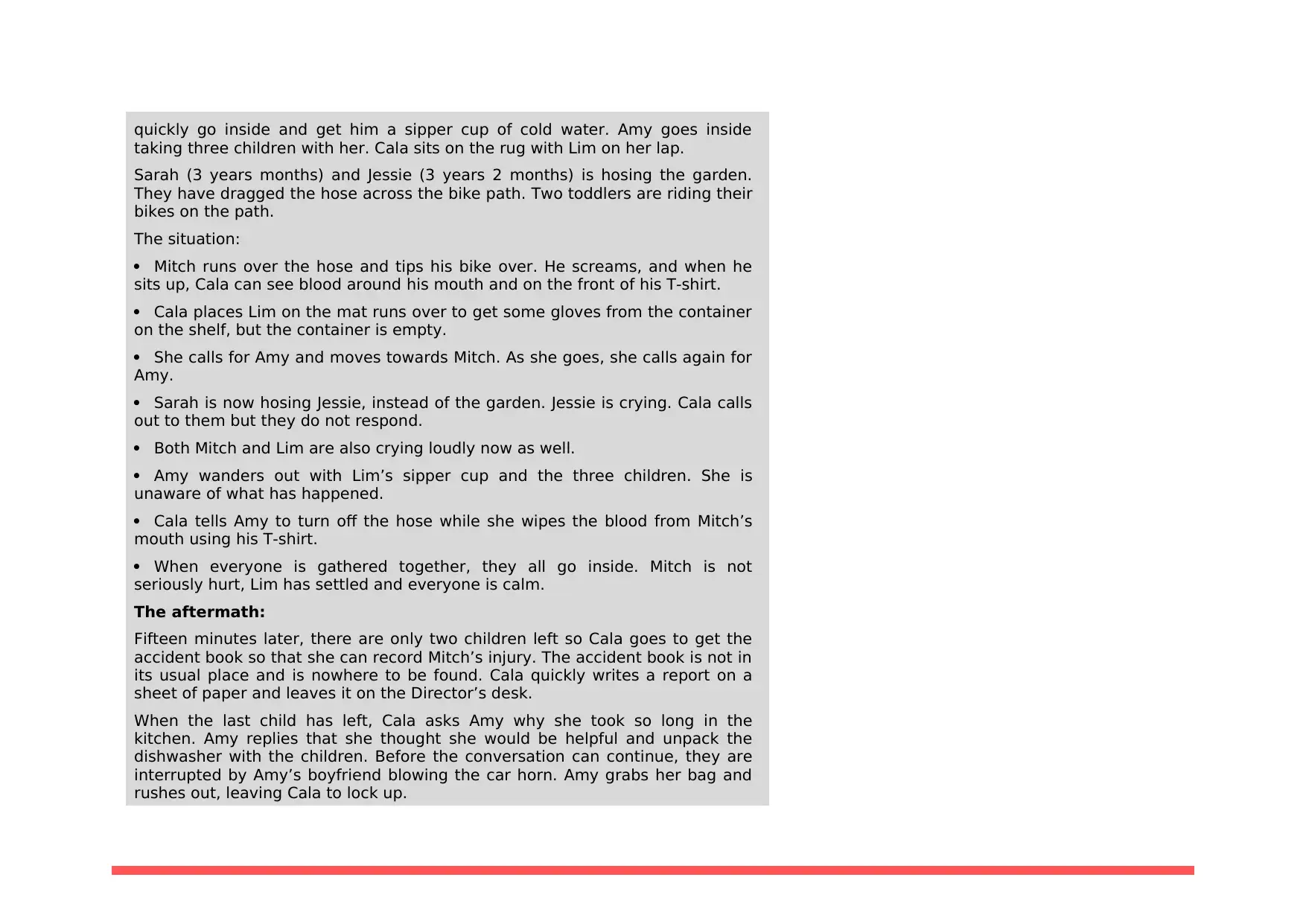
quickly go inside and get him a sipper cup of cold water. Amy goes inside
taking three children with her. Cala sits on the rug with Lim on her lap.
Sarah (3 years months) and Jessie (3 years 2 months) is hosing the garden.
They have dragged the hose across the bike path. Two toddlers are riding their
bikes on the path.
The situation:
Mitch runs over the hose and tips his bike over. He screams, and when he
sits up, Cala can see blood around his mouth and on the front of his T-shirt.
Cala places Lim on the mat runs over to get some gloves from the container
on the shelf, but the container is empty.
She calls for Amy and moves towards Mitch. As she goes, she calls again for
Amy.
Sarah is now hosing Jessie, instead of the garden. Jessie is crying. Cala calls
out to them but they do not respond.
Both Mitch and Lim are also crying loudly now as well.
Amy wanders out with Lim’s sipper cup and the three children. She is
unaware of what has happened.
Cala tells Amy to turn off the hose while she wipes the blood from Mitch’s
mouth using his T-shirt.
When everyone is gathered together, they all go inside. Mitch is not
seriously hurt, Lim has settled and everyone is calm.
The aftermath:
Fifteen minutes later, there are only two children left so Cala goes to get the
accident book so that she can record Mitch’s injury. The accident book is not in
its usual place and is nowhere to be found. Cala quickly writes a report on a
sheet of paper and leaves it on the Director’s desk.
When the last child has left, Cala asks Amy why she took so long in the
kitchen. Amy replies that she thought she would be helpful and unpack the
dishwasher with the children. Before the conversation can continue, they are
interrupted by Amy’s boyfriend blowing the car horn. Amy grabs her bag and
rushes out, leaving Cala to lock up.
taking three children with her. Cala sits on the rug with Lim on her lap.
Sarah (3 years months) and Jessie (3 years 2 months) is hosing the garden.
They have dragged the hose across the bike path. Two toddlers are riding their
bikes on the path.
The situation:
Mitch runs over the hose and tips his bike over. He screams, and when he
sits up, Cala can see blood around his mouth and on the front of his T-shirt.
Cala places Lim on the mat runs over to get some gloves from the container
on the shelf, but the container is empty.
She calls for Amy and moves towards Mitch. As she goes, she calls again for
Amy.
Sarah is now hosing Jessie, instead of the garden. Jessie is crying. Cala calls
out to them but they do not respond.
Both Mitch and Lim are also crying loudly now as well.
Amy wanders out with Lim’s sipper cup and the three children. She is
unaware of what has happened.
Cala tells Amy to turn off the hose while she wipes the blood from Mitch’s
mouth using his T-shirt.
When everyone is gathered together, they all go inside. Mitch is not
seriously hurt, Lim has settled and everyone is calm.
The aftermath:
Fifteen minutes later, there are only two children left so Cala goes to get the
accident book so that she can record Mitch’s injury. The accident book is not in
its usual place and is nowhere to be found. Cala quickly writes a report on a
sheet of paper and leaves it on the Director’s desk.
When the last child has left, Cala asks Amy why she took so long in the
kitchen. Amy replies that she thought she would be helpful and unpack the
dishwasher with the children. Before the conversation can continue, they are
interrupted by Amy’s boyfriend blowing the car horn. Amy grabs her bag and
rushes out, leaving Cala to lock up.

Ten minutes later, Cala leaves for home feeling very stressed and annoyed. It
is the responsibility of the middle shift to restock the outdoor supplies and
unpack the dishwasher.
The next morning, Cala is ready to talk to the Director, Trish, about the whole
incident.
a) What are the underlying management issues concerning this incident that needs to be addressed by Trish, the Director? (50 – 100
words)
Unprofessional behaviour of Amy which is regarding performing duty and
responsibilities for effective work.
Amy was not responsive or late when event occurred.
Accident book should have on the right place.
During closing, it was the responsibility of Amy to restock the outdoor supplies and
unpack the dishwasher.
It was repsobiltiy to inform supervisor about the event emmediately.
is the responsibility of the middle shift to restock the outdoor supplies and
unpack the dishwasher.
The next morning, Cala is ready to talk to the Director, Trish, about the whole
incident.
a) What are the underlying management issues concerning this incident that needs to be addressed by Trish, the Director? (50 – 100
words)
Unprofessional behaviour of Amy which is regarding performing duty and
responsibilities for effective work.
Amy was not responsive or late when event occurred.
Accident book should have on the right place.
During closing, it was the responsibility of Amy to restock the outdoor supplies and
unpack the dishwasher.
It was repsobiltiy to inform supervisor about the event emmediately.
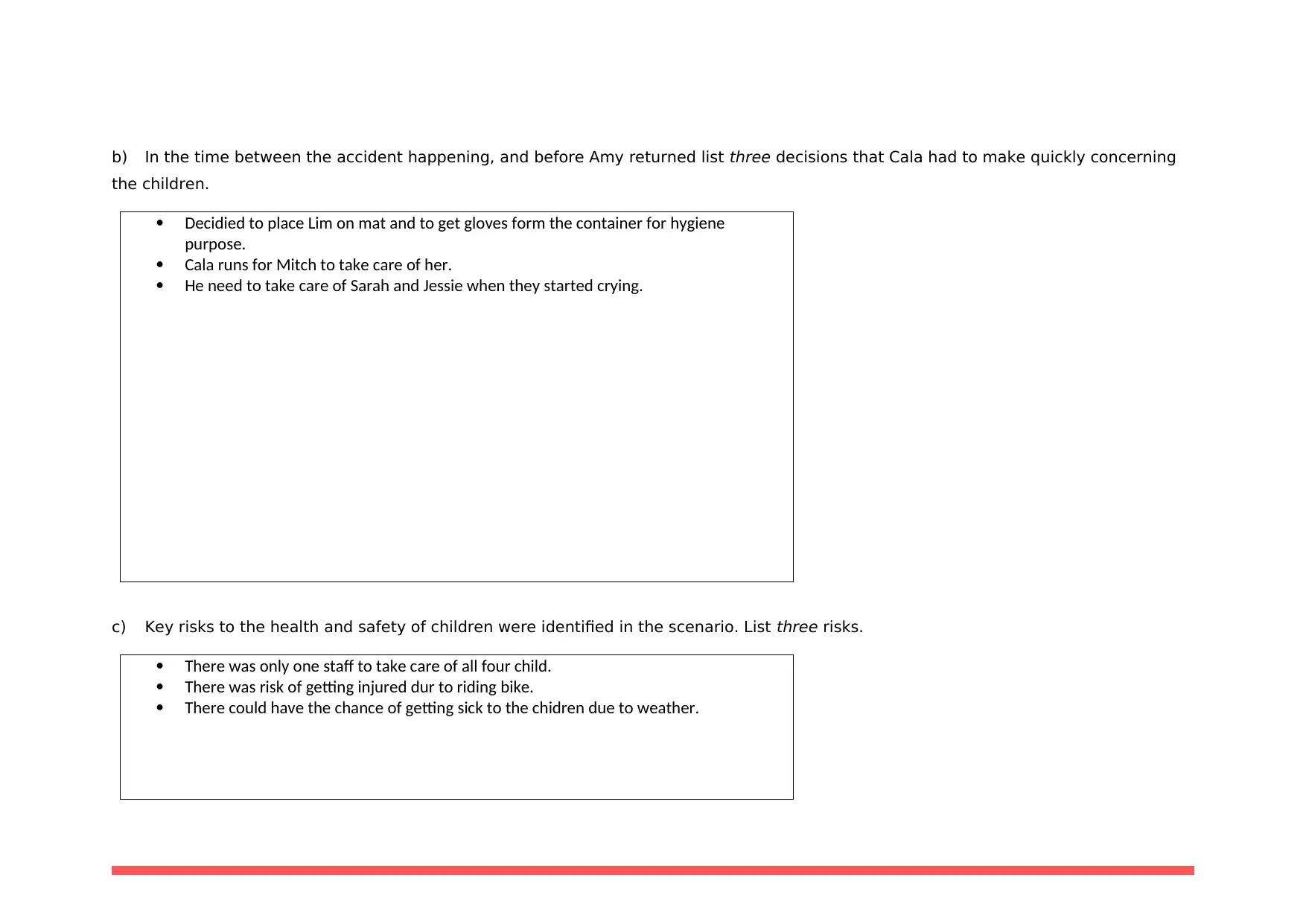
b) In the time between the accident happening, and before Amy returned list three decisions that Cala had to make quickly concerning
the children.
Decidied to place Lim on mat and to get gloves form the container for hygiene
purpose.
Cala runs for Mitch to take care of her.
He need to take care of Sarah and Jessie when they started crying.
c) Key risks to the health and safety of children were identified in the scenario. List three risks.
There was only one staff to take care of all four child.
There was risk of getting injured dur to riding bike.
There could have the chance of getting sick to the chidren due to weather.
the children.
Decidied to place Lim on mat and to get gloves form the container for hygiene
purpose.
Cala runs for Mitch to take care of her.
He need to take care of Sarah and Jessie when they started crying.
c) Key risks to the health and safety of children were identified in the scenario. List three risks.
There was only one staff to take care of all four child.
There was risk of getting injured dur to riding bike.
There could have the chance of getting sick to the chidren due to weather.
Paraphrase This Document
Need a fresh take? Get an instant paraphrase of this document with our AI Paraphraser
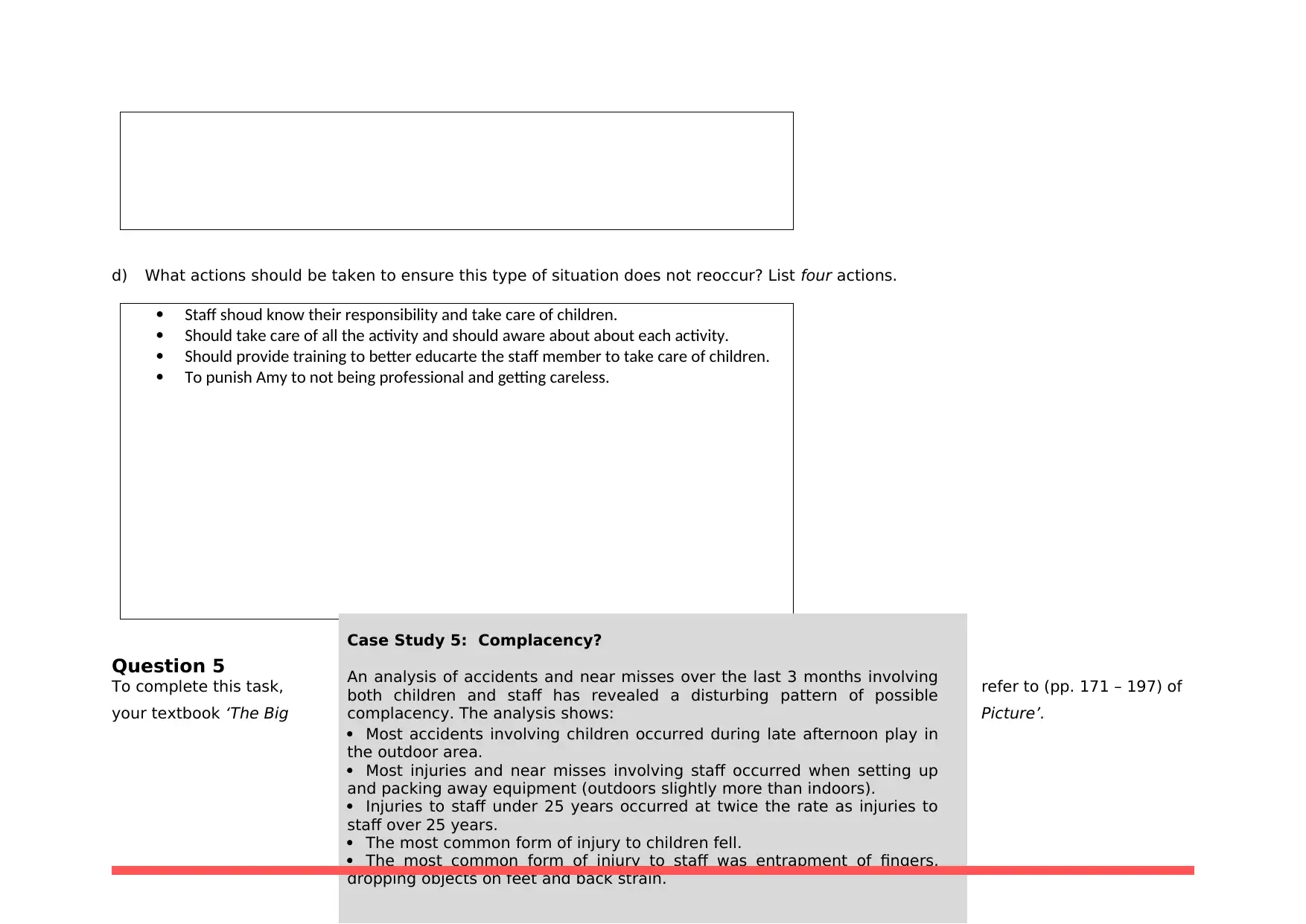
d) What actions should be taken to ensure this type of situation does not reoccur? List four actions.
Staff shoud know their responsibility and take care of children.
Should take care of all the activity and should aware about about each activity.
Should provide training to better educarte the staff member to take care of children.
To punish Amy to not being professional and getting careless.
Question 5
To complete this task, refer to (pp. 171 – 197) of
your textbook ‘The Big Picture’.
Case Study 5: Complacency?
An analysis of accidents and near misses over the last 3 months involving
both children and staff has revealed a disturbing pattern of possible
complacency. The analysis shows:
Most accidents involving children occurred during late afternoon play in
the outdoor area.
Most injuries and near misses involving staff occurred when setting up
and packing away equipment (outdoors slightly more than indoors).
Injuries to staff under 25 years occurred at twice the rate as injuries to
staff over 25 years.
The most common form of injury to children fell.
The most common form of injury to staff was entrapment of fingers,
dropping objects on feet and back strain.
Staff shoud know their responsibility and take care of children.
Should take care of all the activity and should aware about about each activity.
Should provide training to better educarte the staff member to take care of children.
To punish Amy to not being professional and getting careless.
Question 5
To complete this task, refer to (pp. 171 – 197) of
your textbook ‘The Big Picture’.
Case Study 5: Complacency?
An analysis of accidents and near misses over the last 3 months involving
both children and staff has revealed a disturbing pattern of possible
complacency. The analysis shows:
Most accidents involving children occurred during late afternoon play in
the outdoor area.
Most injuries and near misses involving staff occurred when setting up
and packing away equipment (outdoors slightly more than indoors).
Injuries to staff under 25 years occurred at twice the rate as injuries to
staff over 25 years.
The most common form of injury to children fell.
The most common form of injury to staff was entrapment of fingers,
dropping objects on feet and back strain.
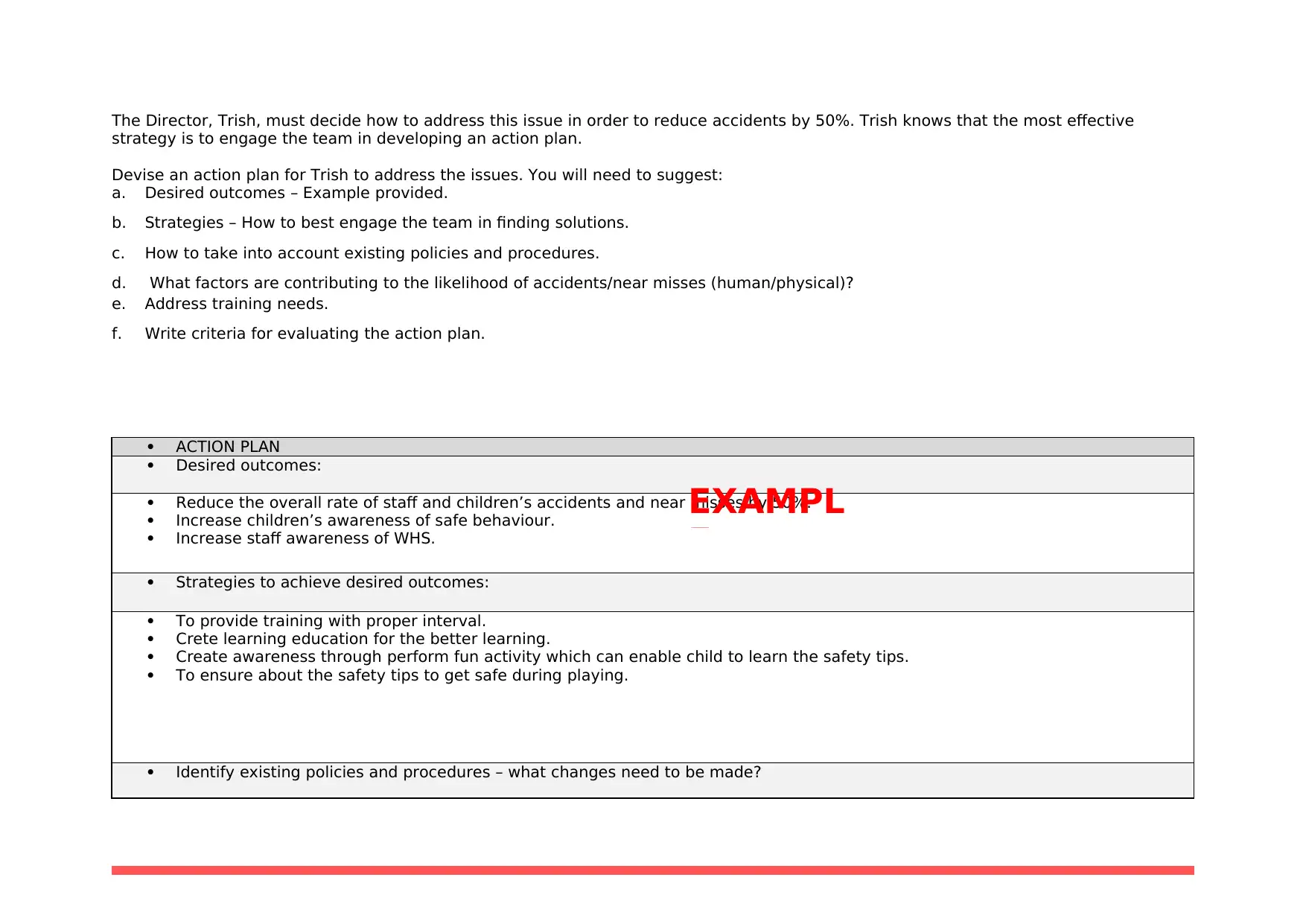
The Director, Trish, must decide how to address this issue in order to reduce accidents by 50%. Trish knows that the most effective
strategy is to engage the team in developing an action plan.
Devise an action plan for Trish to address the issues. You will need to suggest:
a. Desired outcomes – Example provided.
b. Strategies – How to best engage the team in finding solutions.
c. How to take into account existing policies and procedures.
d. What factors are contributing to the likelihood of accidents/near misses (human/physical)?
e. Address training needs.
f. Write criteria for evaluating the action plan.
ACTION PLAN
Desired outcomes:
Reduce the overall rate of staff and children’s accidents and near misses by 50%.
Increase children’s awareness of safe behaviour.
Increase staff awareness of WHS.
Strategies to achieve desired outcomes:
To provide training with proper interval.
Crete learning education for the better learning.
Create awareness through perform fun activity which can enable child to learn the safety tips.
To ensure about the safety tips to get safe during playing.
Identify existing policies and procedures – what changes need to be made?
EXAMPL
E
strategy is to engage the team in developing an action plan.
Devise an action plan for Trish to address the issues. You will need to suggest:
a. Desired outcomes – Example provided.
b. Strategies – How to best engage the team in finding solutions.
c. How to take into account existing policies and procedures.
d. What factors are contributing to the likelihood of accidents/near misses (human/physical)?
e. Address training needs.
f. Write criteria for evaluating the action plan.
ACTION PLAN
Desired outcomes:
Reduce the overall rate of staff and children’s accidents and near misses by 50%.
Increase children’s awareness of safe behaviour.
Increase staff awareness of WHS.
Strategies to achieve desired outcomes:
To provide training with proper interval.
Crete learning education for the better learning.
Create awareness through perform fun activity which can enable child to learn the safety tips.
To ensure about the safety tips to get safe during playing.
Identify existing policies and procedures – what changes need to be made?
EXAMPL
E
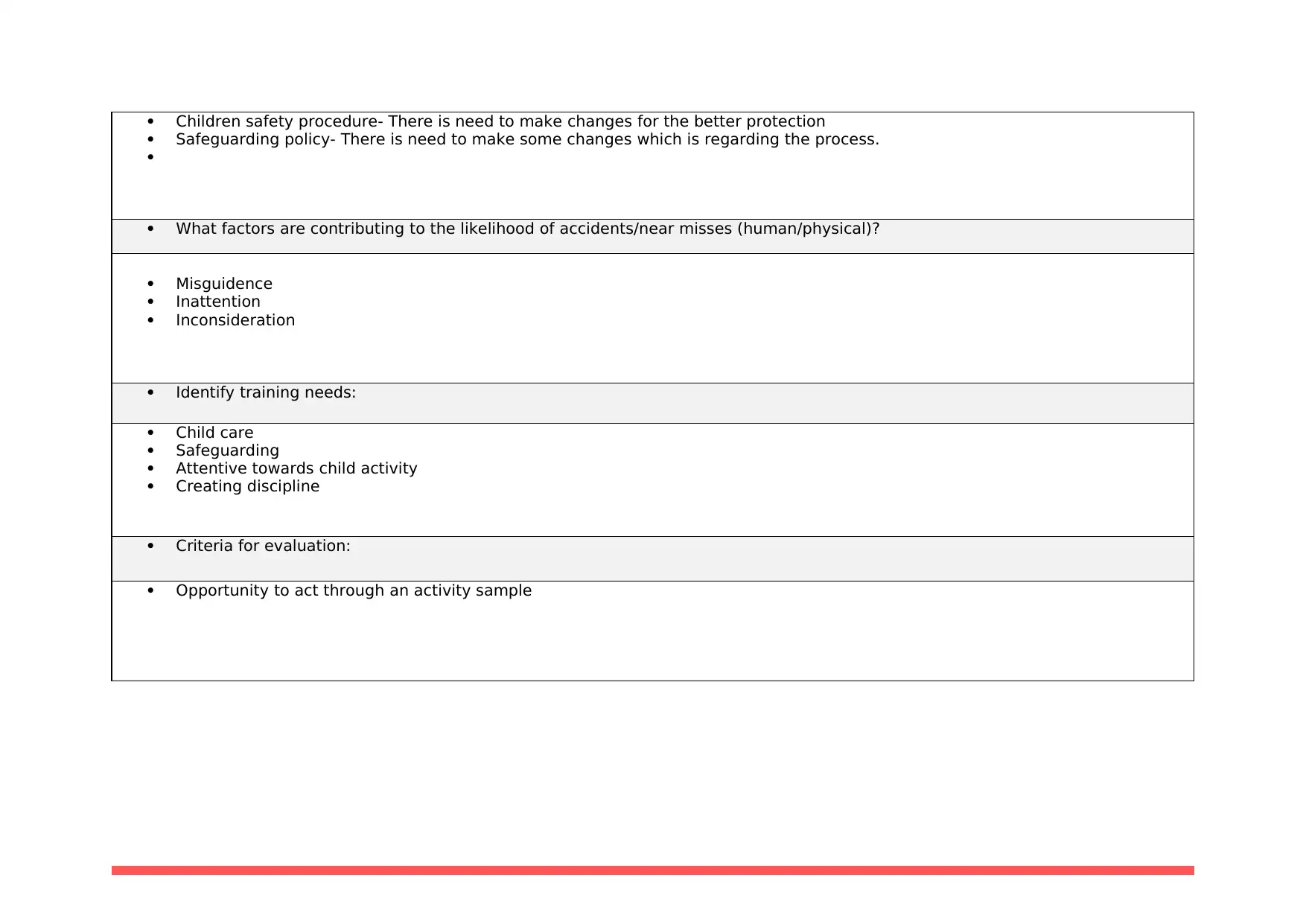
Children safety procedure- There is need to make changes for the better protection
Safeguarding policy- There is need to make some changes which is regarding the process.
What factors are contributing to the likelihood of accidents/near misses (human/physical)?
Misguidence
Inattention
Inconsideration
Identify training needs:
Child care
Safeguarding
Attentive towards child activity
Creating discipline
Criteria for evaluation:
Opportunity to act through an activity sample
Safeguarding policy- There is need to make some changes which is regarding the process.
What factors are contributing to the likelihood of accidents/near misses (human/physical)?
Misguidence
Inattention
Inconsideration
Identify training needs:
Child care
Safeguarding
Attentive towards child activity
Creating discipline
Criteria for evaluation:
Opportunity to act through an activity sample
Secure Best Marks with AI Grader
Need help grading? Try our AI Grader for instant feedback on your assignments.

Question 6
To complete this task refer to (p.99) of your textbook
‘The Big Picture’.
Using the information provided in the scenario
complete a WHS incident notification on the
following form.
Scenario: Gina
Gina (38 years) is a happy and energetic Diploma trained educator. She thinks
that some of the policies and procedures concerning WHS are ‘way over the
top’. Gina has worked in child care for 15 years and has never had a ‘real’
accident; however, she has had lots of near misses!
Gina is employed as a senior educator at Blue Bay Early Learning Centre, 111
Blue Bay Rd, Blue Bay.
Gina thinks it is a waste of time having to use a stepladder or waiting
around for someone to help lift bulky items. Gina usually stands on a
plastic crate to reach the higher shelves in the outdoor storeroom. She
argues that it is more convenient and more comfortable to access than
the stepladder. Yesterday (Tuesday 27th March at 8. 20 am) Gina was
standing on a crate so that she could access a basket of plastic dinosaurs
when it gave way. Gina fell backwards, badly bruising her shoulder and
hip and breaking her ankle.
Tom Smith, another Diploma educator, was just outside the storage shed when
the accident occurred. He applied immediate first aid by making Gina as
comfortable as possible without moving her, calling an ambulance, and icing her
ankle.
Gina was taken to the local public hospital- she required an operation to place a
pin in her ankle and will be off work for at least eight weeks.
Incident Notification Form
What happened
Provide an overview of what happened.
Nominate the type of notifiable incident—
death, serious injury or illness, or
‘dangerous incident’
Overview of Incident: She felt out
form the crate which creates more
damage to her.
Type of Notifiable Incident: Not
using stepladder.
When did it happen
Date and time
Date: Incident Occurred: 27th
March
Time Incident Occurred: 8:20 am
Where did it happen
Incident address. Details of the specific
location of the incident
Address where Incident Occurred:
Blue Bay Early Learning Centre
Location of Incident: 111 Blue Bay
Rd, Blue Bay
What happened: detailed description Due to not using the stepladder,
there was the case of fall which
creates the case of serious injury
in her feet which needs better
treatment.
Who did it happen to
Injured person’s name, date of birth,
address and contact number.
Injured person’s occupation.
Relationship of the injured person to the
entity notifying.
Name: Mrs Gina Smith
D.O.B 9/7/1975
Address: 15 Grace Avenue Blue
Bay
Contact: 0462xxxxxx
Occupation: senior educator
Relationship: Educator
How and where are they being treated (if
applicable)
Description of serious injury or illness—i.e.
nature of injury
Initial treatment of serious injury or illness.
Where the patient has been taken for
treatment.
Description of injury/illness: badly
bruising her shoulder and hip and
breaking her ankle
Initial Treatment: icing her ankle
Further Treatment: treatment in
hospital
Who is the person conducting the business
or undertaking (there may be more than
one)
Legal and Trading Name: Blue Bay
Early Learning Centre Pty Ltd.
ABN: 6750340189
To complete this task refer to (p.99) of your textbook
‘The Big Picture’.
Using the information provided in the scenario
complete a WHS incident notification on the
following form.
Scenario: Gina
Gina (38 years) is a happy and energetic Diploma trained educator. She thinks
that some of the policies and procedures concerning WHS are ‘way over the
top’. Gina has worked in child care for 15 years and has never had a ‘real’
accident; however, she has had lots of near misses!
Gina is employed as a senior educator at Blue Bay Early Learning Centre, 111
Blue Bay Rd, Blue Bay.
Gina thinks it is a waste of time having to use a stepladder or waiting
around for someone to help lift bulky items. Gina usually stands on a
plastic crate to reach the higher shelves in the outdoor storeroom. She
argues that it is more convenient and more comfortable to access than
the stepladder. Yesterday (Tuesday 27th March at 8. 20 am) Gina was
standing on a crate so that she could access a basket of plastic dinosaurs
when it gave way. Gina fell backwards, badly bruising her shoulder and
hip and breaking her ankle.
Tom Smith, another Diploma educator, was just outside the storage shed when
the accident occurred. He applied immediate first aid by making Gina as
comfortable as possible without moving her, calling an ambulance, and icing her
ankle.
Gina was taken to the local public hospital- she required an operation to place a
pin in her ankle and will be off work for at least eight weeks.
Incident Notification Form
What happened
Provide an overview of what happened.
Nominate the type of notifiable incident—
death, serious injury or illness, or
‘dangerous incident’
Overview of Incident: She felt out
form the crate which creates more
damage to her.
Type of Notifiable Incident: Not
using stepladder.
When did it happen
Date and time
Date: Incident Occurred: 27th
March
Time Incident Occurred: 8:20 am
Where did it happen
Incident address. Details of the specific
location of the incident
Address where Incident Occurred:
Blue Bay Early Learning Centre
Location of Incident: 111 Blue Bay
Rd, Blue Bay
What happened: detailed description Due to not using the stepladder,
there was the case of fall which
creates the case of serious injury
in her feet which needs better
treatment.
Who did it happen to
Injured person’s name, date of birth,
address and contact number.
Injured person’s occupation.
Relationship of the injured person to the
entity notifying.
Name: Mrs Gina Smith
D.O.B 9/7/1975
Address: 15 Grace Avenue Blue
Bay
Contact: 0462xxxxxx
Occupation: senior educator
Relationship: Educator
How and where are they being treated (if
applicable)
Description of serious injury or illness—i.e.
nature of injury
Initial treatment of serious injury or illness.
Where the patient has been taken for
treatment.
Description of injury/illness: badly
bruising her shoulder and hip and
breaking her ankle
Initial Treatment: icing her ankle
Further Treatment: treatment in
hospital
Who is the person conducting the business
or undertaking (there may be more than
one)
Legal and Trading Name: Blue Bay
Early Learning Centre Pty Ltd.
ABN: 6750340189
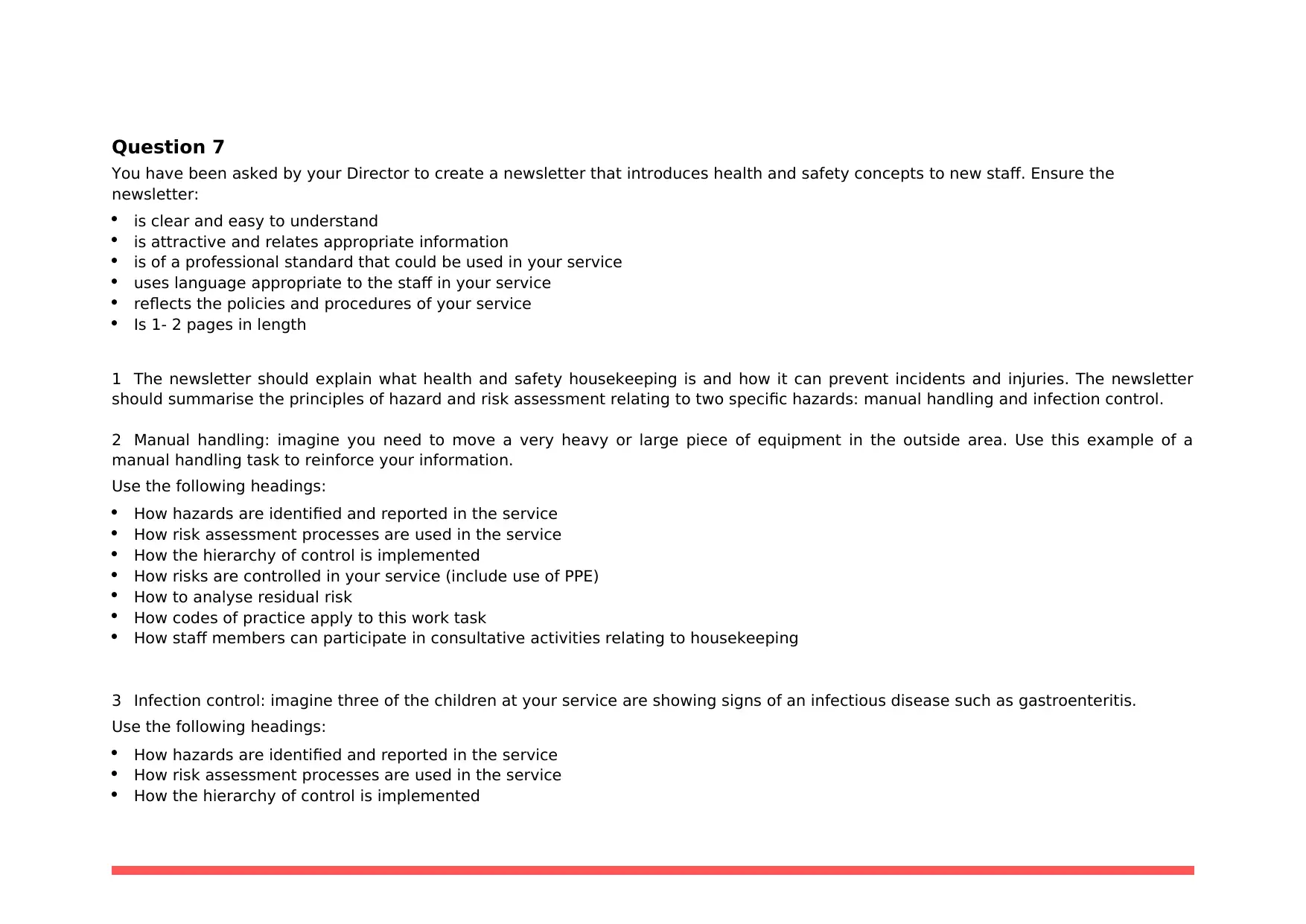
Question 7
You have been asked by your Director to create a newsletter that introduces health and safety concepts to new staff. Ensure the
newsletter:
is clear and easy to understand
is attractive and relates appropriate information
is of a professional standard that could be used in your service
uses language appropriate to the staff in your service
reflects the policies and procedures of your service
Is 1- 2 pages in length
1 The newsletter should explain what health and safety housekeeping is and how it can prevent incidents and injuries. The newsletter
should summarise the principles of hazard and risk assessment relating to two specific hazards: manual handling and infection control.
2 Manual handling: imagine you need to move a very heavy or large piece of equipment in the outside area. Use this example of a
manual handling task to reinforce your information.
Use the following headings:
How hazards are identified and reported in the service
How risk assessment processes are used in the service
How the hierarchy of control is implemented
How risks are controlled in your service (include use of PPE)
How to analyse residual risk
How codes of practice apply to this work task
How staff members can participate in consultative activities relating to housekeeping
3 Infection control: imagine three of the children at your service are showing signs of an infectious disease such as gastroenteritis.
Use the following headings:
How hazards are identified and reported in the service
How risk assessment processes are used in the service
How the hierarchy of control is implemented
You have been asked by your Director to create a newsletter that introduces health and safety concepts to new staff. Ensure the
newsletter:
is clear and easy to understand
is attractive and relates appropriate information
is of a professional standard that could be used in your service
uses language appropriate to the staff in your service
reflects the policies and procedures of your service
Is 1- 2 pages in length
1 The newsletter should explain what health and safety housekeeping is and how it can prevent incidents and injuries. The newsletter
should summarise the principles of hazard and risk assessment relating to two specific hazards: manual handling and infection control.
2 Manual handling: imagine you need to move a very heavy or large piece of equipment in the outside area. Use this example of a
manual handling task to reinforce your information.
Use the following headings:
How hazards are identified and reported in the service
How risk assessment processes are used in the service
How the hierarchy of control is implemented
How risks are controlled in your service (include use of PPE)
How to analyse residual risk
How codes of practice apply to this work task
How staff members can participate in consultative activities relating to housekeeping
3 Infection control: imagine three of the children at your service are showing signs of an infectious disease such as gastroenteritis.
Use the following headings:
How hazards are identified and reported in the service
How risk assessment processes are used in the service
How the hierarchy of control is implemented
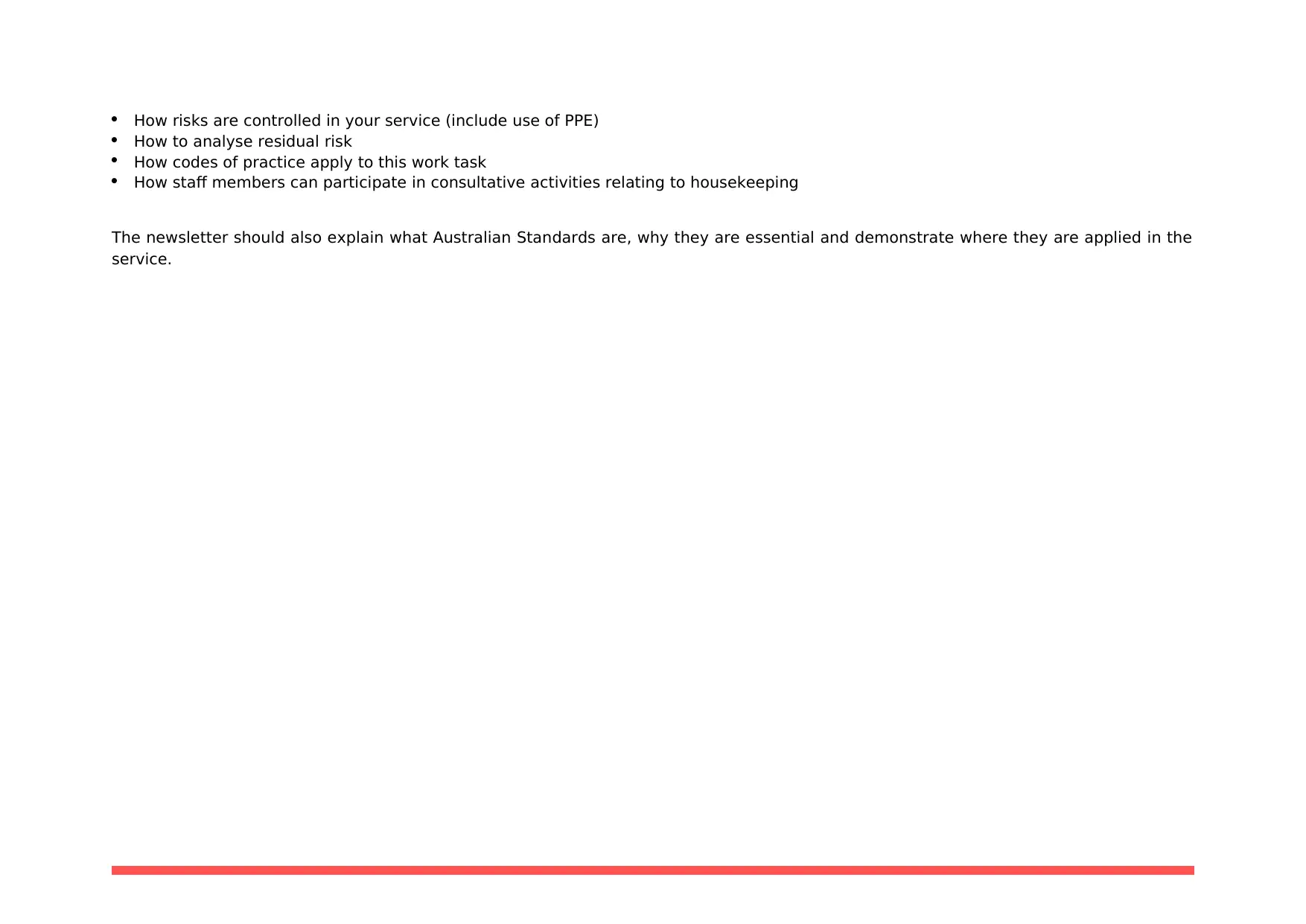
How risks are controlled in your service (include use of PPE)
How to analyse residual risk
How codes of practice apply to this work task
How staff members can participate in consultative activities relating to housekeeping
The newsletter should also explain what Australian Standards are, why they are essential and demonstrate where they are applied in the
service.
How to analyse residual risk
How codes of practice apply to this work task
How staff members can participate in consultative activities relating to housekeeping
The newsletter should also explain what Australian Standards are, why they are essential and demonstrate where they are applied in the
service.
Paraphrase This Document
Need a fresh take? Get an instant paraphrase of this document with our AI Paraphraser
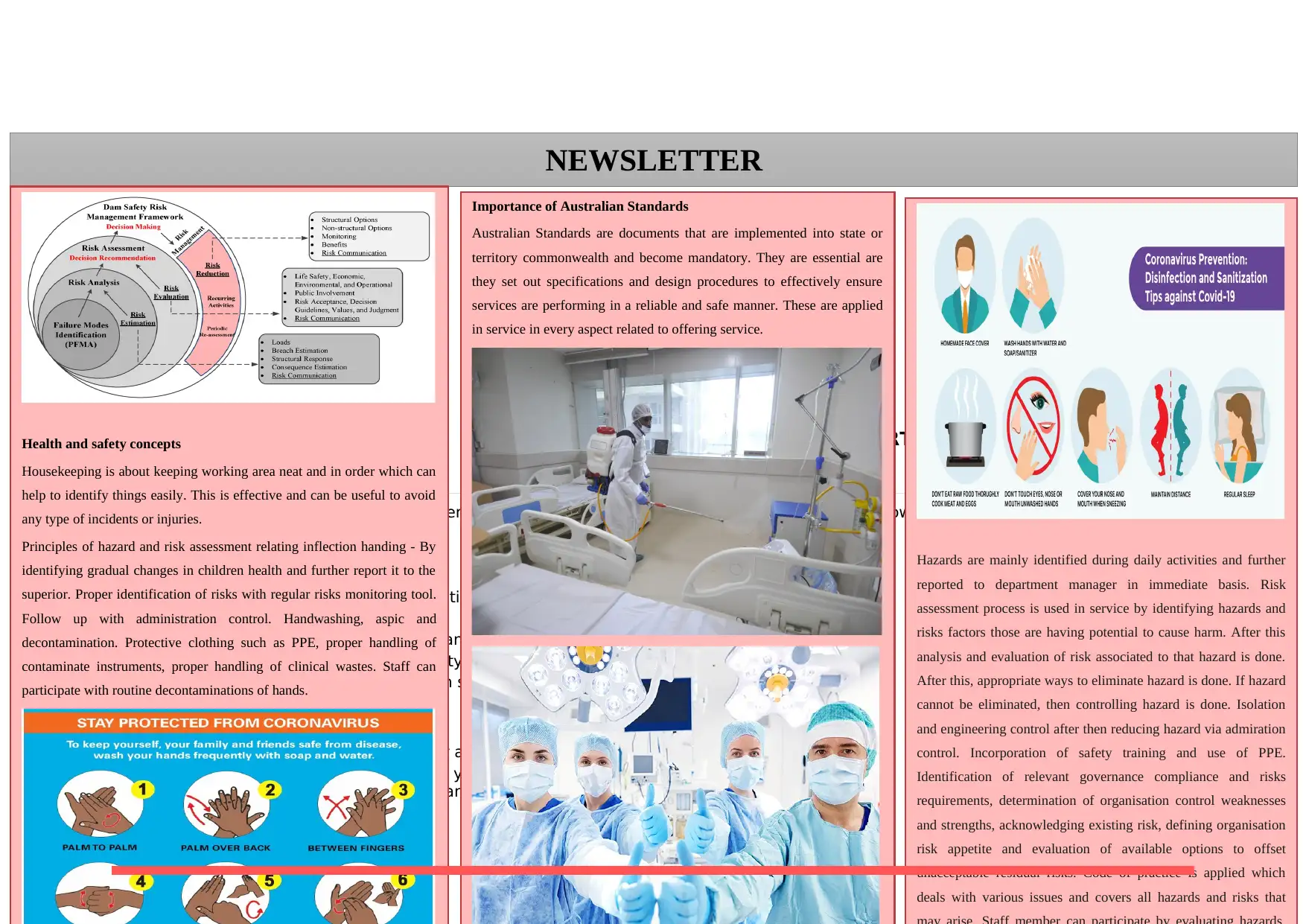
\
PART C: IN-CLASS SIMULATIONS
TASK SUMMARY
This assessment task has 4 simulations where you are demonstrating evidence of your skills and knowledge in a simulated working
environment.
Purpose of task
To progress towards demonstrating application and competency in the units:
CHCECE016 Establish and maintain a safe and healthy environment for children
HLTWHS003 Maintain work health and safety
CHCECE025 Embed sustainable practices in service operations
Criteria
The assessment task will demonstrate your ability to:
Understand the topics related to the units you are studying
Apply theoretical information you have learnt to practical application
Hazards are mainly identified during daily activities and further
reported to department manager in immediate basis. Risk
assessment process is used in service by identifying hazards and
risks factors those are having potential to cause harm. After this
analysis and evaluation of risk associated to that hazard is done.
After this, appropriate ways to eliminate hazard is done. If hazard
cannot be eliminated, then controlling hazard is done. Isolation
and engineering control after then reducing hazard via admiration
control. Incorporation of safety training and use of PPE.
Identification of relevant governance compliance and risks
requirements, determination of organisation control weaknesses
and strengths, acknowledging existing risk, defining organisation
risk appetite and evaluation of available options to offset
unacceptable residual risks. Code of practice is applied which
deals with various issues and covers all hazards and risks that
Importance of Australian Standards
Australian Standards are documents that are implemented into state or
territory commonwealth and become mandatory. They are essential are
they set out specifications and design procedures to effectively ensure
services are performing in a reliable and safe manner. These are applied
in service in every aspect related to offering service.
NEWSLETTER
Health and safety concepts
Housekeeping is about keeping working area neat and in order which can
help to identify things easily. This is effective and can be useful to avoid
any type of incidents or injuries.
Principles of hazard and risk assessment relating inflection handing - By
identifying gradual changes in children health and further report it to the
superior. Proper identification of risks with regular risks monitoring tool.
Follow up with administration control. Handwashing, aspic and
decontamination. Protective clothing such as PPE, proper handling of
contaminate instruments, proper handling of clinical wastes. Staff can
participate with routine decontaminations of hands.
PART C: IN-CLASS SIMULATIONS
TASK SUMMARY
This assessment task has 4 simulations where you are demonstrating evidence of your skills and knowledge in a simulated working
environment.
Purpose of task
To progress towards demonstrating application and competency in the units:
CHCECE016 Establish and maintain a safe and healthy environment for children
HLTWHS003 Maintain work health and safety
CHCECE025 Embed sustainable practices in service operations
Criteria
The assessment task will demonstrate your ability to:
Understand the topics related to the units you are studying
Apply theoretical information you have learnt to practical application
Hazards are mainly identified during daily activities and further
reported to department manager in immediate basis. Risk
assessment process is used in service by identifying hazards and
risks factors those are having potential to cause harm. After this
analysis and evaluation of risk associated to that hazard is done.
After this, appropriate ways to eliminate hazard is done. If hazard
cannot be eliminated, then controlling hazard is done. Isolation
and engineering control after then reducing hazard via admiration
control. Incorporation of safety training and use of PPE.
Identification of relevant governance compliance and risks
requirements, determination of organisation control weaknesses
and strengths, acknowledging existing risk, defining organisation
risk appetite and evaluation of available options to offset
unacceptable residual risks. Code of practice is applied which
deals with various issues and covers all hazards and risks that
Importance of Australian Standards
Australian Standards are documents that are implemented into state or
territory commonwealth and become mandatory. They are essential are
they set out specifications and design procedures to effectively ensure
services are performing in a reliable and safe manner. These are applied
in service in every aspect related to offering service.
NEWSLETTER
Health and safety concepts
Housekeeping is about keeping working area neat and in order which can
help to identify things easily. This is effective and can be useful to avoid
any type of incidents or injuries.
Principles of hazard and risk assessment relating inflection handing - By
identifying gradual changes in children health and further report it to the
superior. Proper identification of risks with regular risks monitoring tool.
Follow up with administration control. Handwashing, aspic and
decontamination. Protective clothing such as PPE, proper handling of
contaminate instruments, proper handling of clinical wastes. Staff can
participate with routine decontaminations of hands.

Assessment task
For this assessment, you are to answer the questions related to the following simulations.
Assessment conditions
The following tasks have been created to assess your skills and knowledge.
You will need to read and follow all instructions carefully
Complete each simulation in full
Each answer should be no more than 3 paragraphs or go for more than 5 minutes
For this assessment, you are to answer the questions related to the following simulations.
Assessment conditions
The following tasks have been created to assess your skills and knowledge.
You will need to read and follow all instructions carefully
Complete each simulation in full
Each answer should be no more than 3 paragraphs or go for more than 5 minutes

Task 1: Role Play Administration of medicine
Introduction
Families place a high level of trust and responsibility on staff when administering medication to children and must feel confident that the
process is carried out responsibly. Staff must also feel they are protected against any possibility that instructions have been
misunderstood.
Objective:
To demonstrate that you can administer medicine according to policy and procedure.
Instructions:
1. Access a procedure for:
• Administration of medicine
2. Administer medicine to at least one child (student) in order for your assessor to observe you
Your assessor will document this activity and will use the list below as a checklist to make sure that you are performing the task properly.
They want to see that you can
ensure that individual medical management plans for children with a specific health care need are in place and readily available at the
service
promote and monitor safety practices including administration of medicine
In this, selected child is enroled and being comfortable before medication and asked other staff member to present as the evidence of the
performance. There is recording of all detail where before administration medication is confirmed about the correctnees by its name and
ensure about its expiry date. It should be ensure about washed hand before and after medication.
Introduction
Families place a high level of trust and responsibility on staff when administering medication to children and must feel confident that the
process is carried out responsibly. Staff must also feel they are protected against any possibility that instructions have been
misunderstood.
Objective:
To demonstrate that you can administer medicine according to policy and procedure.
Instructions:
1. Access a procedure for:
• Administration of medicine
2. Administer medicine to at least one child (student) in order for your assessor to observe you
Your assessor will document this activity and will use the list below as a checklist to make sure that you are performing the task properly.
They want to see that you can
ensure that individual medical management plans for children with a specific health care need are in place and readily available at the
service
promote and monitor safety practices including administration of medicine
In this, selected child is enroled and being comfortable before medication and asked other staff member to present as the evidence of the
performance. There is recording of all detail where before administration medication is confirmed about the correctnees by its name and
ensure about its expiry date. It should be ensure about washed hand before and after medication.
Secure Best Marks with AI Grader
Need help grading? Try our AI Grader for instant feedback on your assignments.
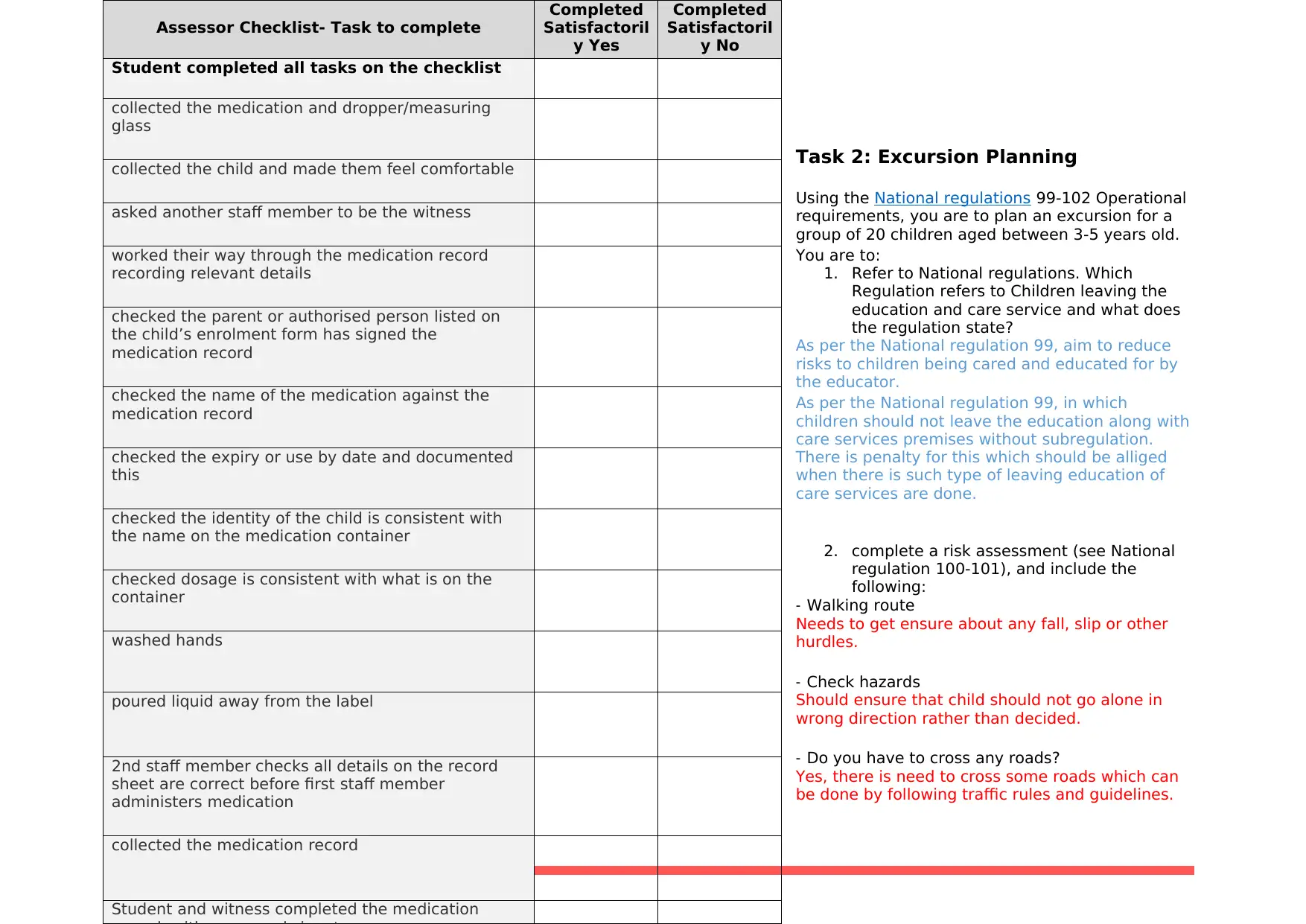
Task 2: Excursion Planning
Using the National regulations 99-102 Operational
requirements, you are to plan an excursion for a
group of 20 children aged between 3-5 years old.
You are to:
1. Refer to National regulations. Which
Regulation refers to Children leaving the
education and care service and what does
the regulation state?
As per the National regulation 99, aim to reduce
risks to children being cared and educated for by
the educator.
As per the National regulation 99, in which
children should not leave the education along with
care services premises without subregulation.
There is penalty for this which should be alliged
when there is such type of leaving education of
care services are done.
2. complete a risk assessment (see National
regulation 100-101), and include the
following:
- Walking route
Needs to get ensure about any fall, slip or other
hurdles.
- Check hazards
Should ensure that child should not go alone in
wrong direction rather than decided.
- Do you have to cross any roads?
Yes, there is need to cross some roads which can
be done by following traffic rules and guidelines.
Assessor Checklist- Task to complete
Completed
Satisfactoril
y Yes
Completed
Satisfactoril
y No
Student completed all tasks on the checklist
collected the medication and dropper/measuring
glass
collected the child and made them feel comfortable
asked another staff member to be the witness
worked their way through the medication record
recording relevant details
checked the parent or authorised person listed on
the child’s enrolment form has signed the
medication record
checked the name of the medication against the
medication record
checked the expiry or use by date and documented
this
checked the identity of the child is consistent with
the name on the medication container
checked dosage is consistent with what is on the
container
washed hands
poured liquid away from the label
2nd staff member checks all details on the record
sheet are correct before first staff member
administers medication
collected the medication record
Student and witness completed the medication
Using the National regulations 99-102 Operational
requirements, you are to plan an excursion for a
group of 20 children aged between 3-5 years old.
You are to:
1. Refer to National regulations. Which
Regulation refers to Children leaving the
education and care service and what does
the regulation state?
As per the National regulation 99, aim to reduce
risks to children being cared and educated for by
the educator.
As per the National regulation 99, in which
children should not leave the education along with
care services premises without subregulation.
There is penalty for this which should be alliged
when there is such type of leaving education of
care services are done.
2. complete a risk assessment (see National
regulation 100-101), and include the
following:
- Walking route
Needs to get ensure about any fall, slip or other
hurdles.
- Check hazards
Should ensure that child should not go alone in
wrong direction rather than decided.
- Do you have to cross any roads?
Yes, there is need to cross some roads which can
be done by following traffic rules and guidelines.
Assessor Checklist- Task to complete
Completed
Satisfactoril
y Yes
Completed
Satisfactoril
y No
Student completed all tasks on the checklist
collected the medication and dropper/measuring
glass
collected the child and made them feel comfortable
asked another staff member to be the witness
worked their way through the medication record
recording relevant details
checked the parent or authorised person listed on
the child’s enrolment form has signed the
medication record
checked the name of the medication against the
medication record
checked the expiry or use by date and documented
this
checked the identity of the child is consistent with
the name on the medication container
checked dosage is consistent with what is on the
container
washed hands
poured liquid away from the label
2nd staff member checks all details on the record
sheet are correct before first staff member
administers medication
collected the medication record
Student and witness completed the medication
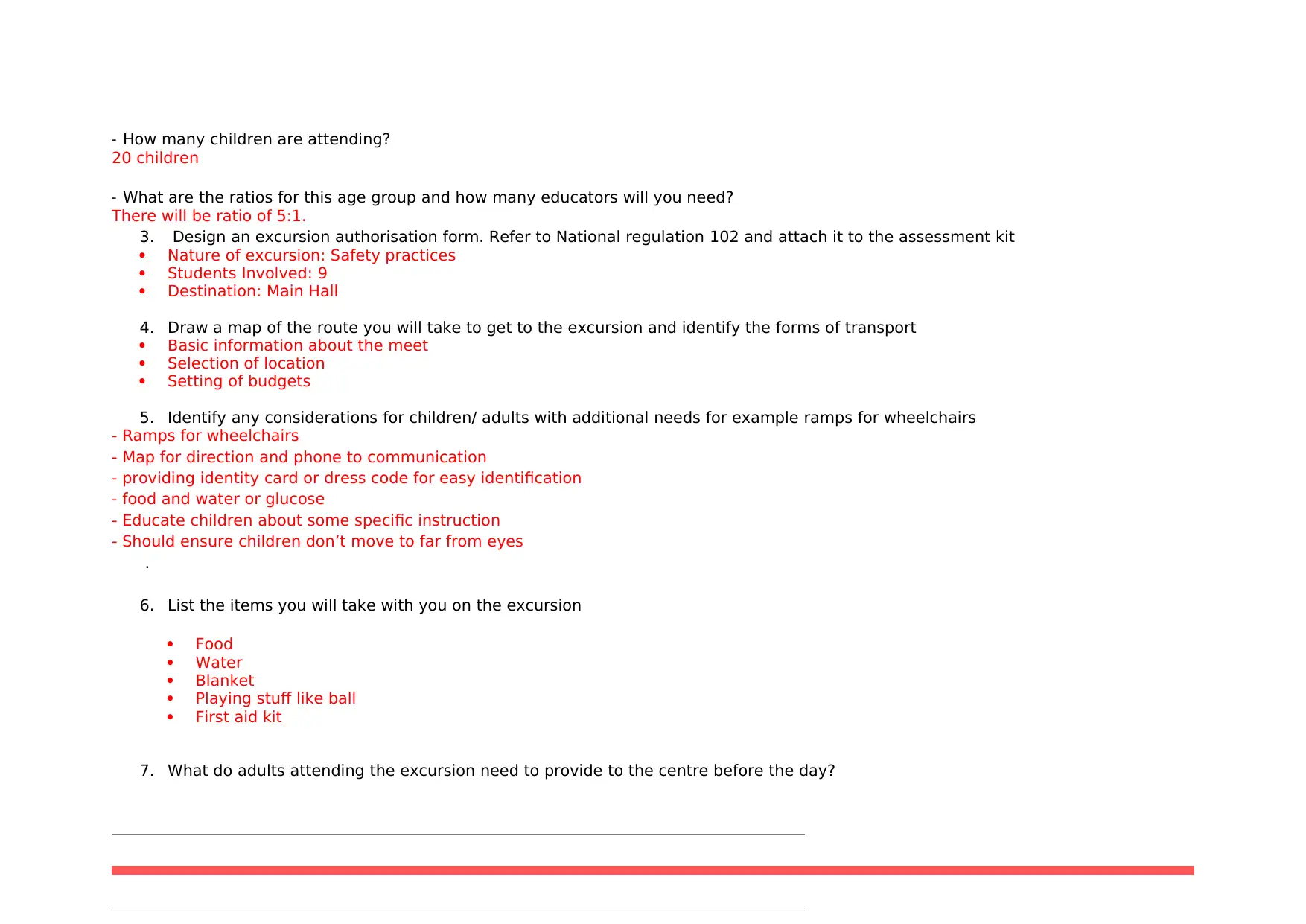
- How many children are attending?
20 children
- What are the ratios for this age group and how many educators will you need?
There will be ratio of 5:1.
3. Design an excursion authorisation form. Refer to National regulation 102 and attach it to the assessment kit
Nature of excursion: Safety practices
Students Involved: 9
Destination: Main Hall
4. Draw a map of the route you will take to get to the excursion and identify the forms of transport
Basic information about the meet
Selection of location
Setting of budgets
5. Identify any considerations for children/ adults with additional needs for example ramps for wheelchairs
- Ramps for wheelchairs
- Map for direction and phone to communication
- providing identity card or dress code for easy identification
- food and water or glucose
- Educate children about some specific instruction
- Should ensure children don’t move to far from eyes
.
6. List the items you will take with you on the excursion
Food
Water
Blanket
Playing stuff like ball
First aid kit
7. What do adults attending the excursion need to provide to the centre before the day?
20 children
- What are the ratios for this age group and how many educators will you need?
There will be ratio of 5:1.
3. Design an excursion authorisation form. Refer to National regulation 102 and attach it to the assessment kit
Nature of excursion: Safety practices
Students Involved: 9
Destination: Main Hall
4. Draw a map of the route you will take to get to the excursion and identify the forms of transport
Basic information about the meet
Selection of location
Setting of budgets
5. Identify any considerations for children/ adults with additional needs for example ramps for wheelchairs
- Ramps for wheelchairs
- Map for direction and phone to communication
- providing identity card or dress code for easy identification
- food and water or glucose
- Educate children about some specific instruction
- Should ensure children don’t move to far from eyes
.
6. List the items you will take with you on the excursion
Food
Water
Blanket
Playing stuff like ball
First aid kit
7. What do adults attending the excursion need to provide to the centre before the day?
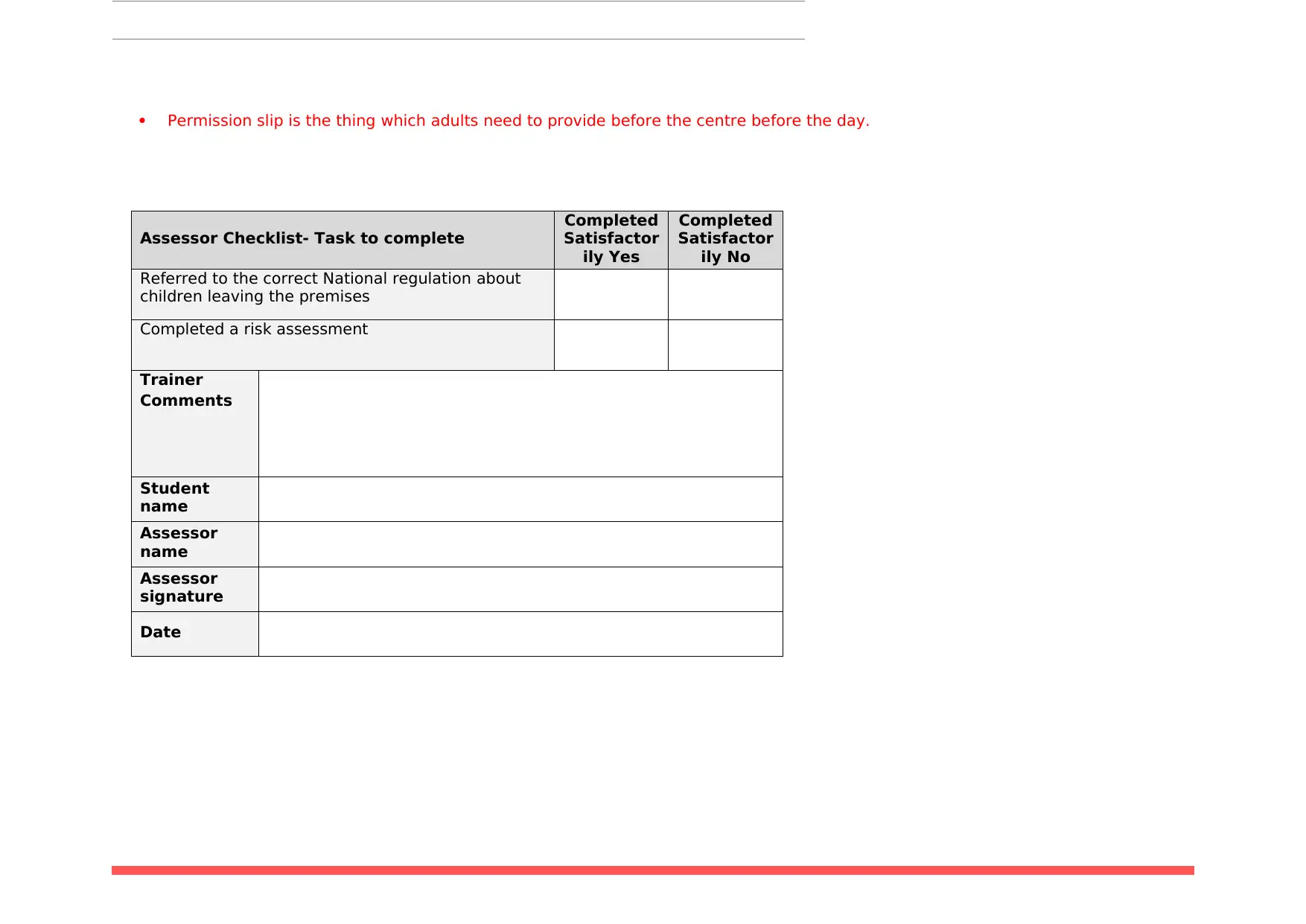
Permission slip is the thing which adults need to provide before the centre before the day.
Assessor Checklist- Task to complete
Completed
Satisfactor
ily Yes
Completed
Satisfactor
ily No
Referred to the correct National regulation about
children leaving the premises
Completed a risk assessment
Trainer
Comments
Student
name
Assessor
name
Assessor
signature
Date
Assessor Checklist- Task to complete
Completed
Satisfactor
ily Yes
Completed
Satisfactor
ily No
Referred to the correct National regulation about
children leaving the premises
Completed a risk assessment
Trainer
Comments
Student
name
Assessor
name
Assessor
signature
Date
1 out of 61
Related Documents
Your All-in-One AI-Powered Toolkit for Academic Success.
+13062052269
info@desklib.com
Available 24*7 on WhatsApp / Email
![[object Object]](/_next/static/media/star-bottom.7253800d.svg)
Unlock your academic potential
© 2024 | Zucol Services PVT LTD | All rights reserved.





